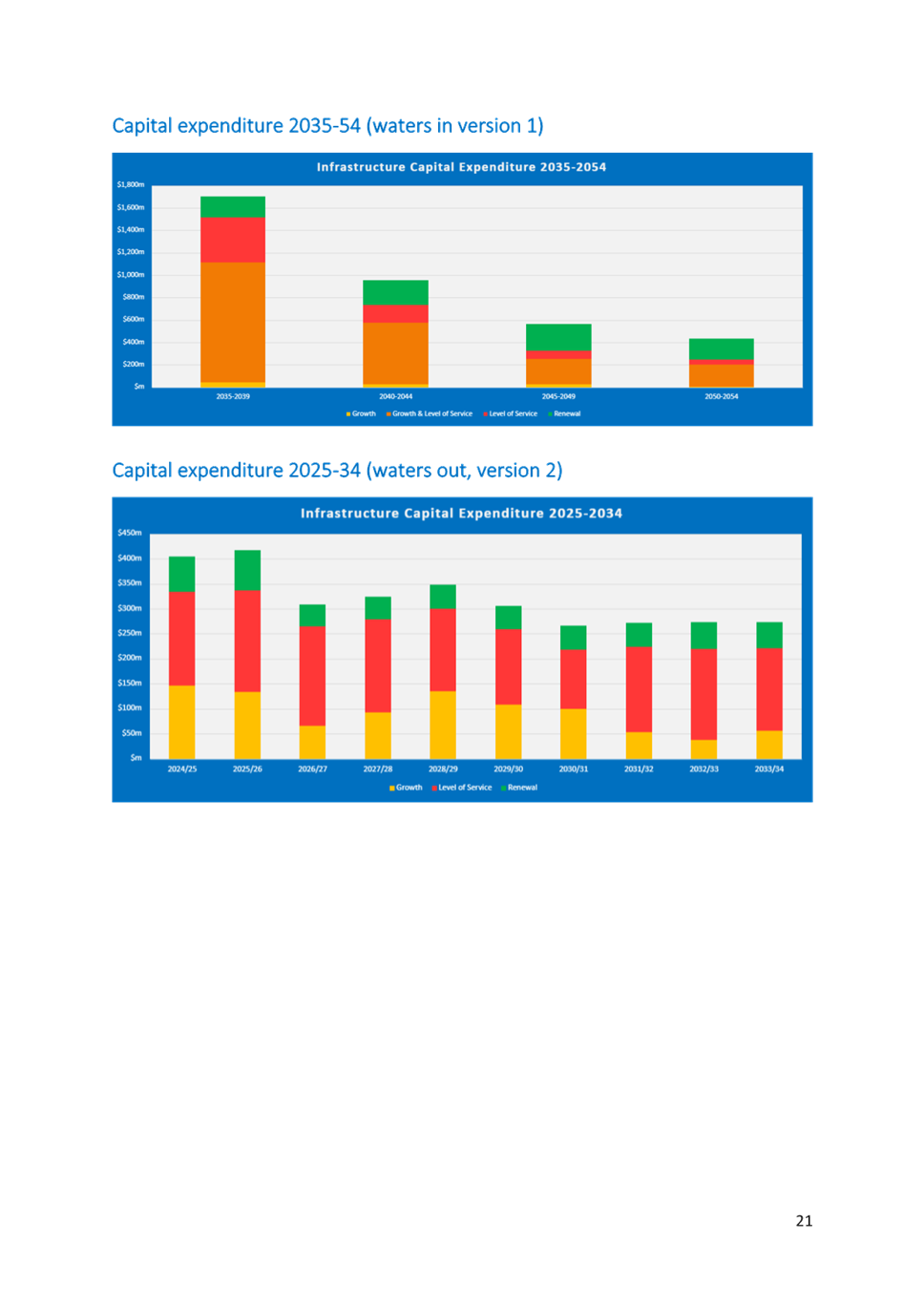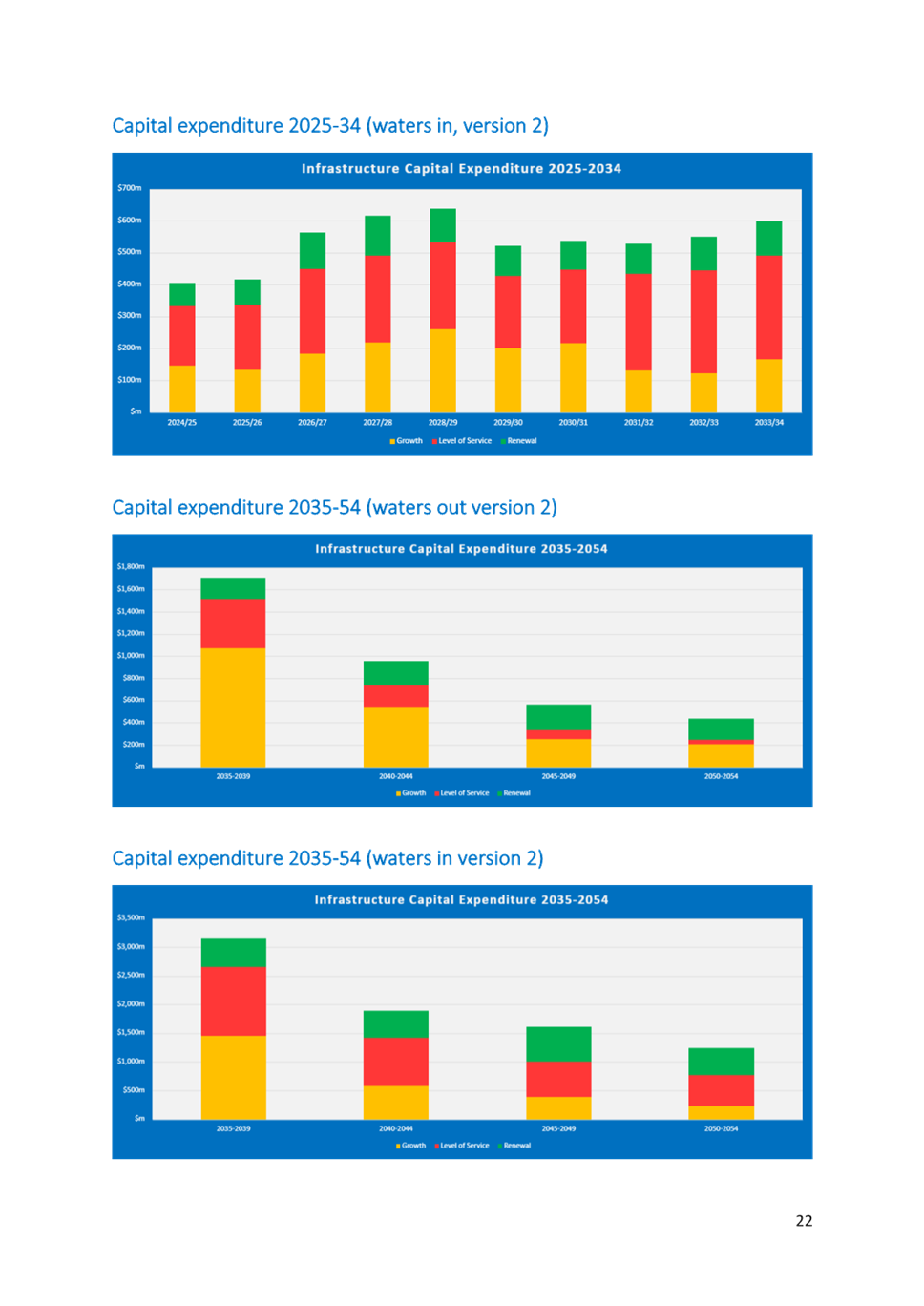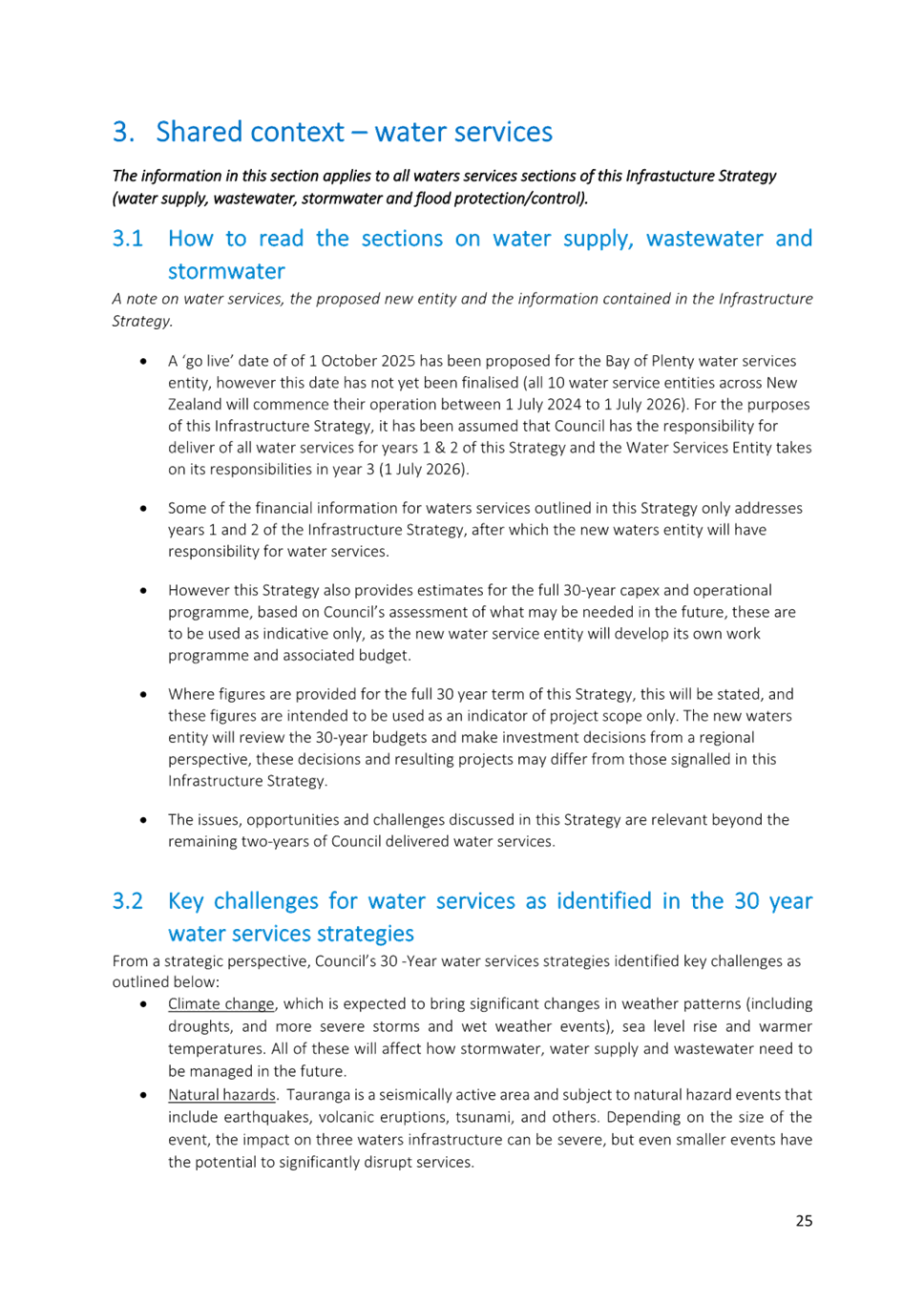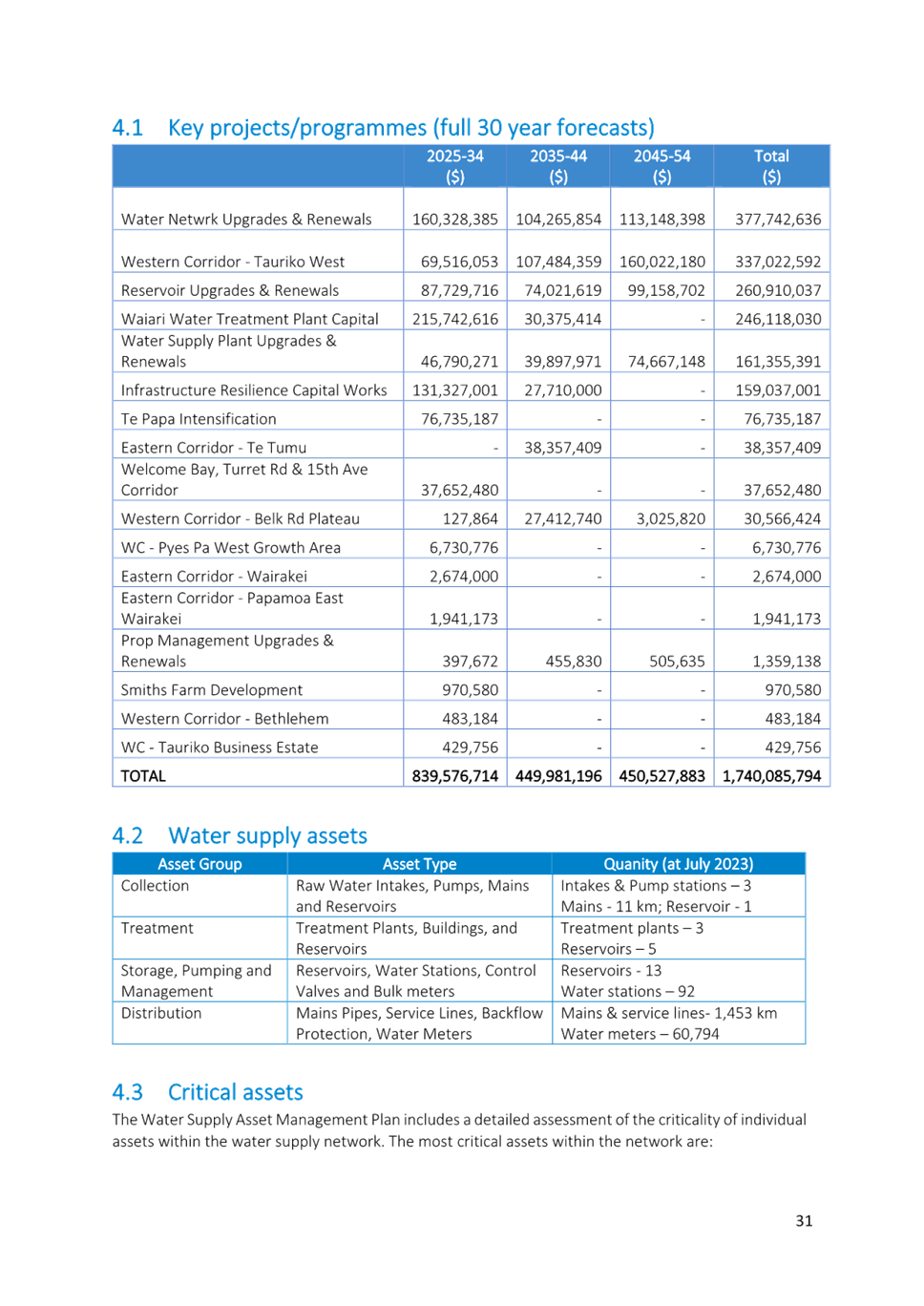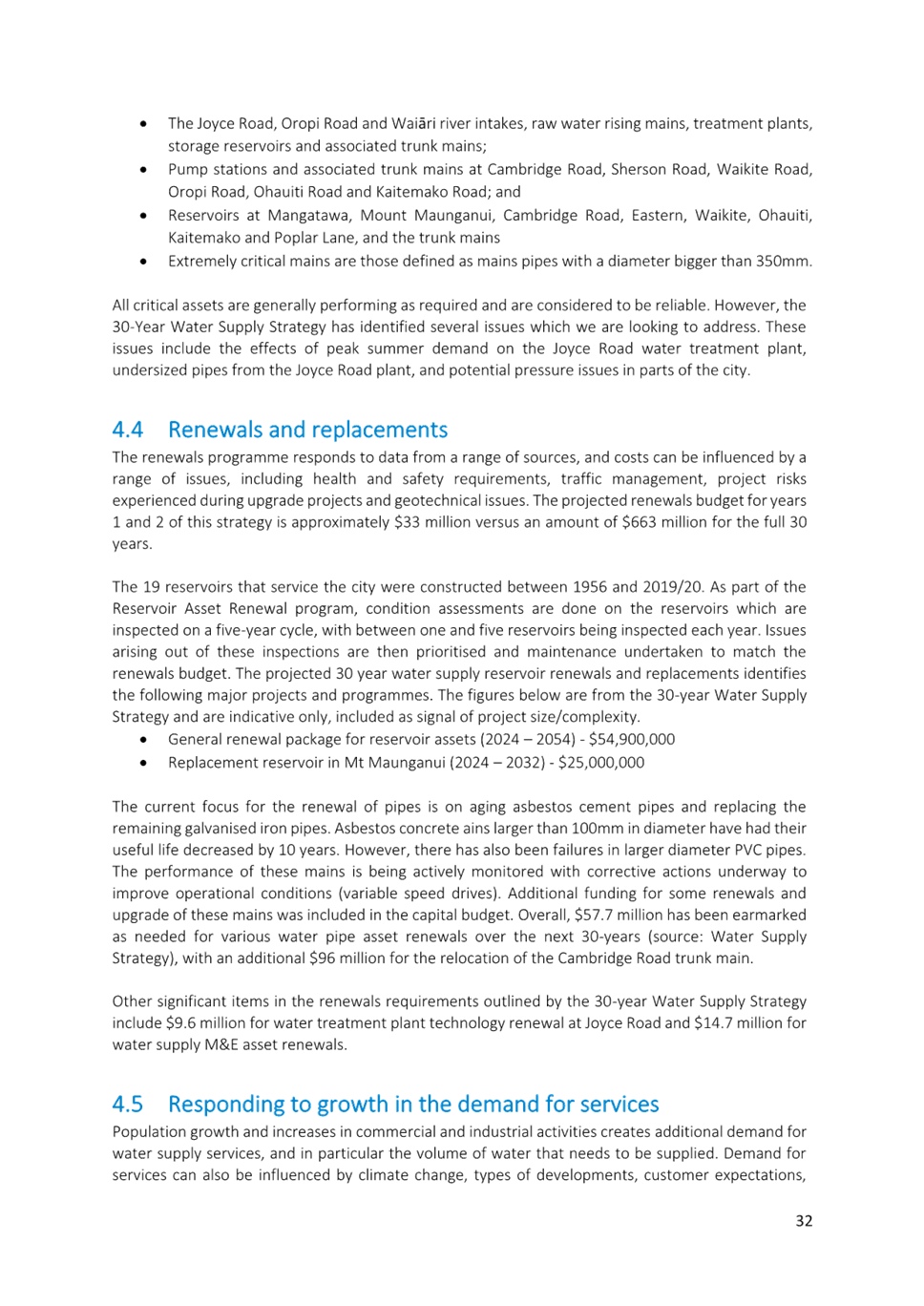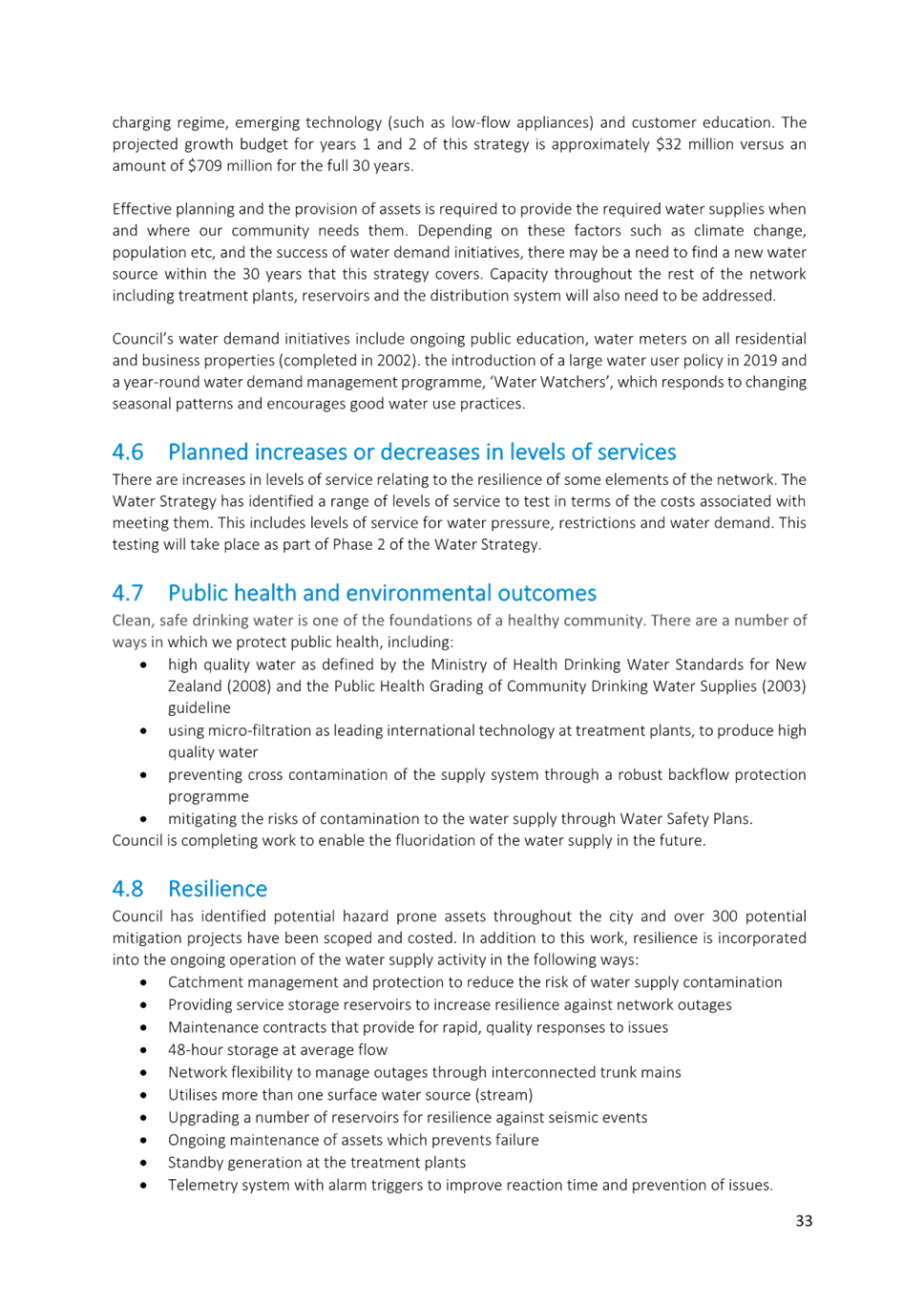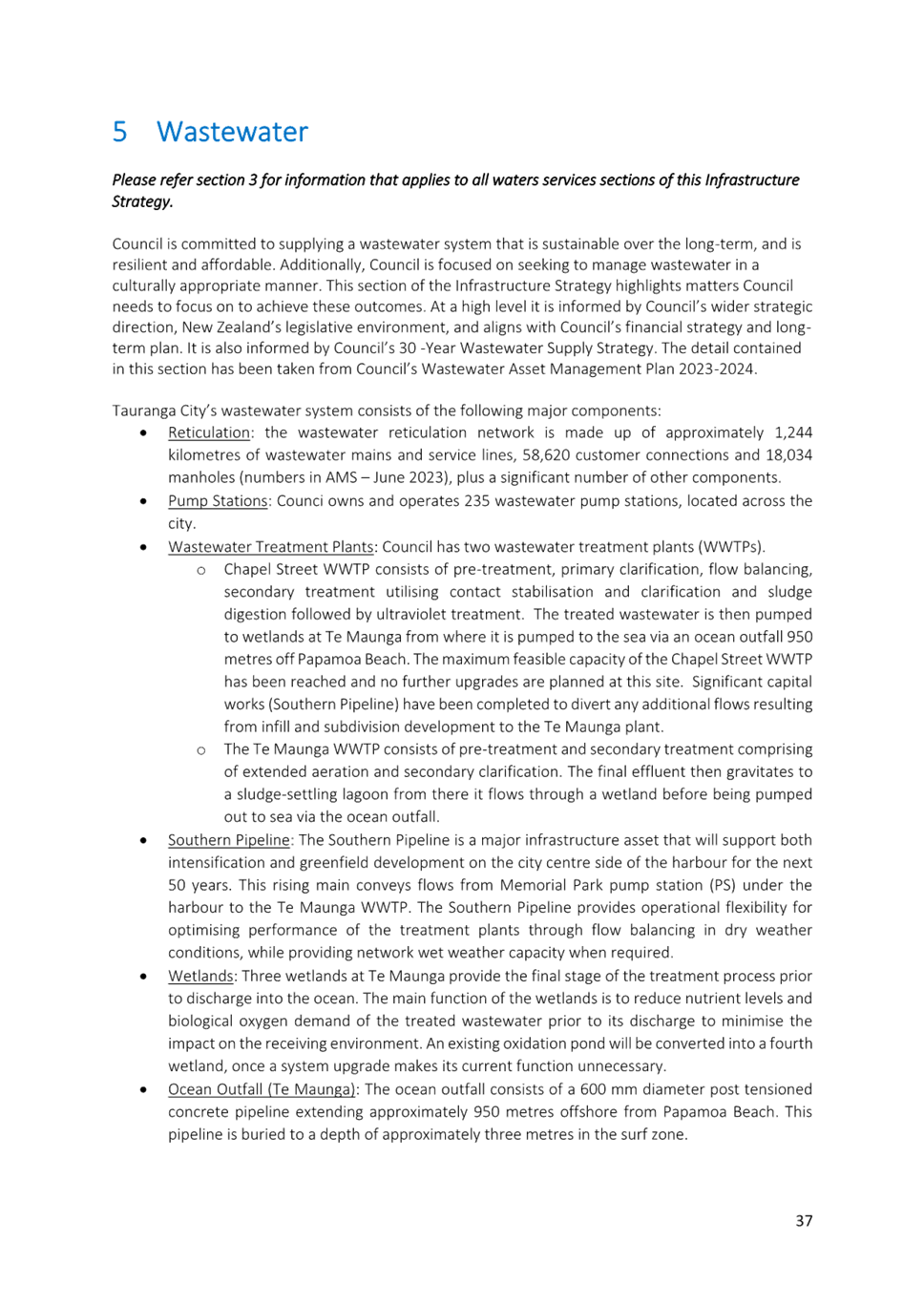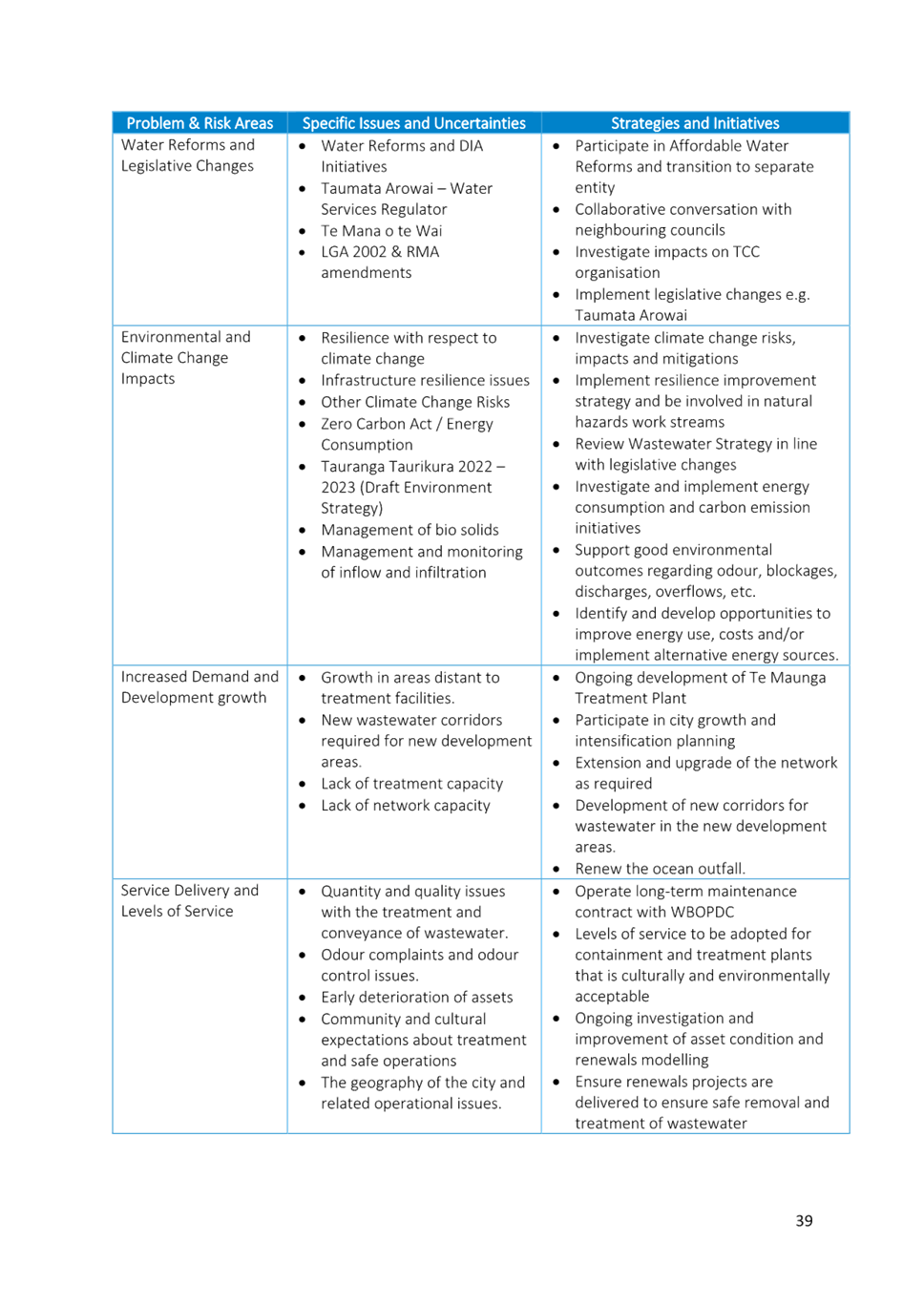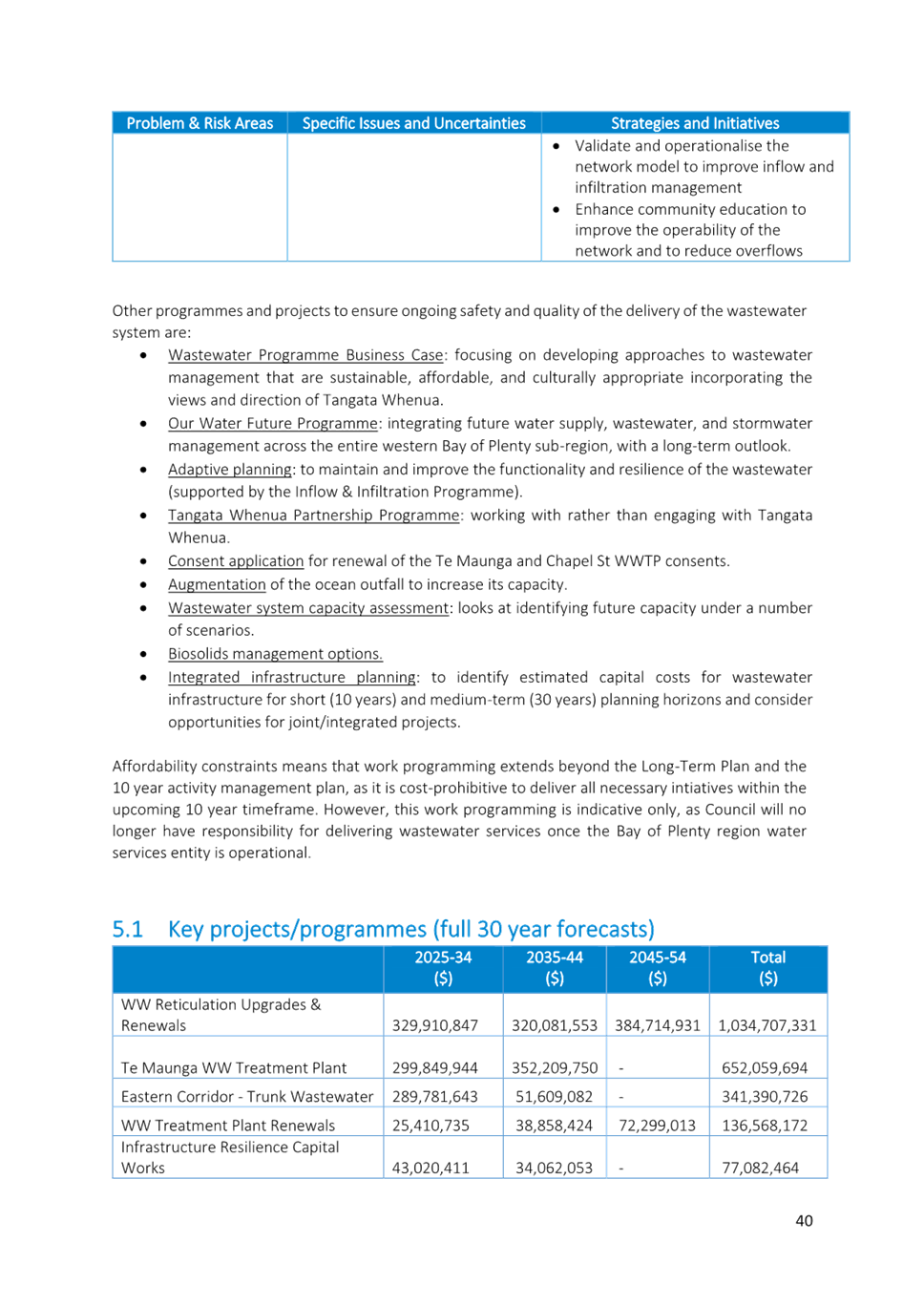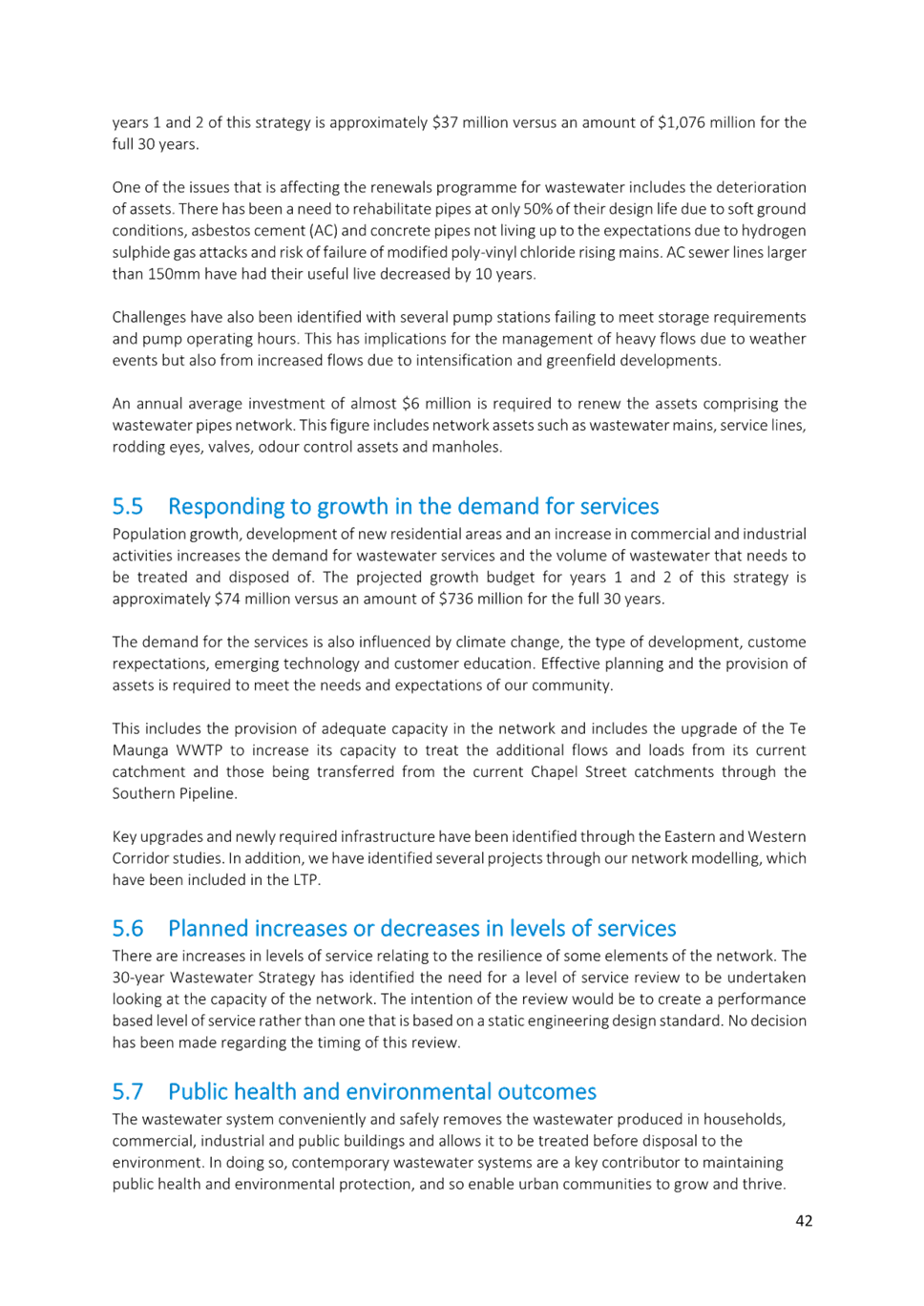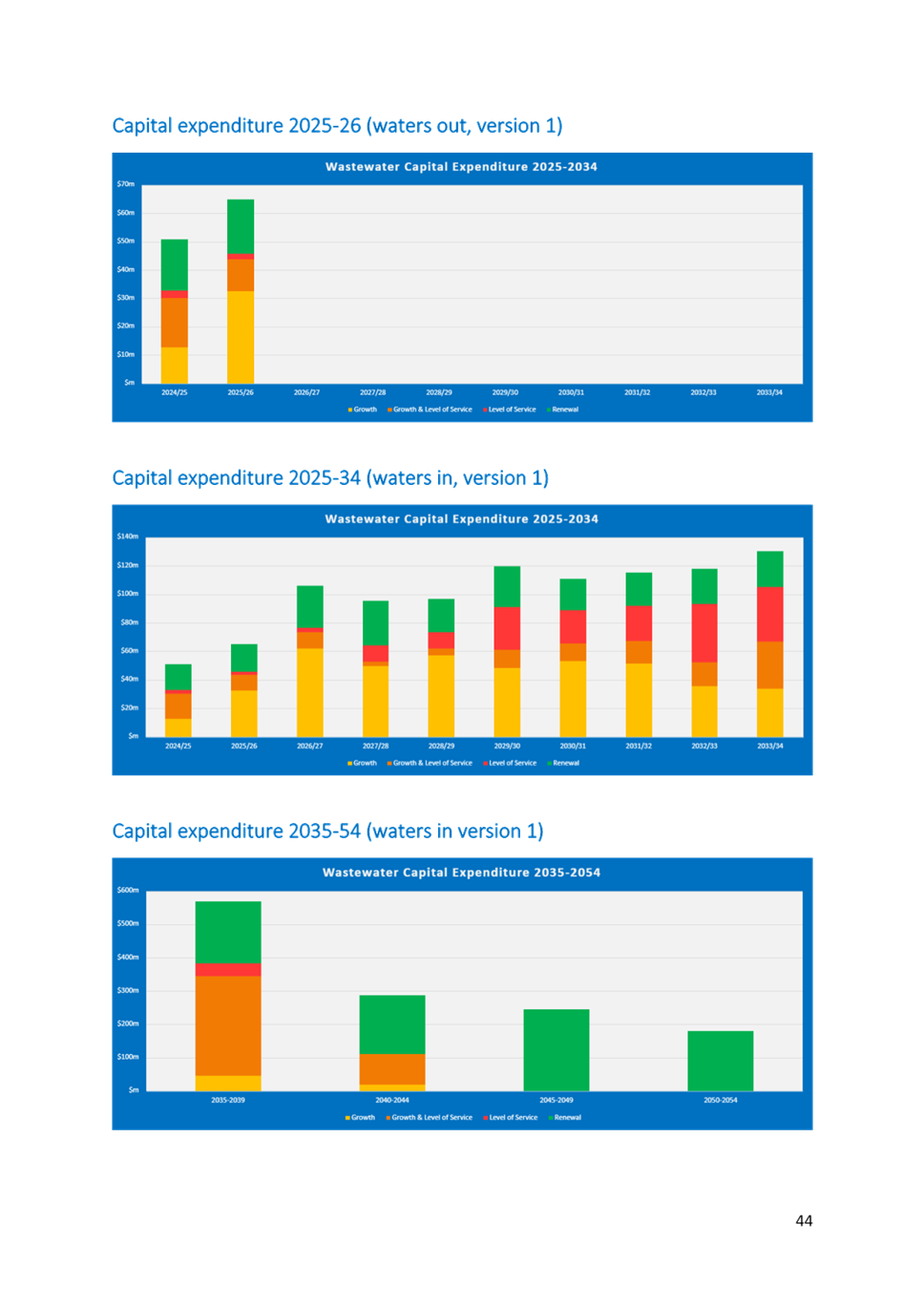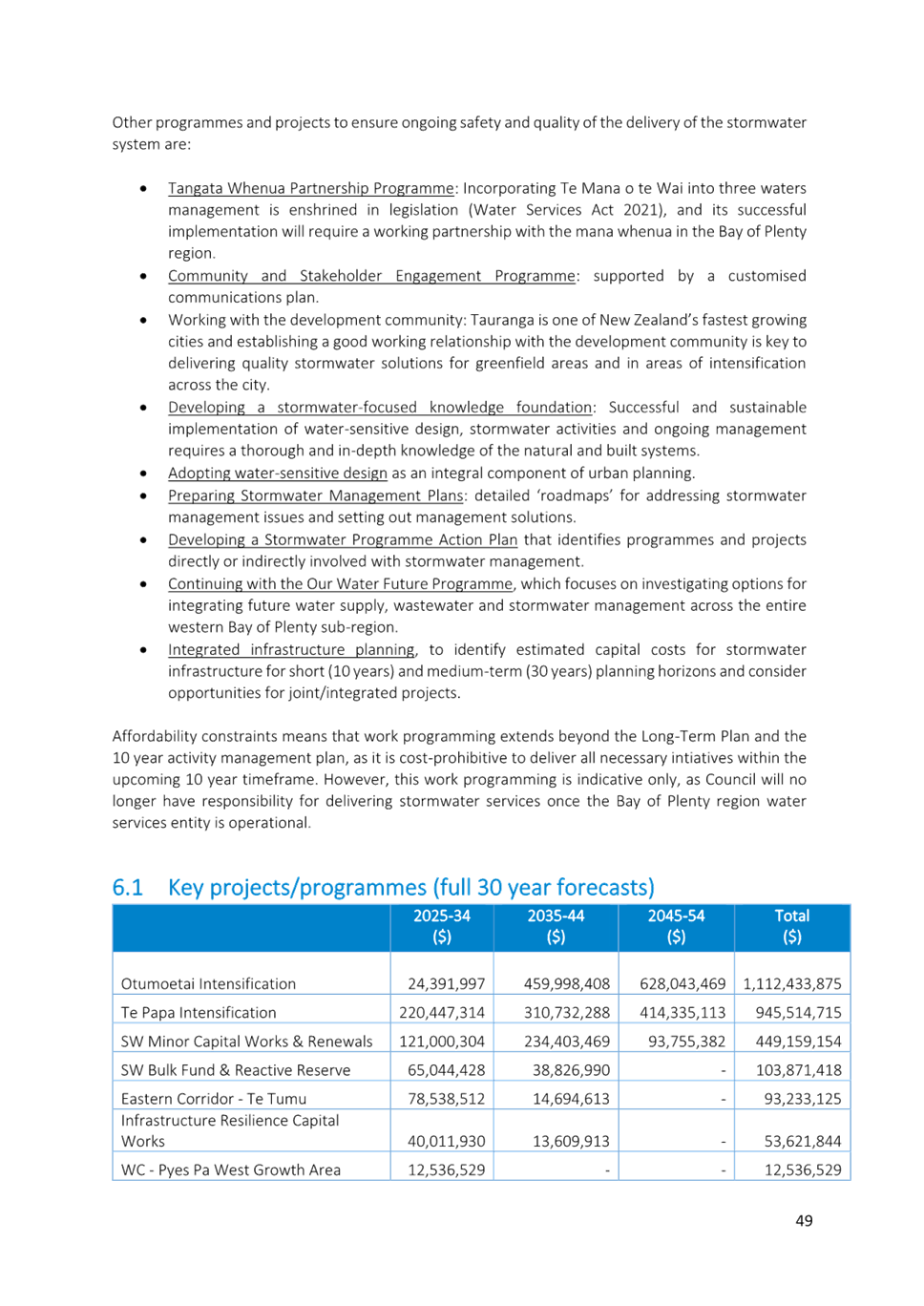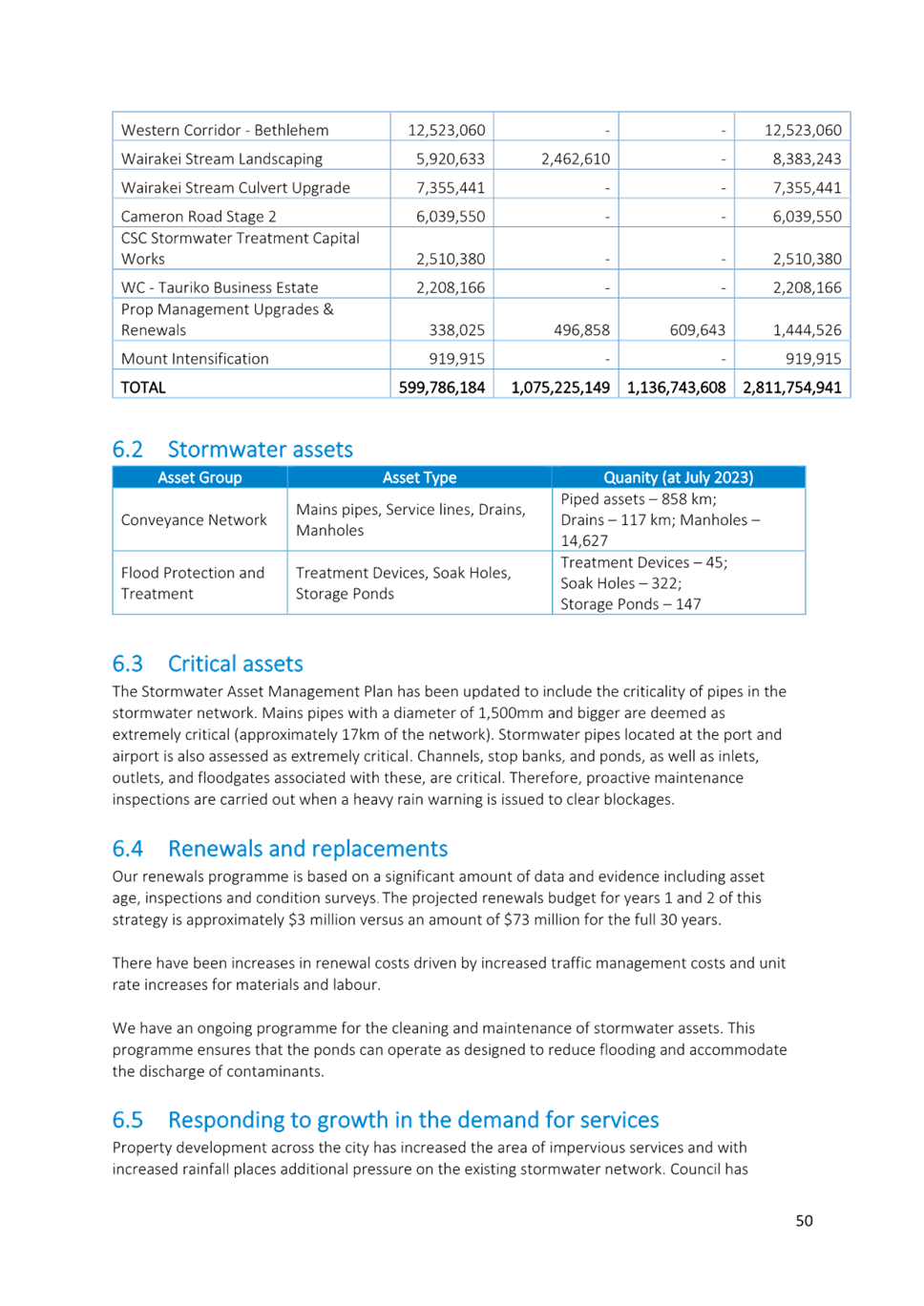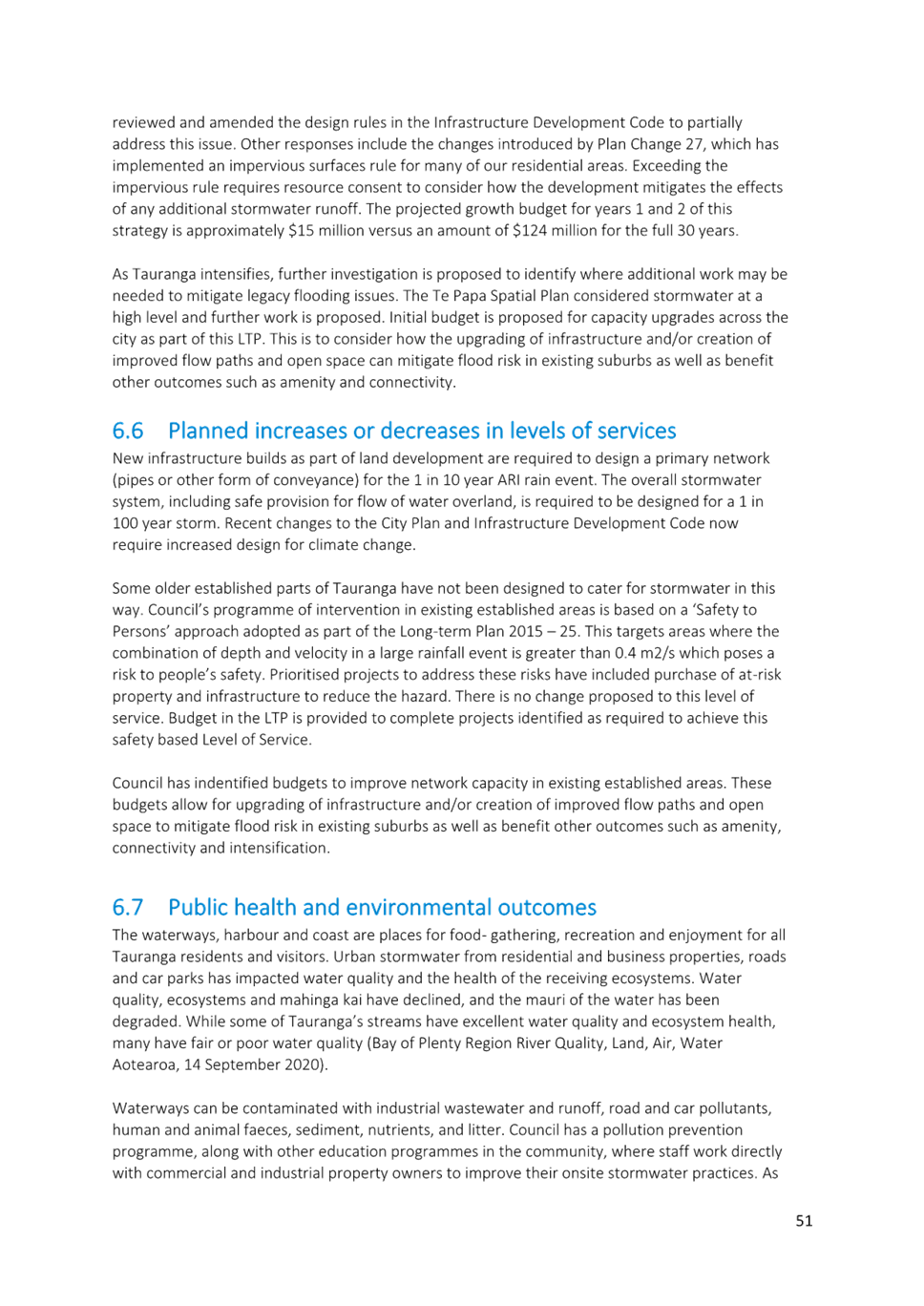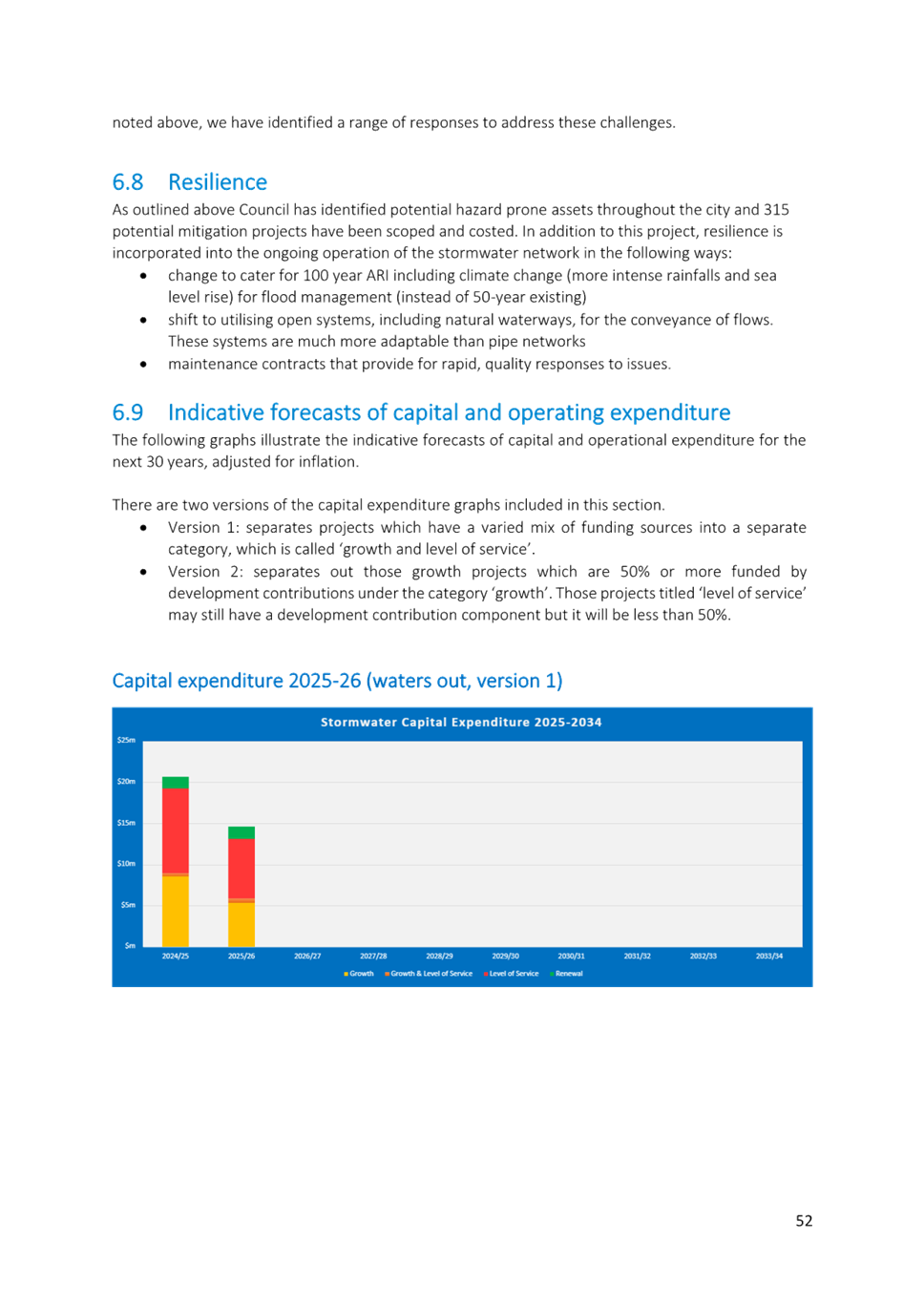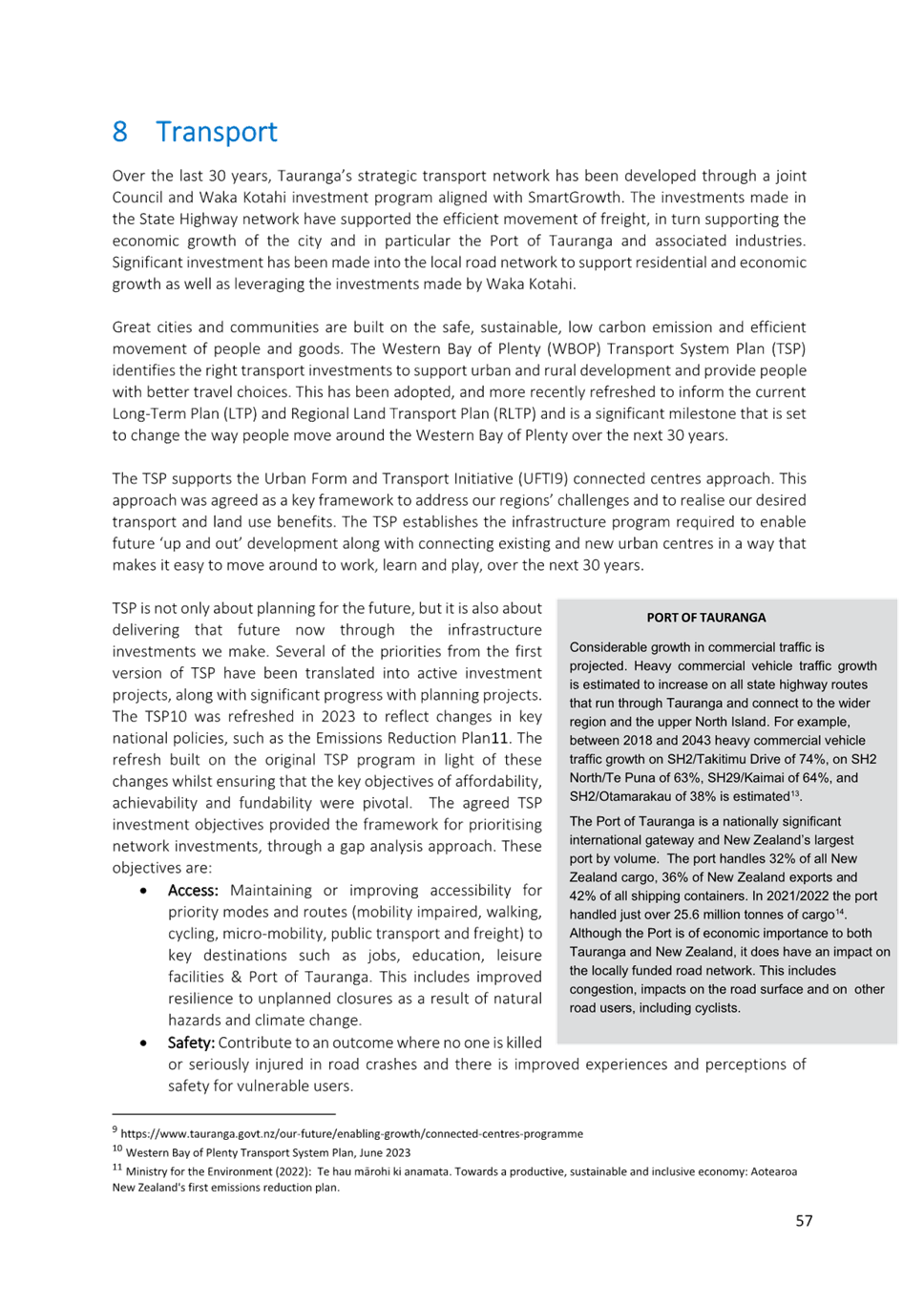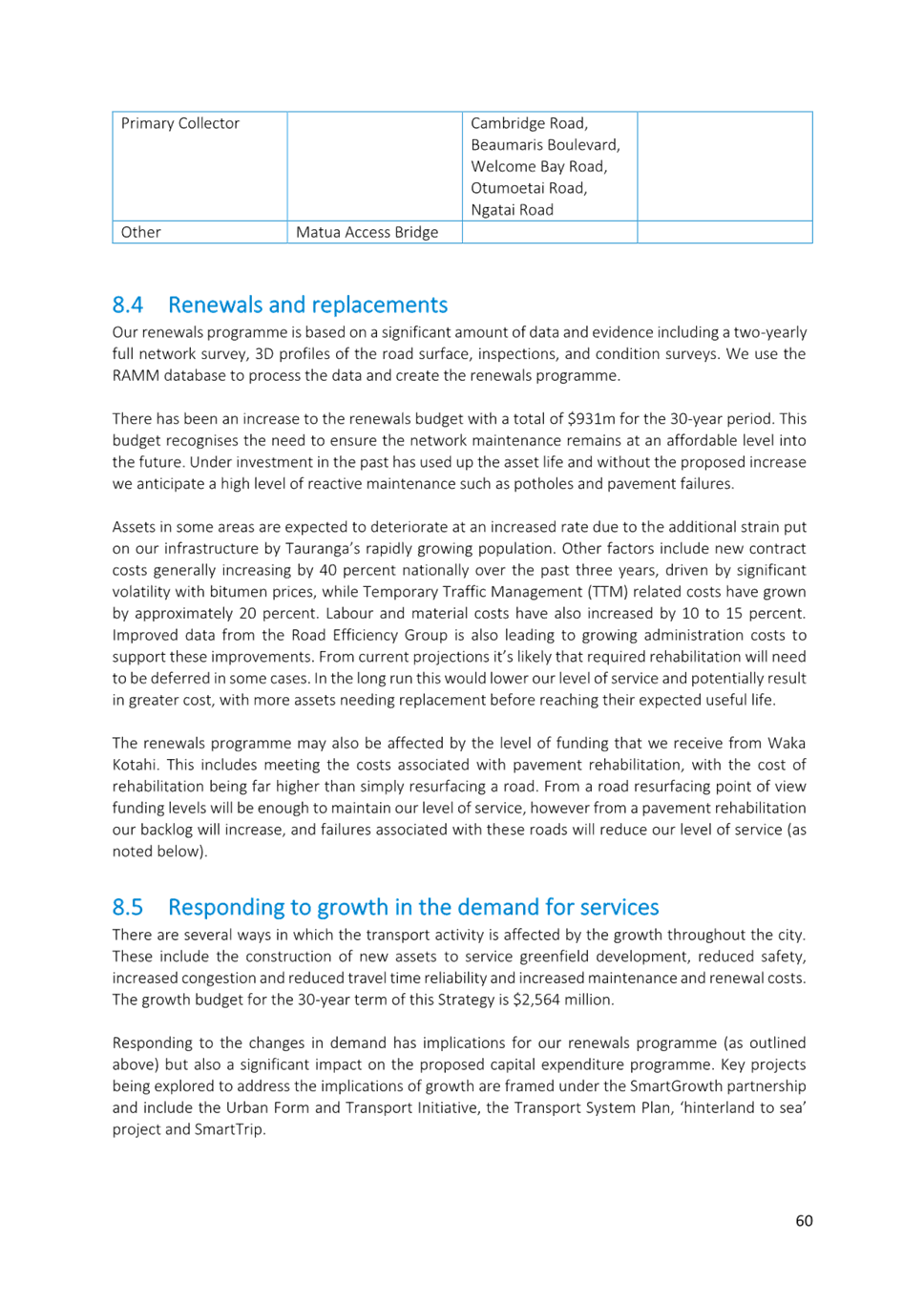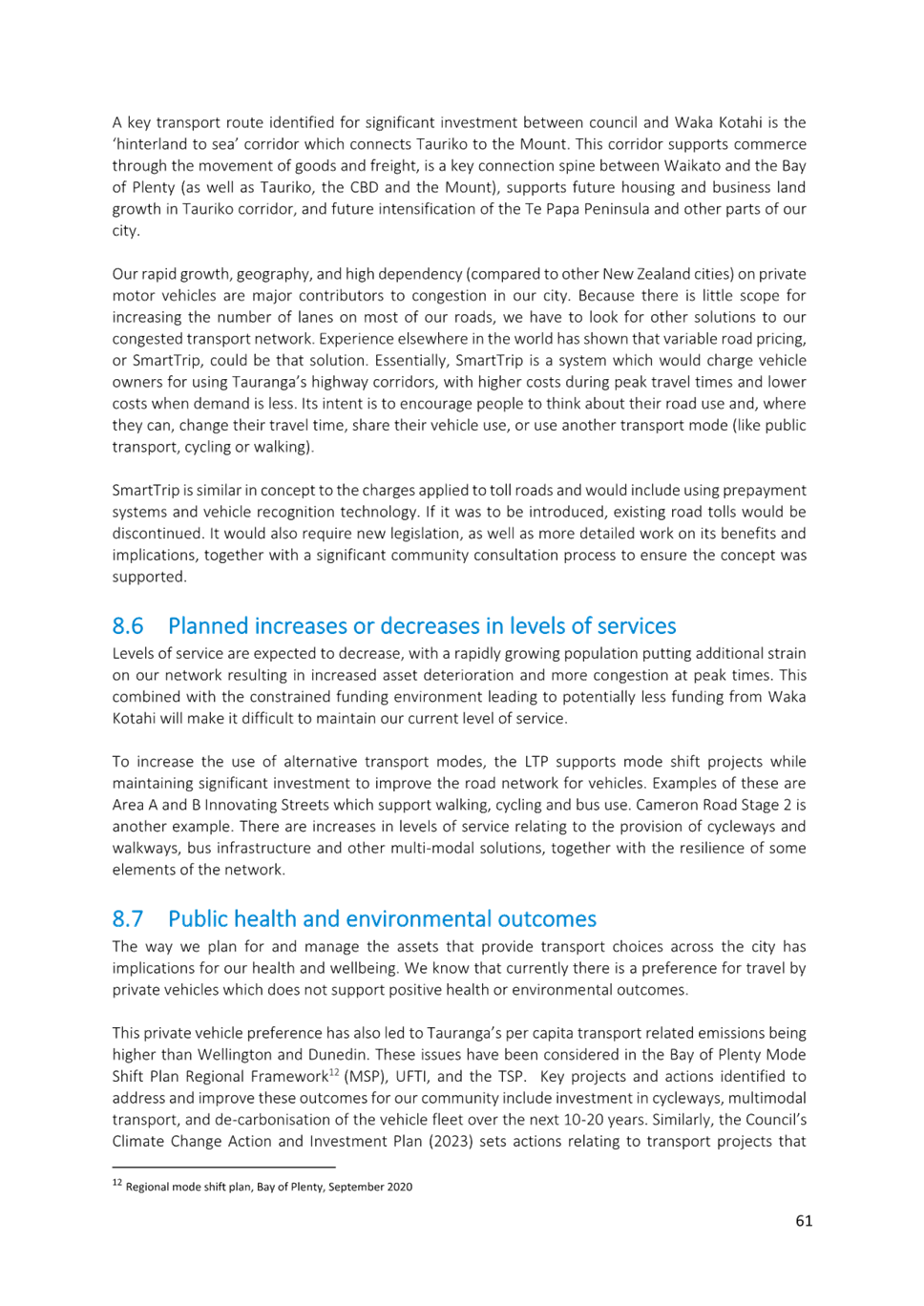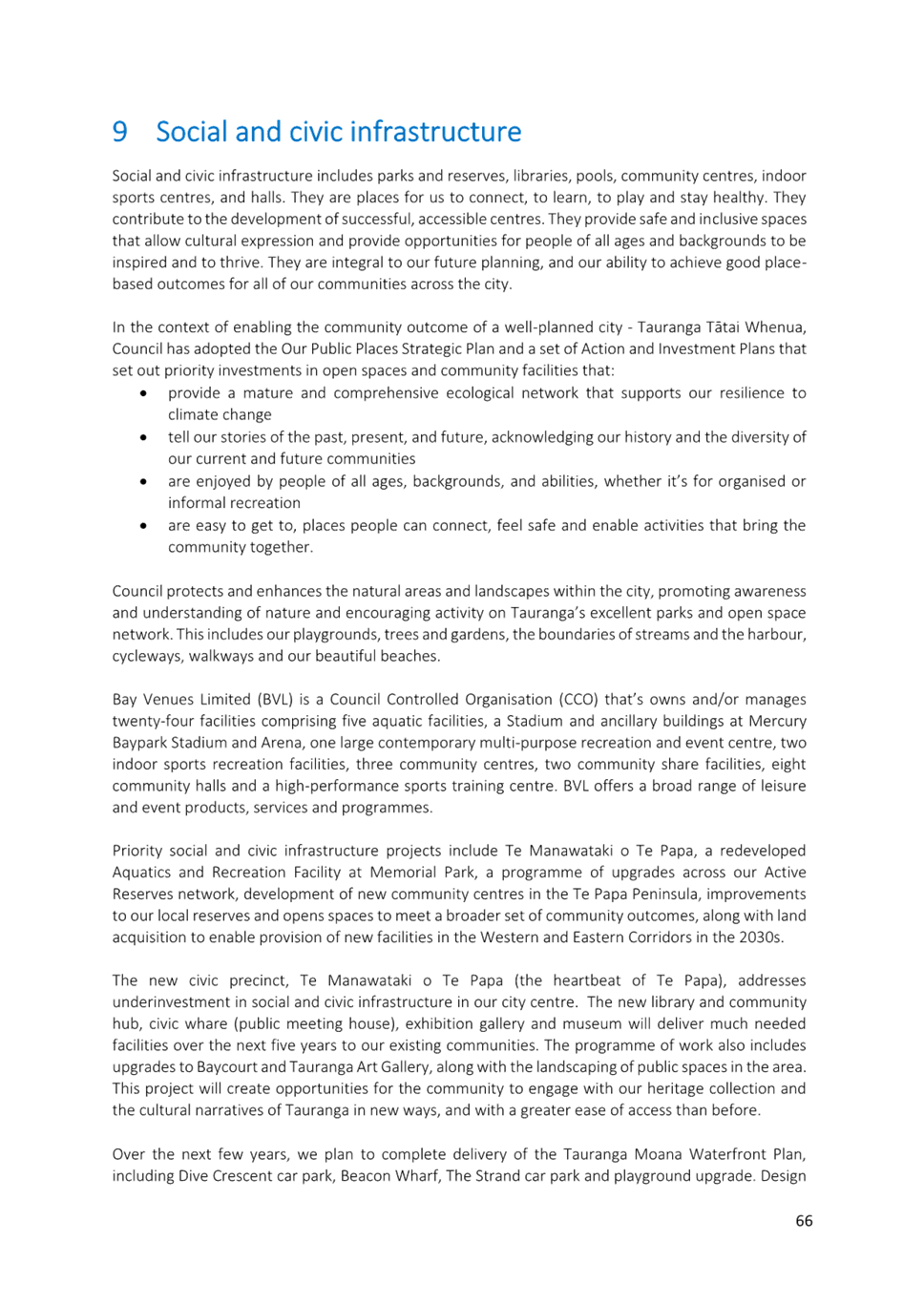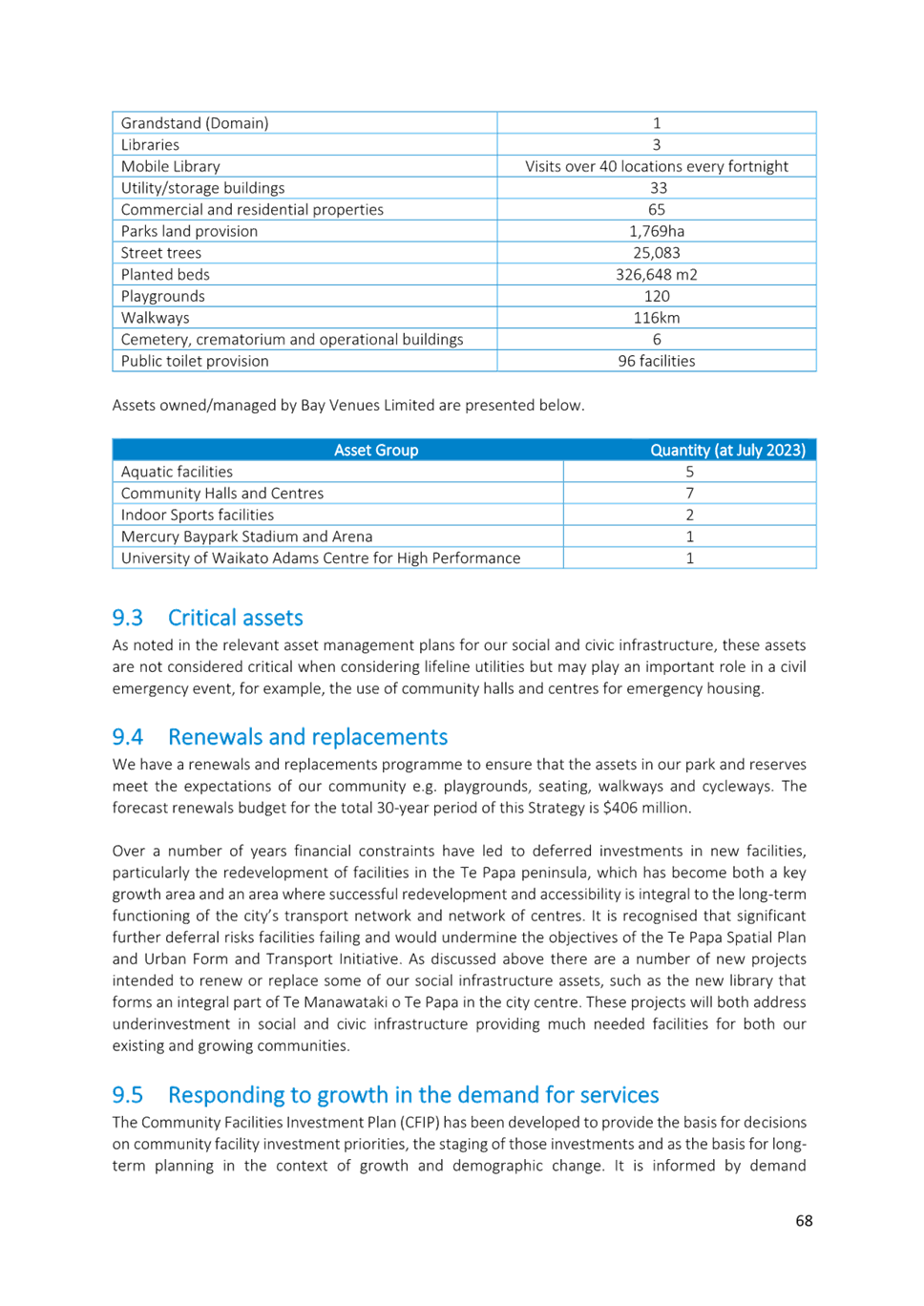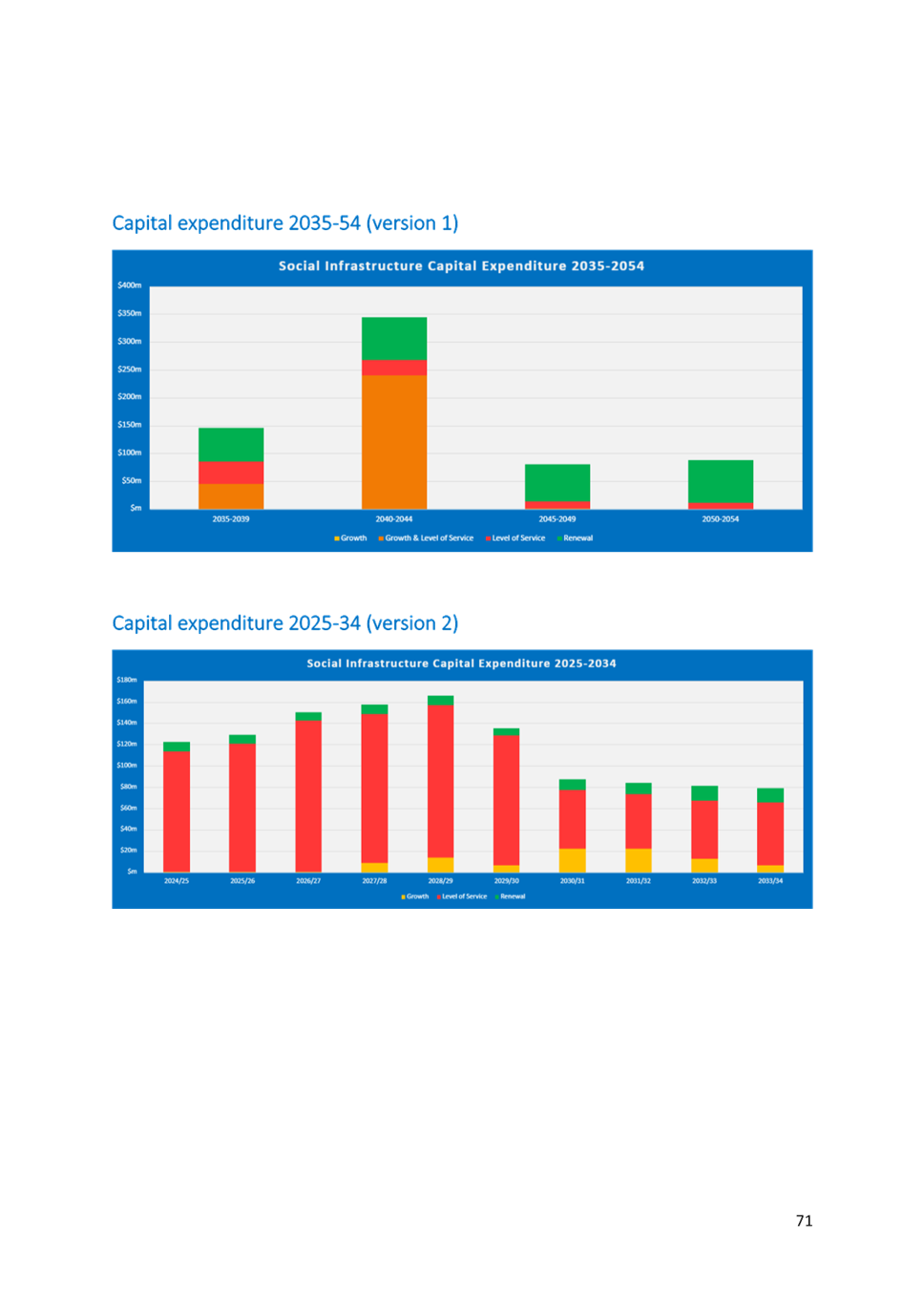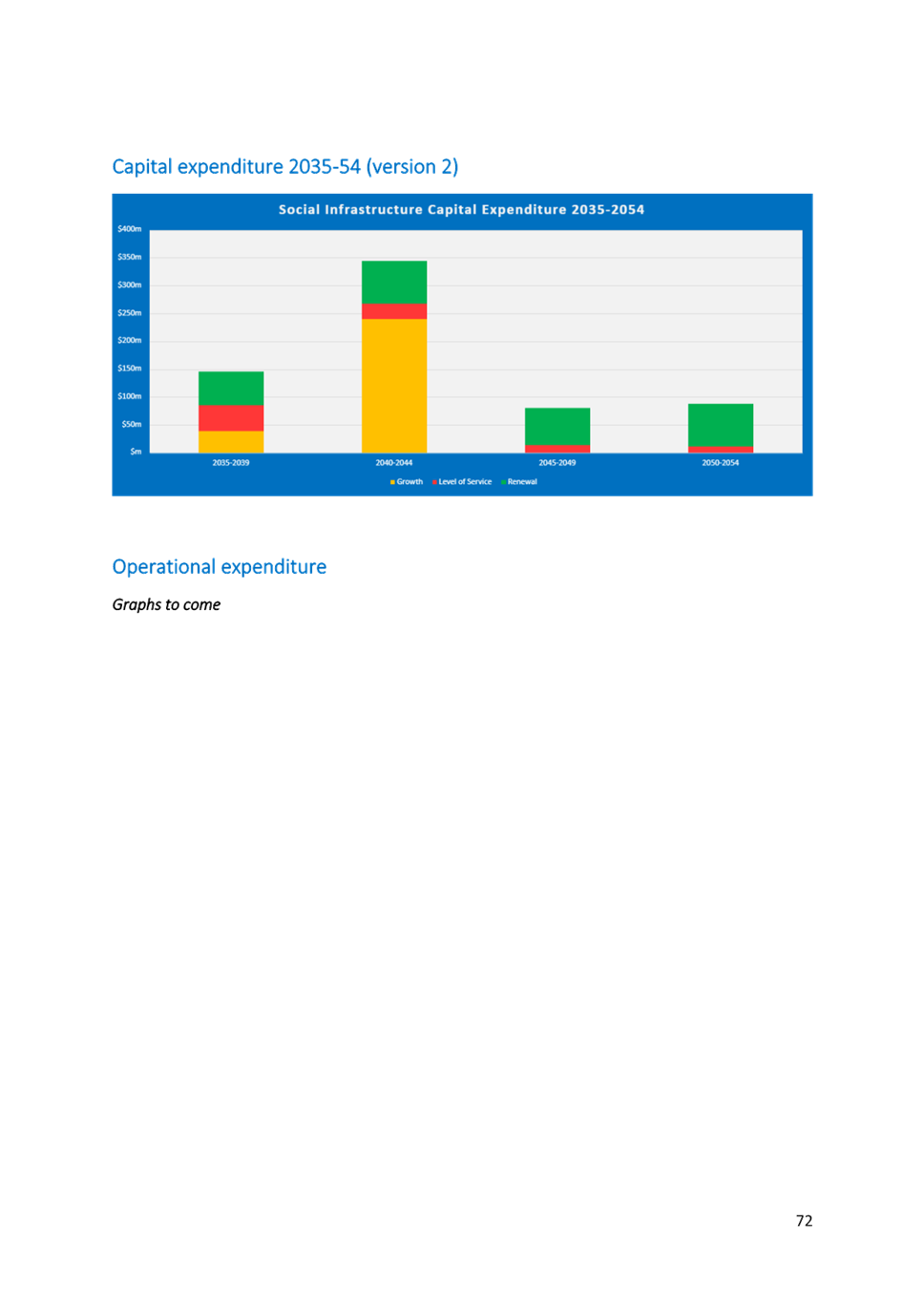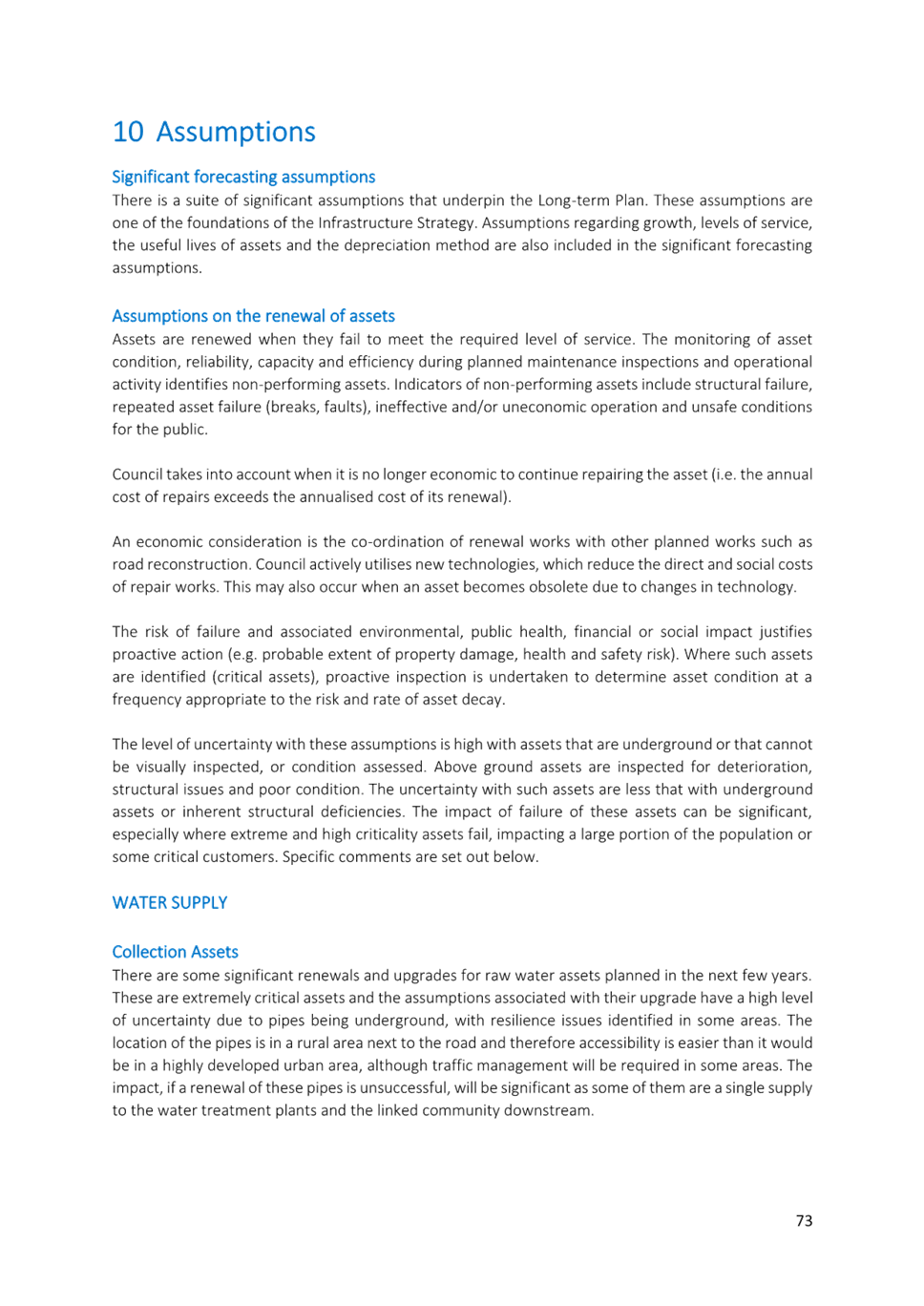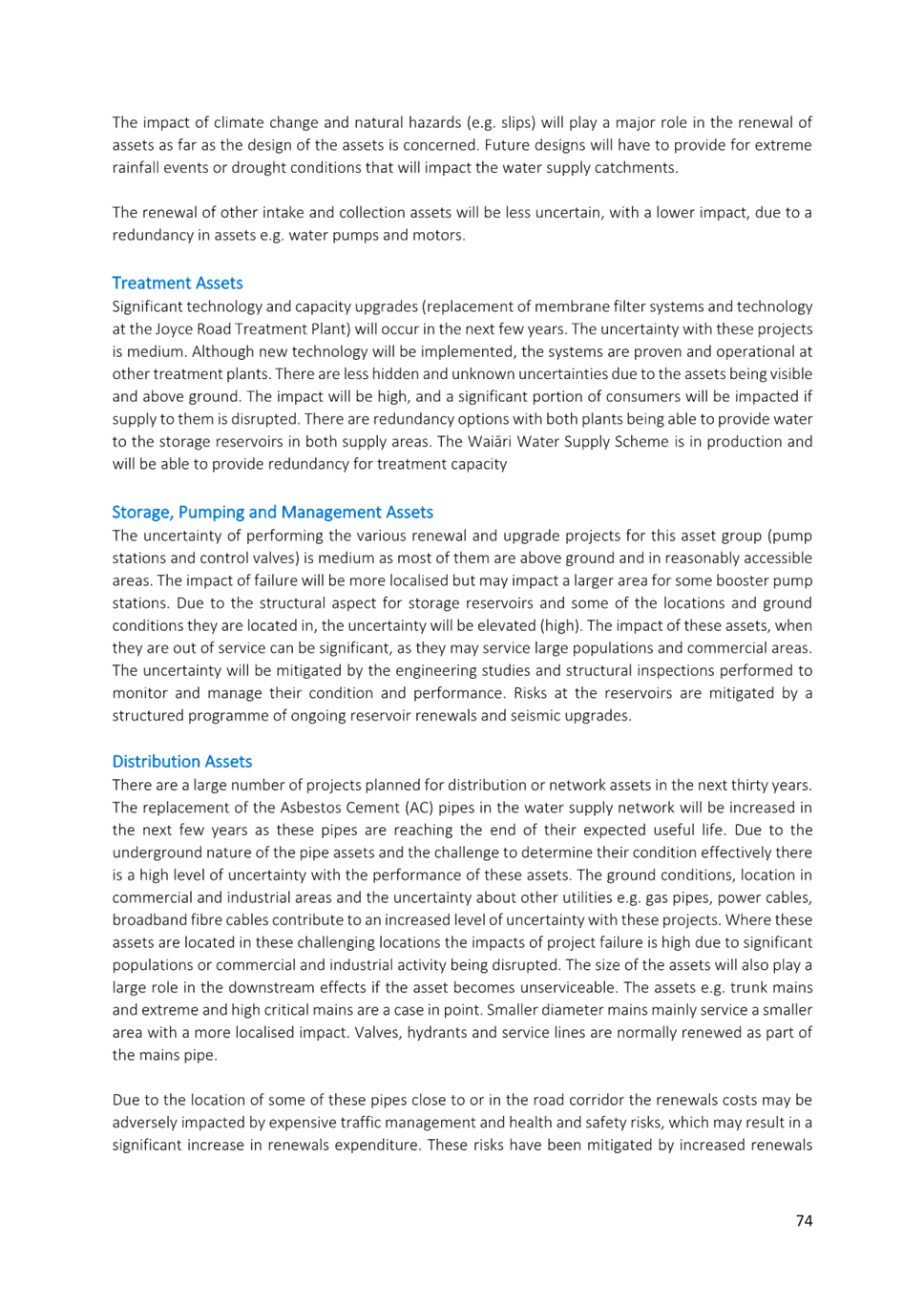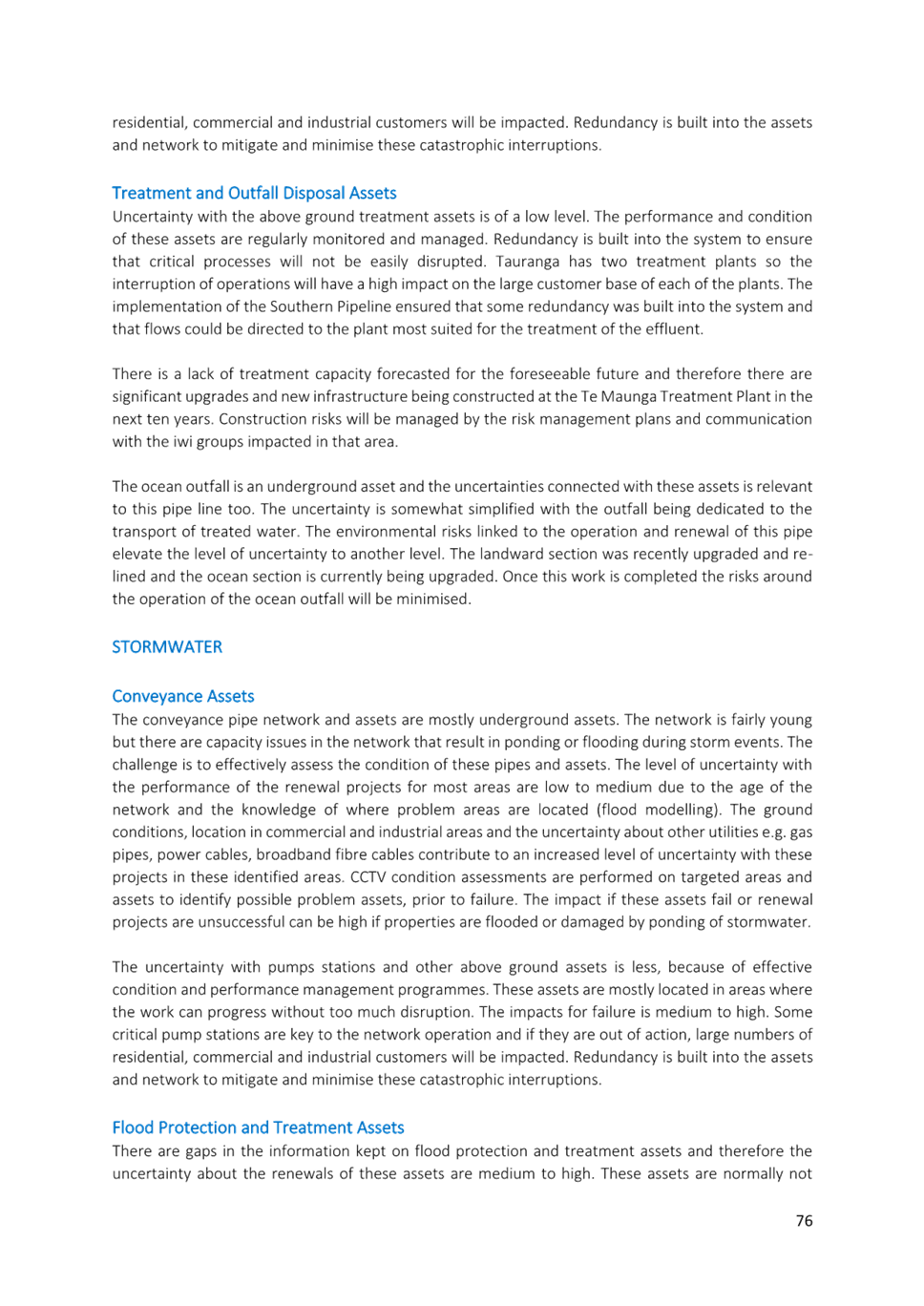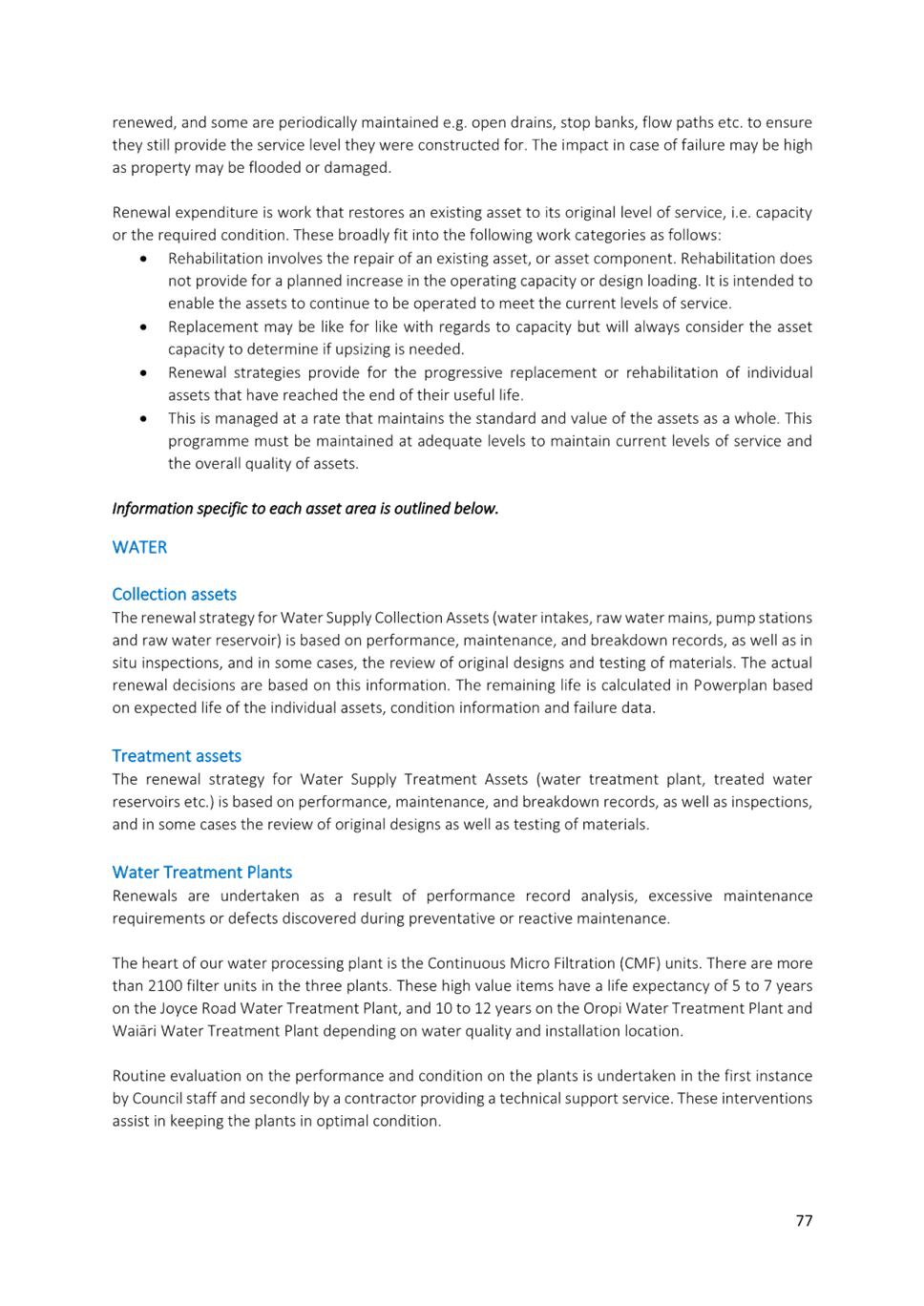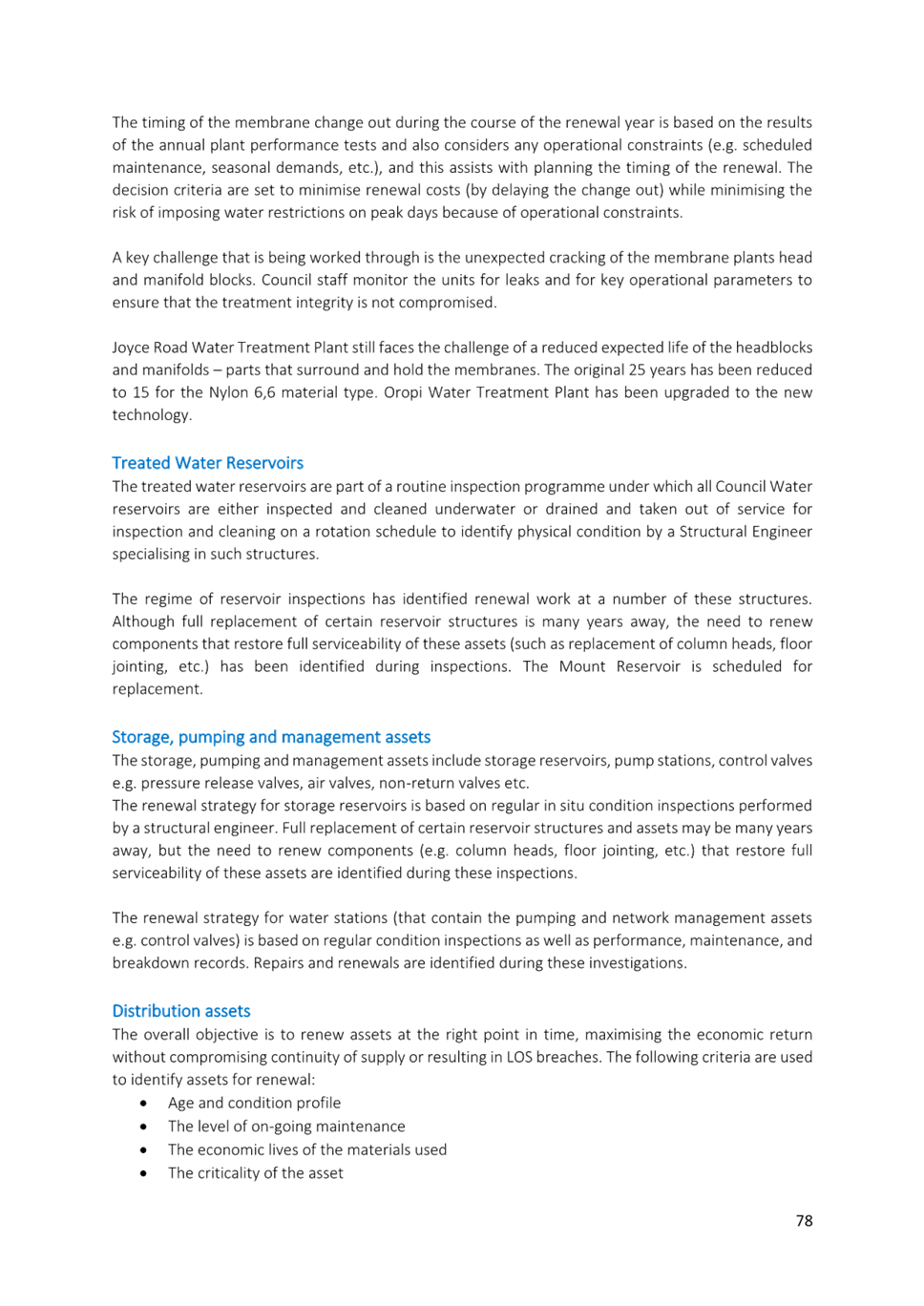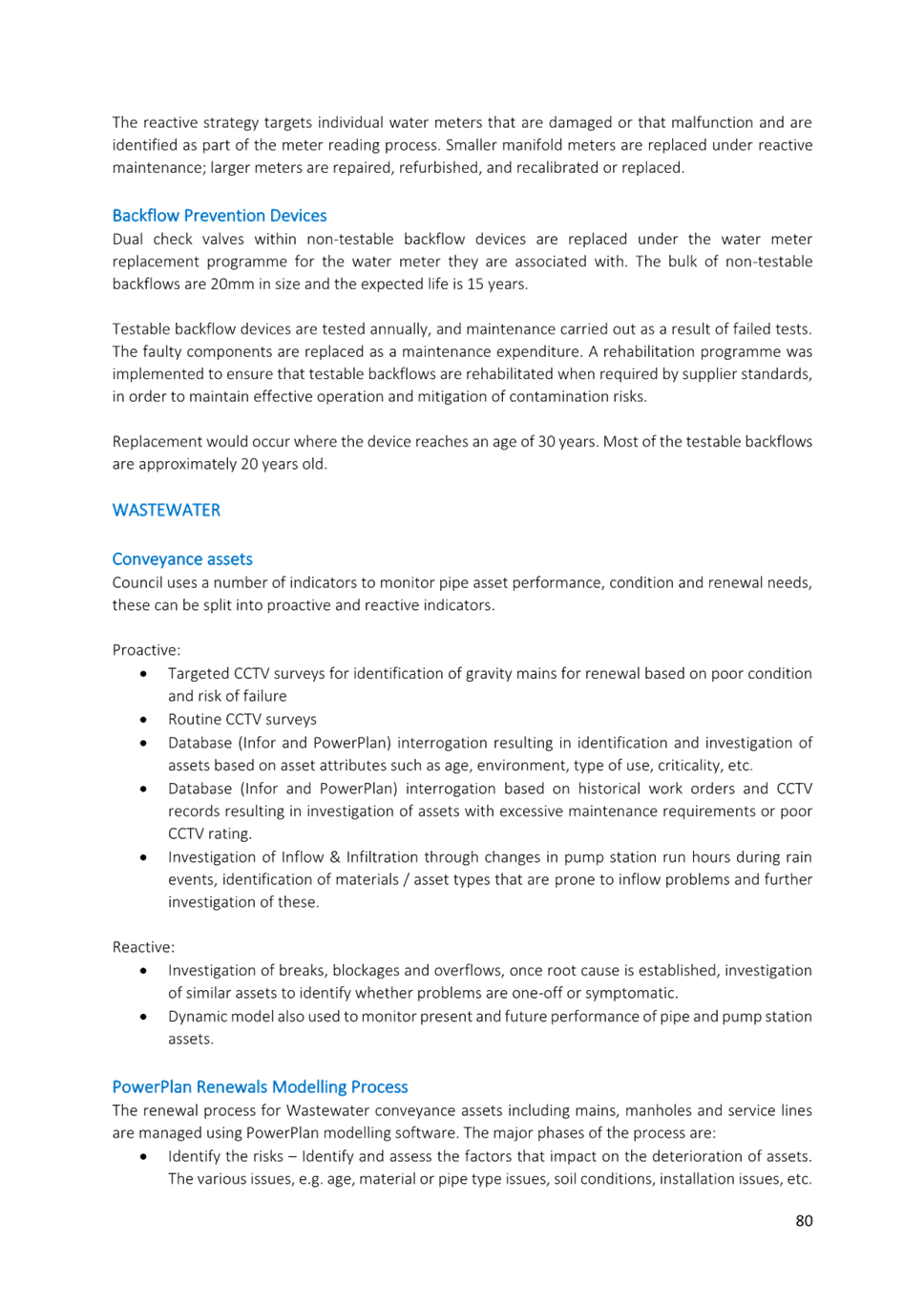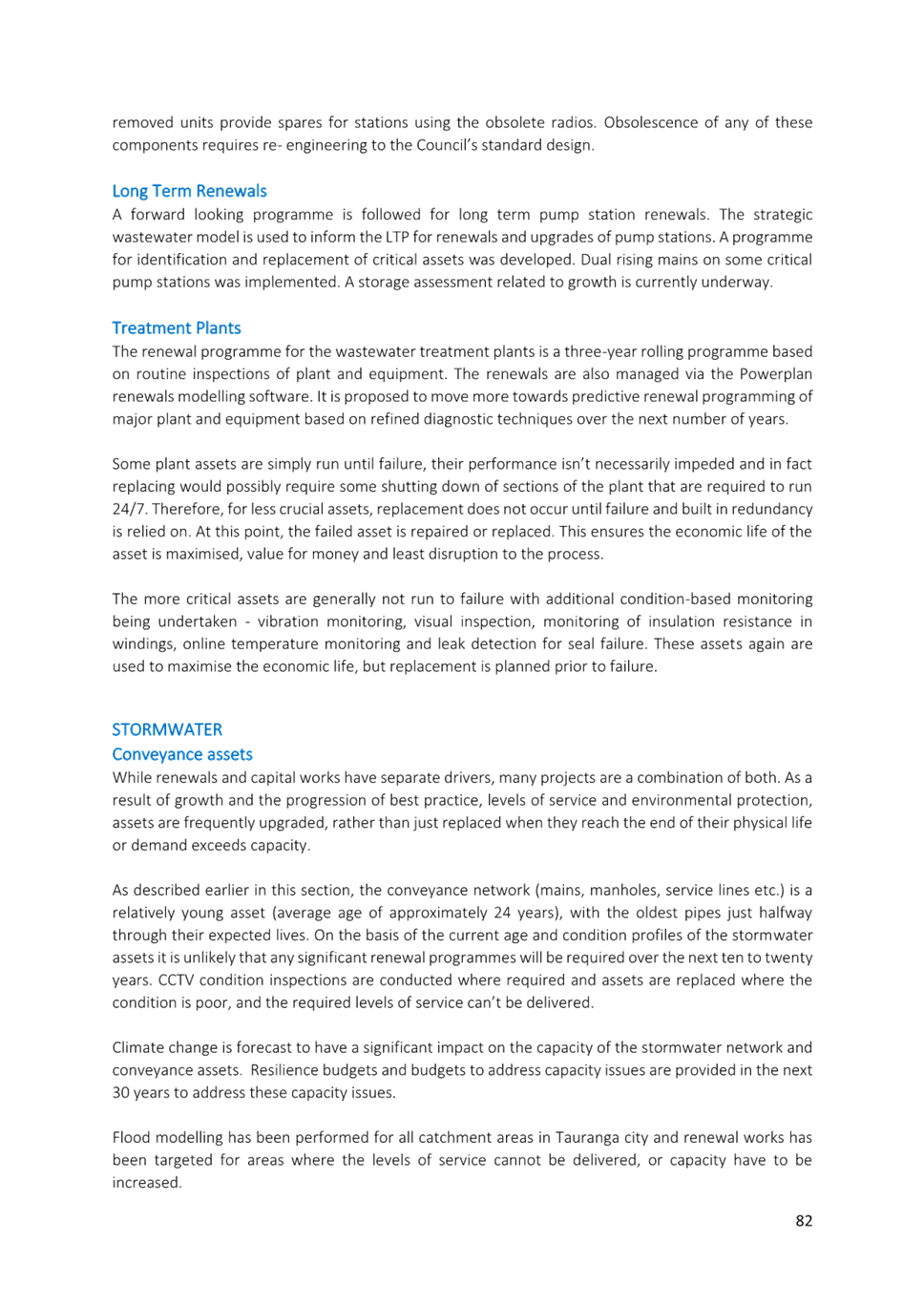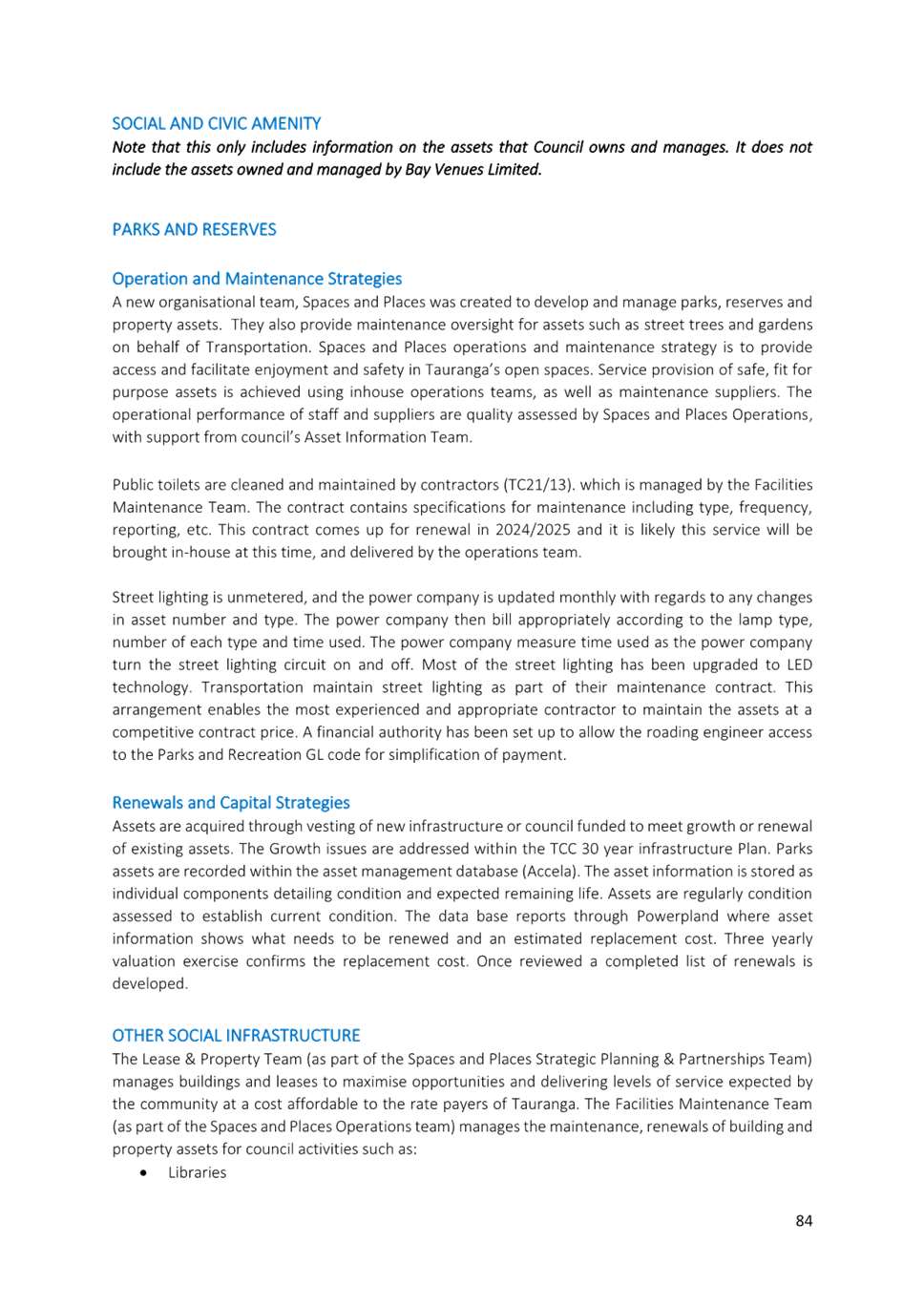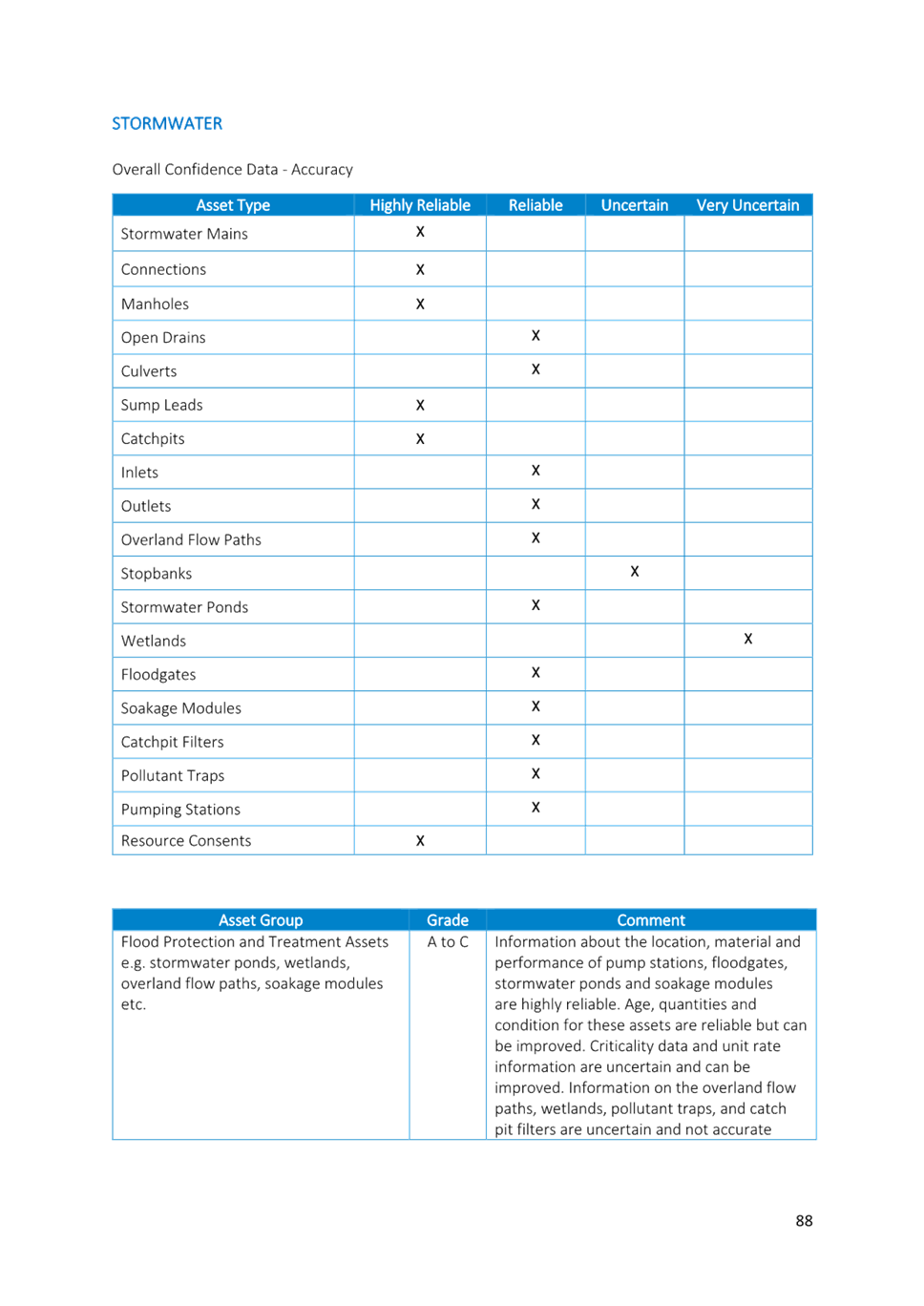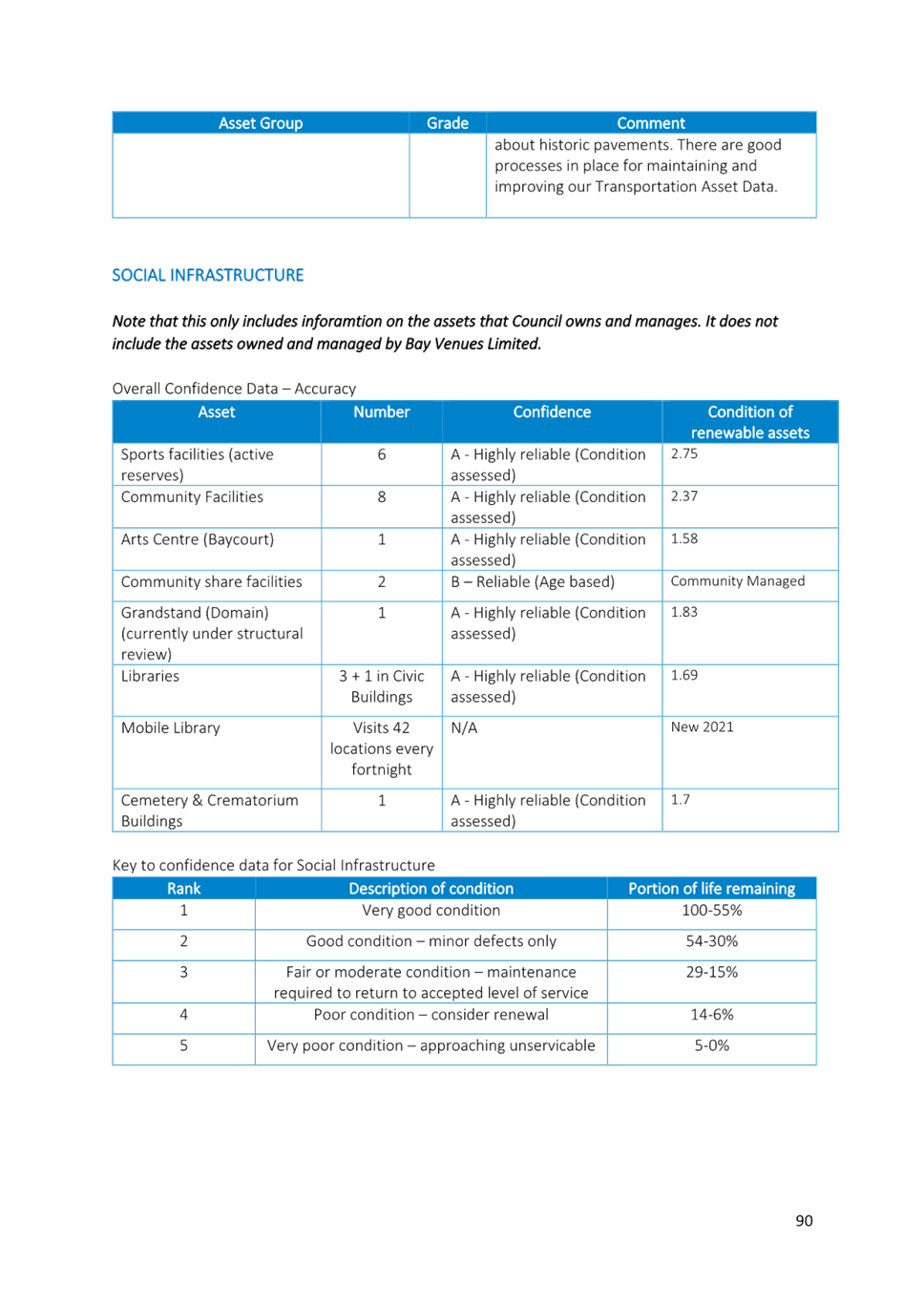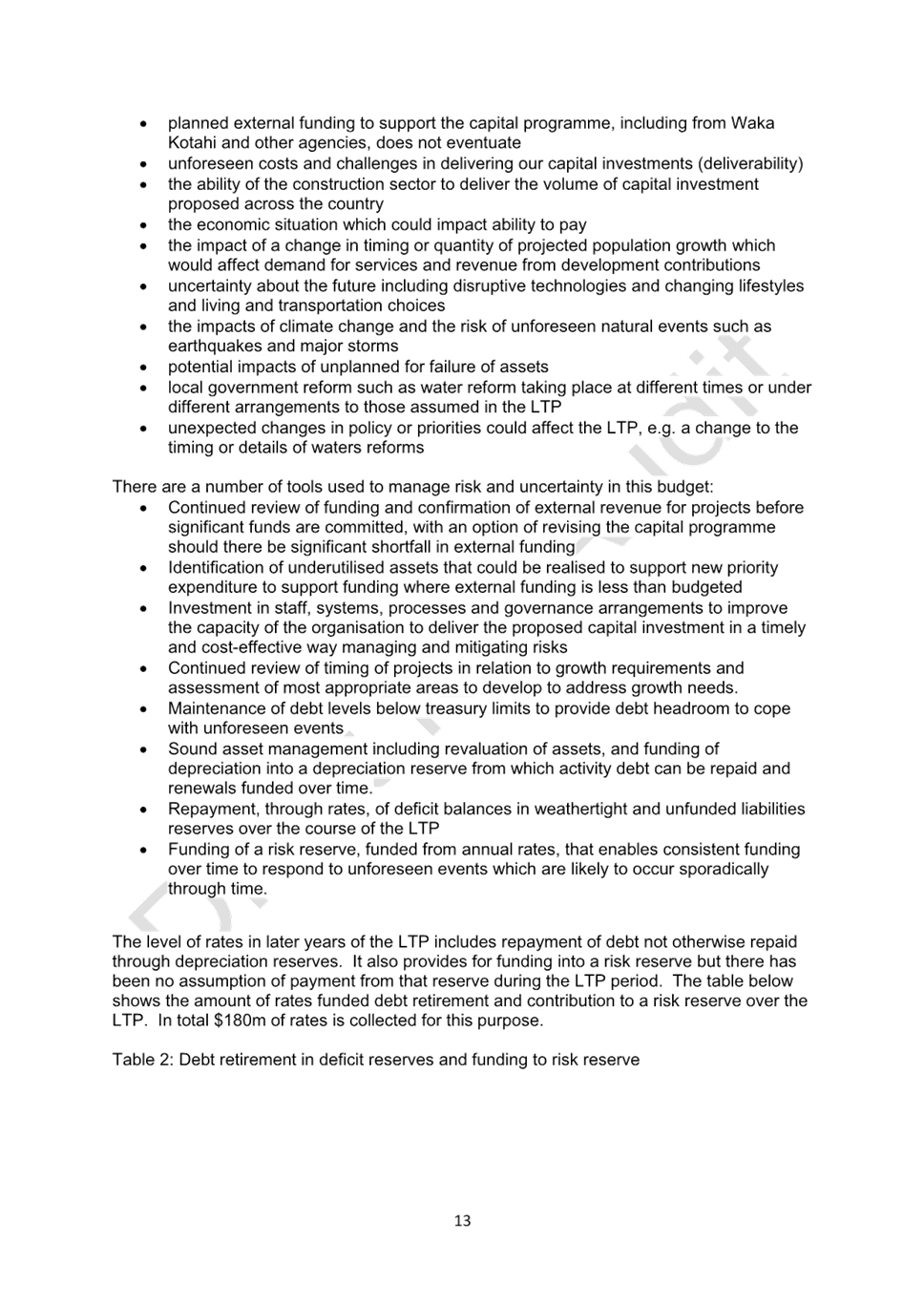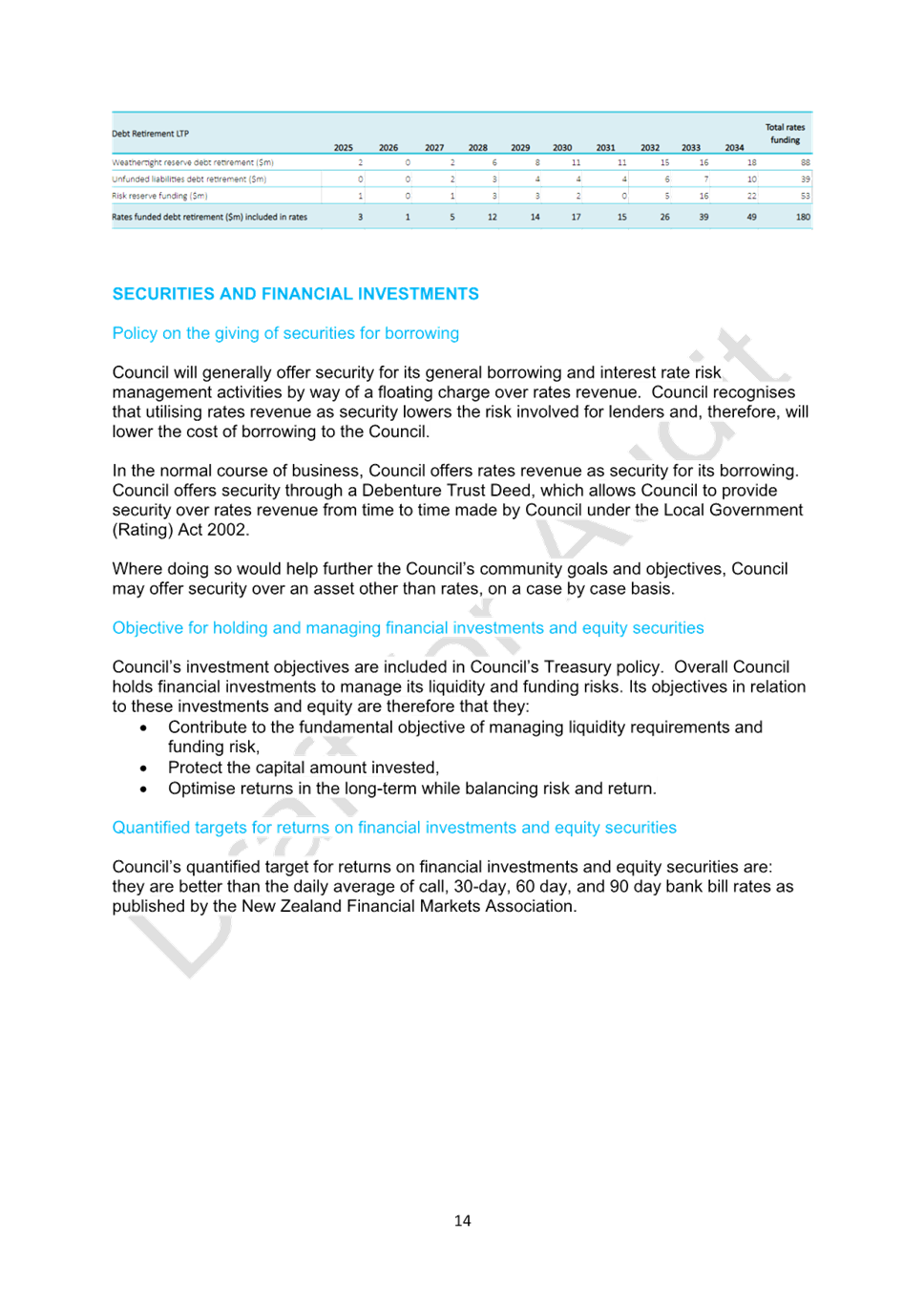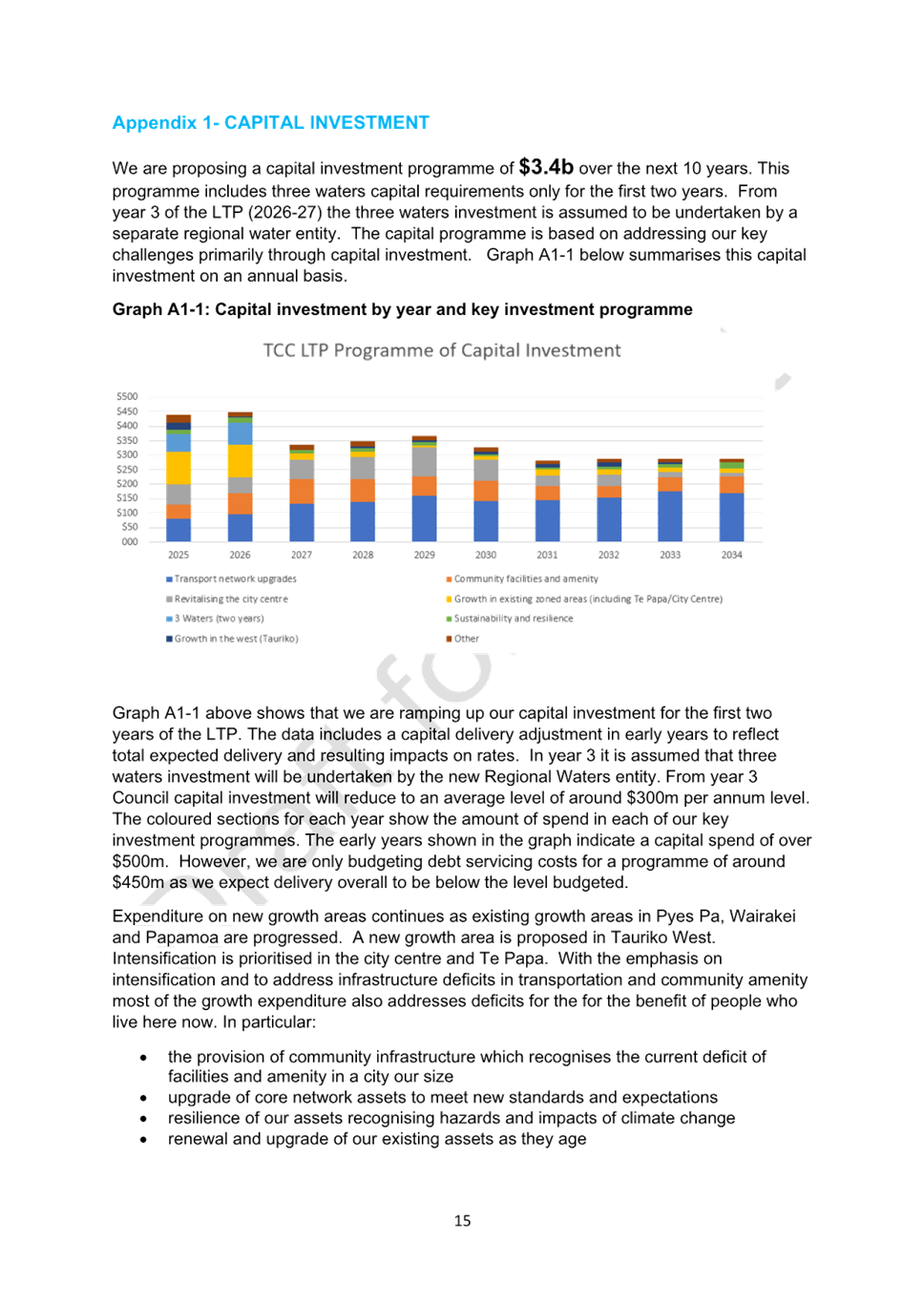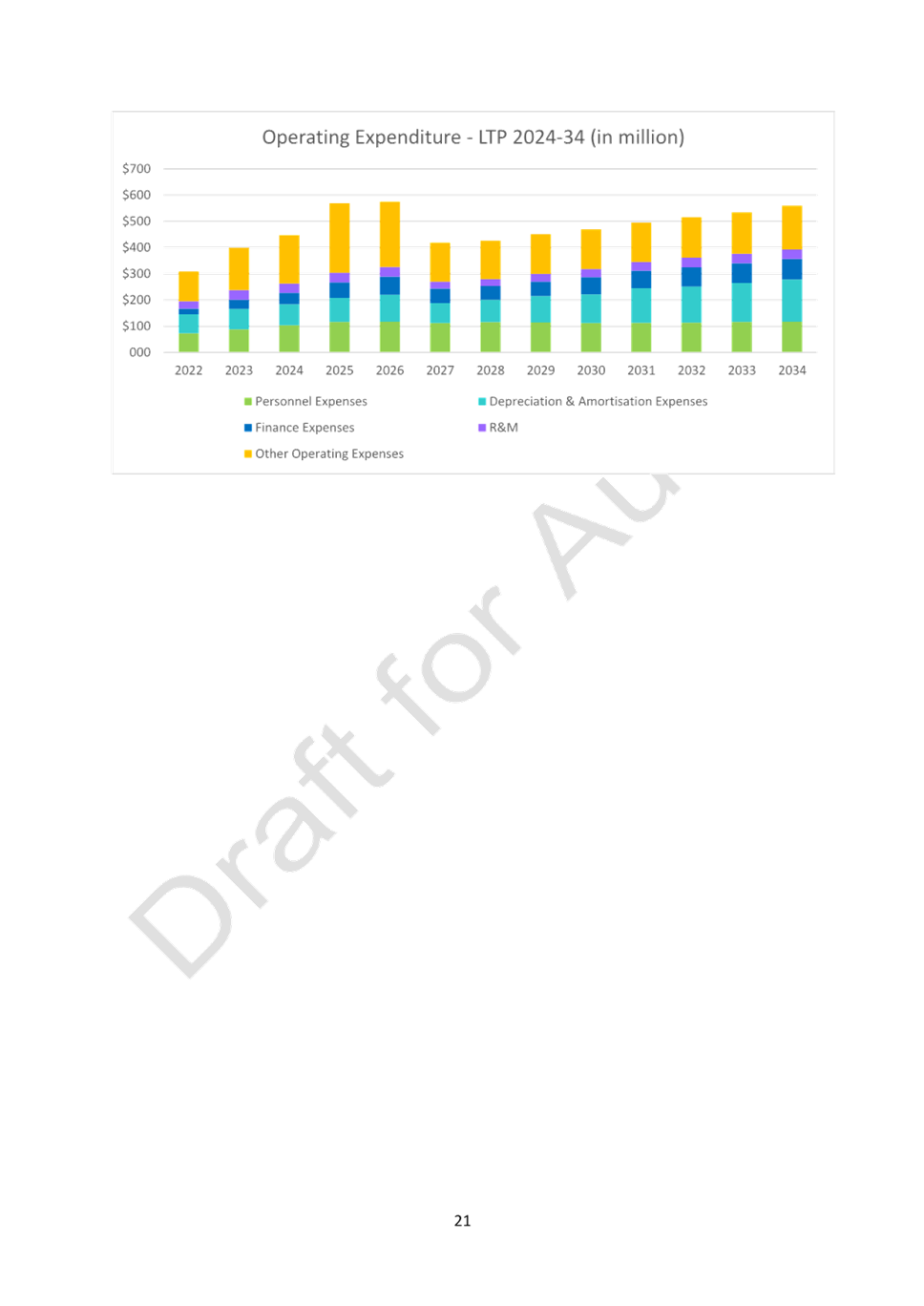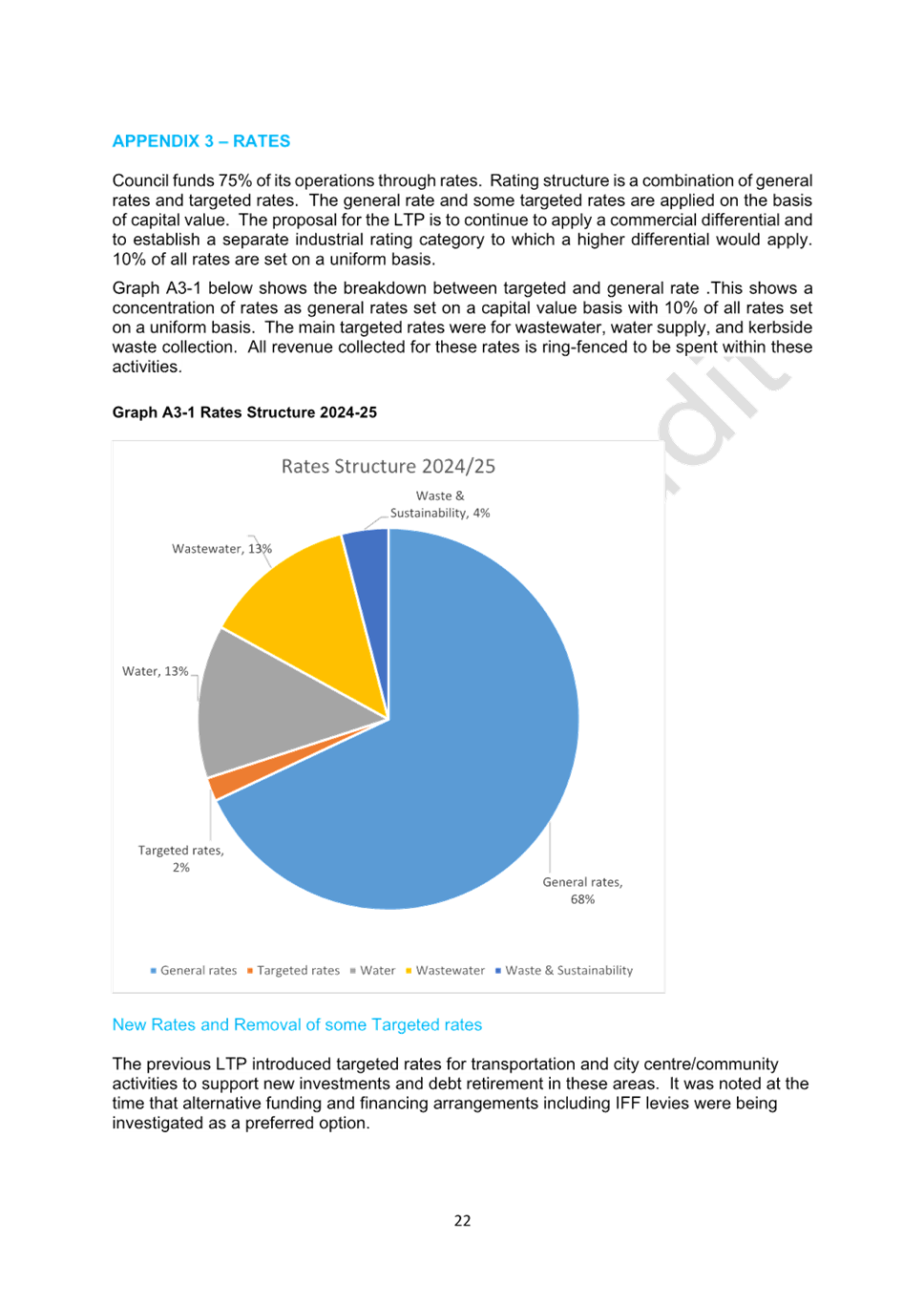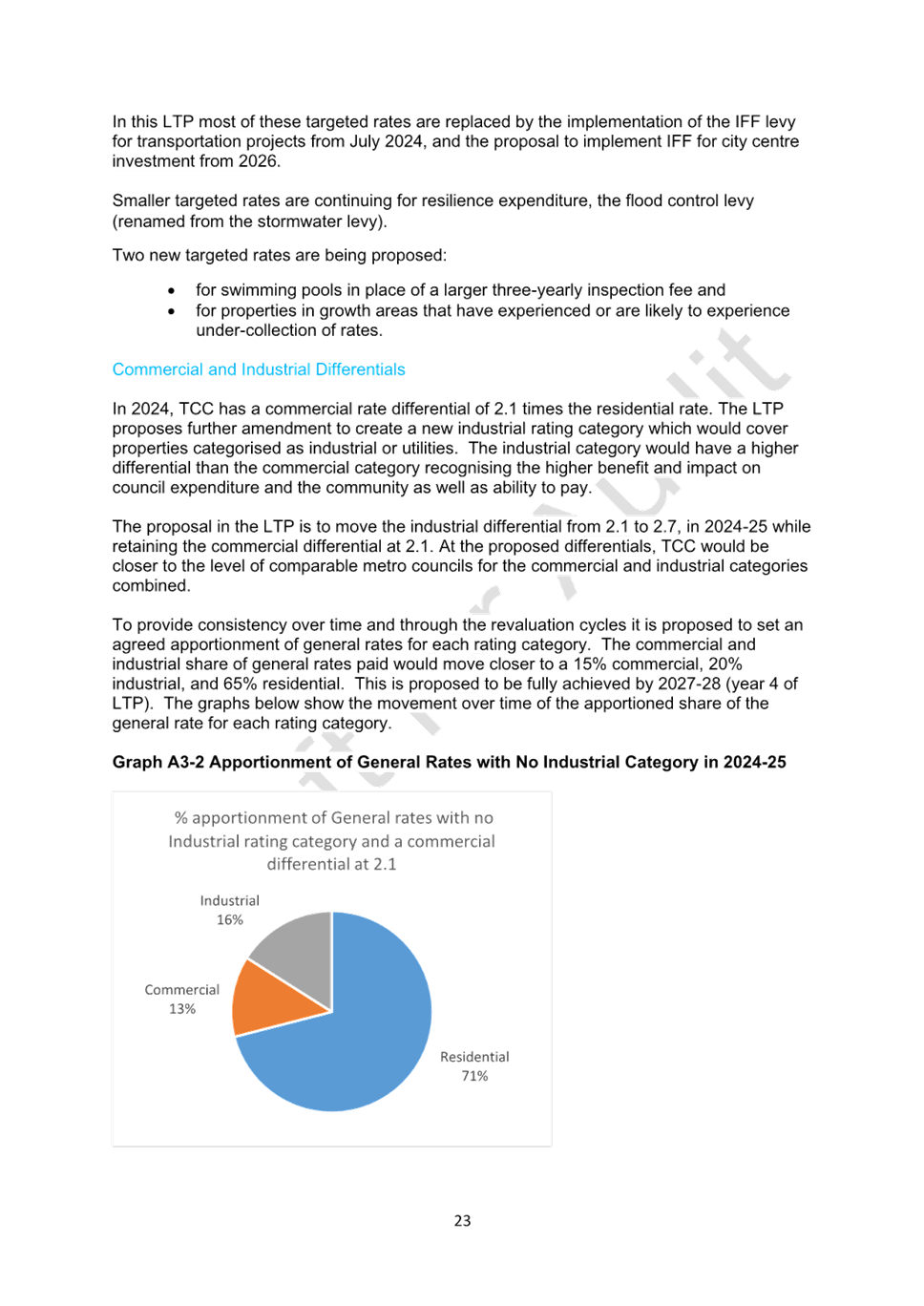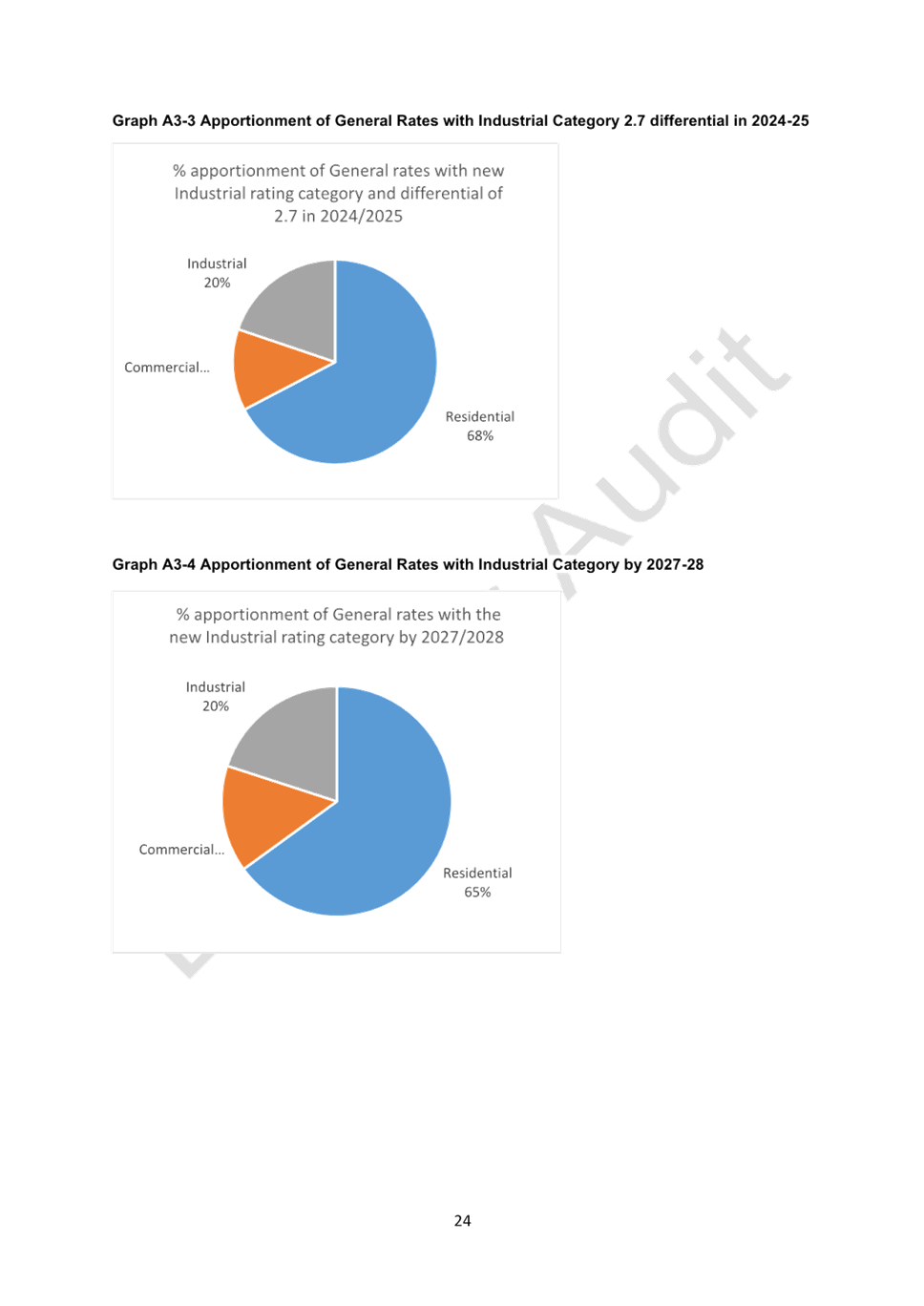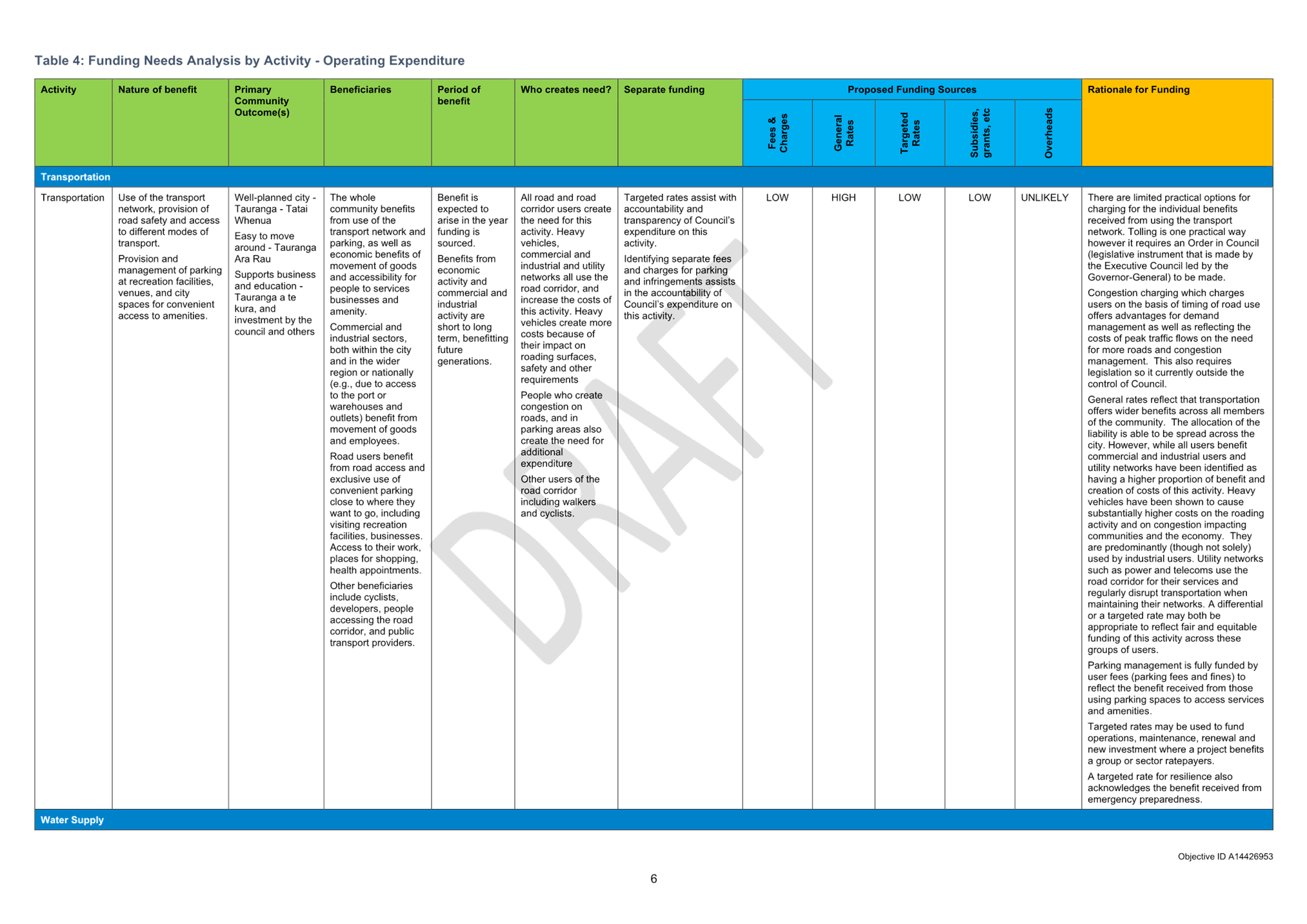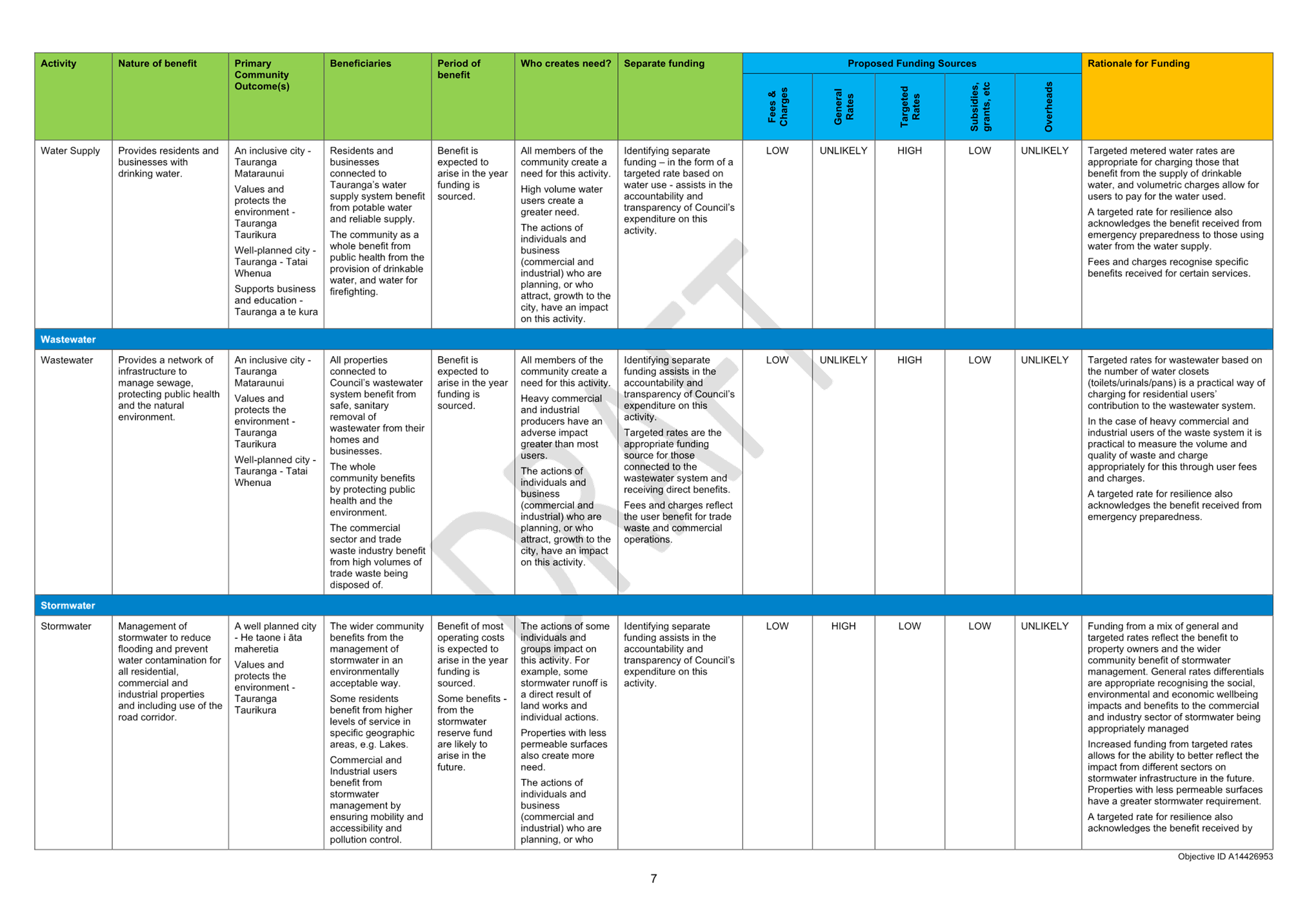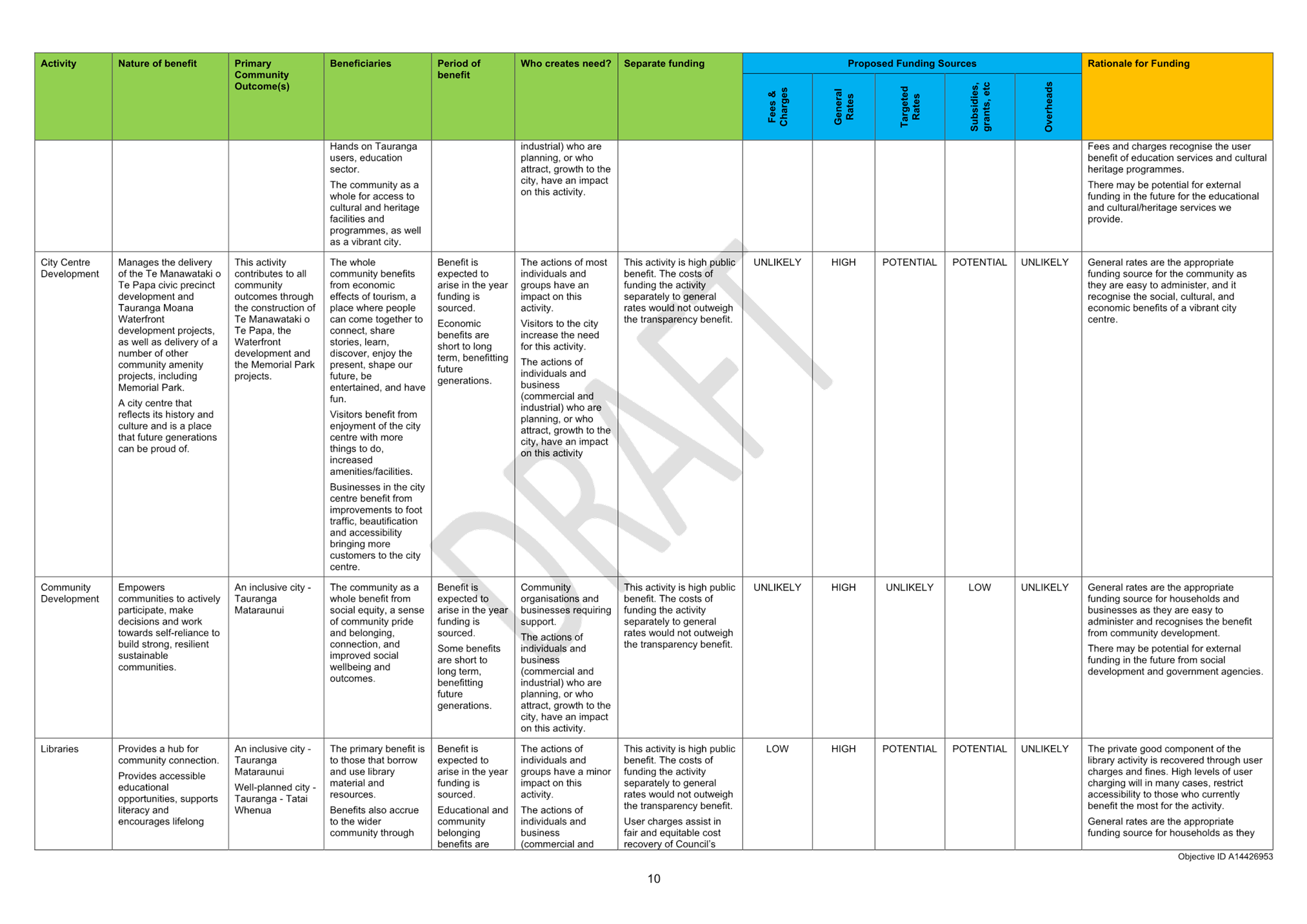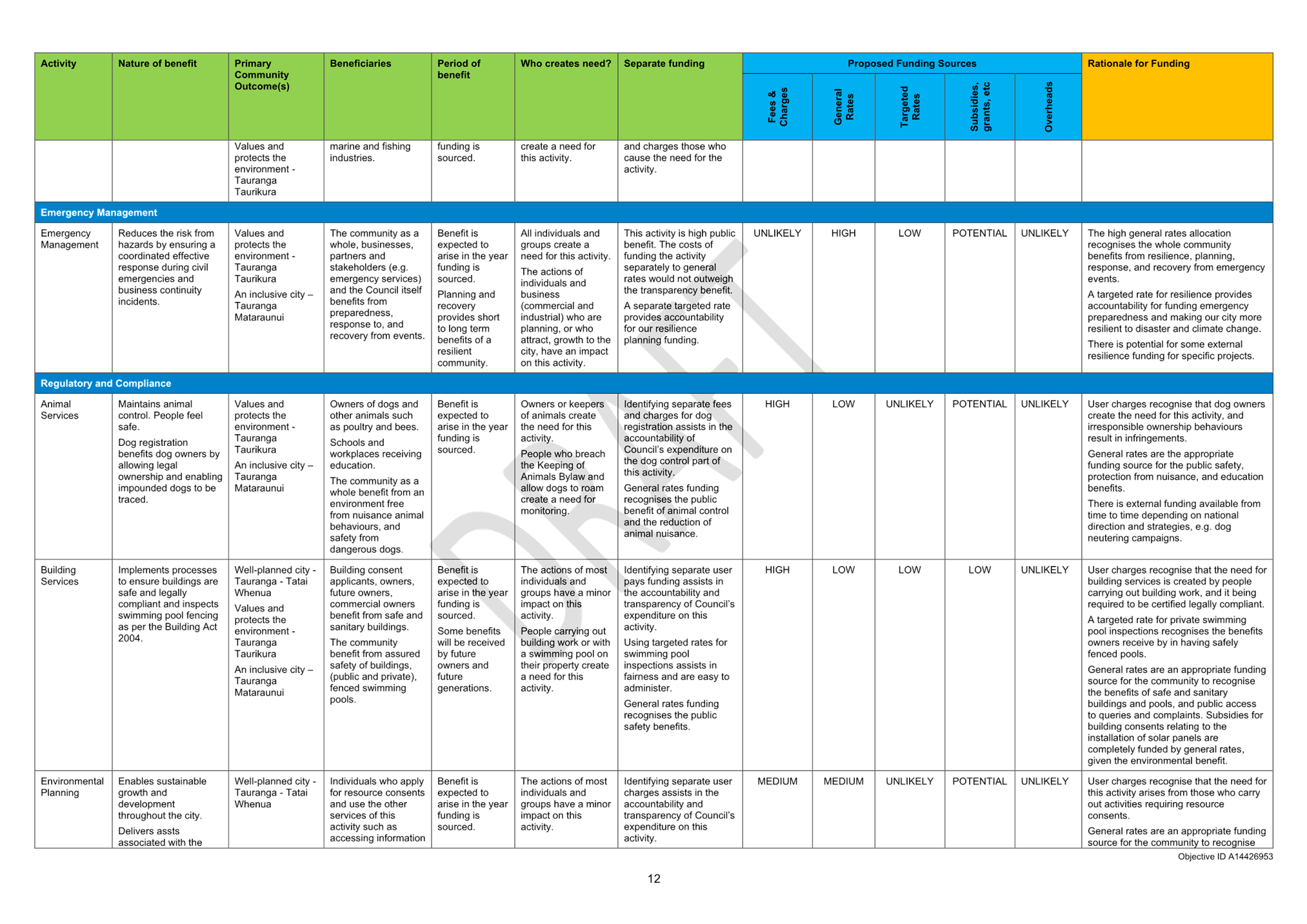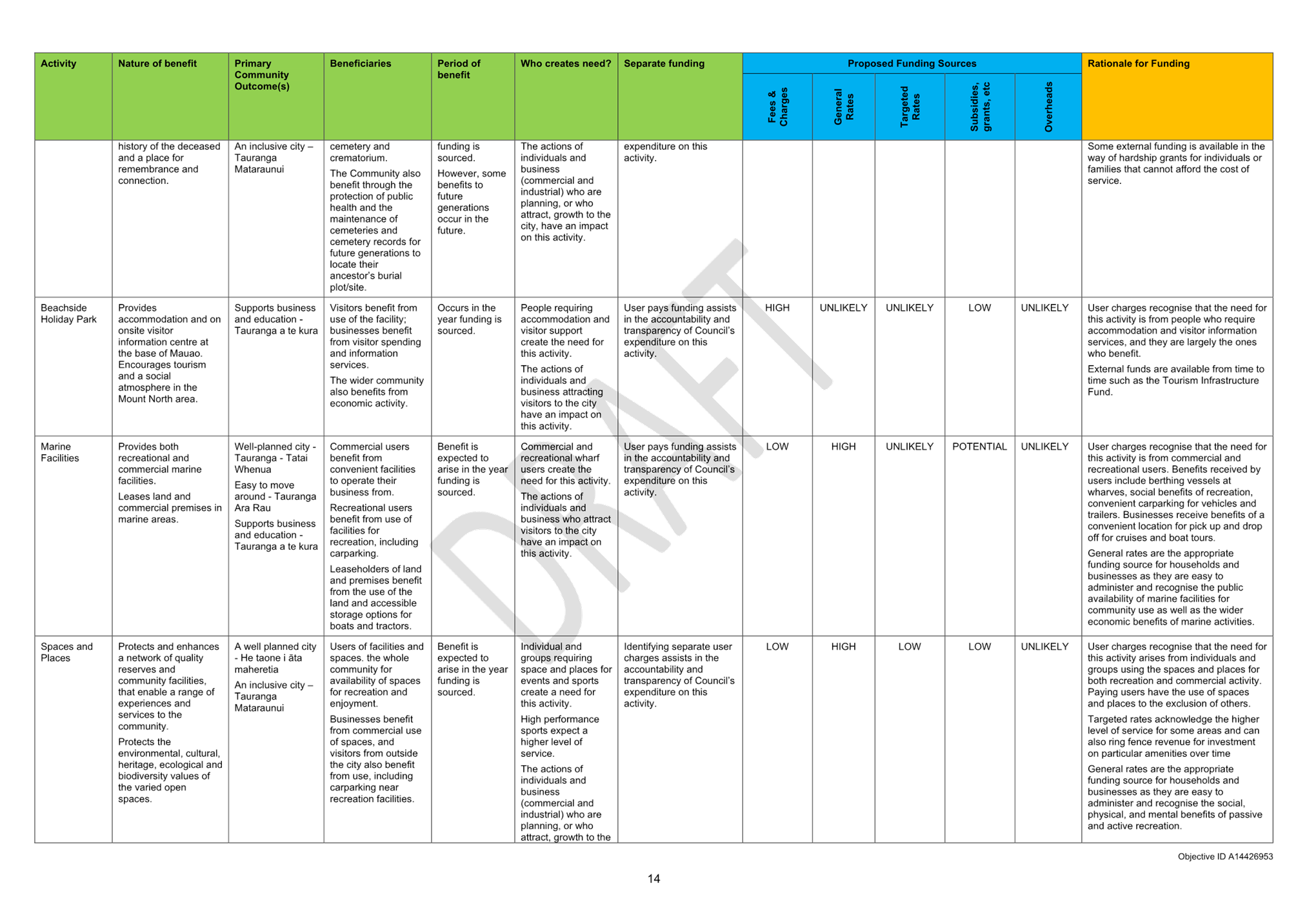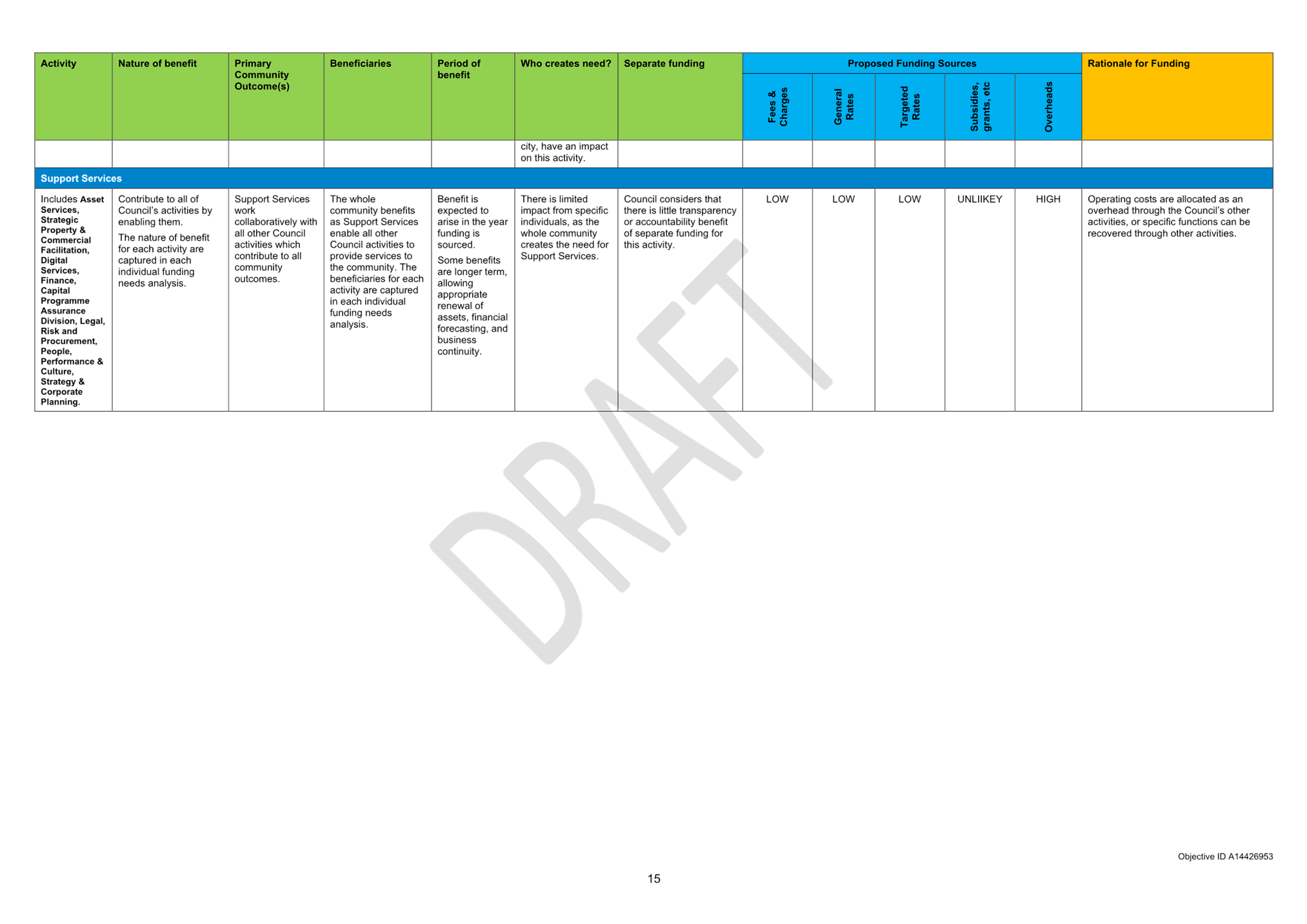|

|
|
AGENDA
Ordinary Council meeting
Monday, 11 September 2023
|
|
I hereby give notice that an Ordinary meeting of
Council will be held on:
|
|
Date:
|
Monday, 11 September
2023
|
|
Time:
|
9.30am
|
|
Location:
|
Bay of Plenty Regional Council Chambers
Regional House
1 Elizabeth Street
Tauranga
|
|
Please note that this
meeting will be livestreamed and the recording will be publicly available on
Tauranga City Council's website: www.tauranga.govt.nz.
|
|
Marty Grenfell
Chief Executive
|
Membership
|
Chairperson
|
Commission
Chair Anne Tolley
|
|
Members
|
|
|
Quorum
|
Half of the members
physically present, where the number of members (including vacancies) is even;
and a majority of the members physically present, where the number of
members (including vacancies) is odd.
|
|
Meeting frequency
|
As required
|
Role
·
To ensure the effective and
efficient governance of the City
·
To enable leadership of the City
including advocacy and facilitation on behalf of the community.
Scope
·
Oversee the work of all
committees and subcommittees.
·
Exercise all non-delegable and
non-delegated functions and powers of the Council.
·
The powers Council is legally prohibited from delegating include:
1. Power to
make a rate.
2. Power to
make a bylaw.
3. Power to
borrow money, or purchase or dispose of assets, other than in accordance with
the long-term plan.
4. Power to
adopt a long-term plan, annual plan, or annual report
5. Power to
appoint a chief executive.
6. Power to
adopt policies required to be adopted and consulted on under the Local
Government Act 2002 in association with the long-term plan or developed for the
purpose of the local governance statement.
7. All final
decisions required to be made by resolution of the territorial
authority/Council pursuant to relevant legislation (for example: the approval
of the City Plan or City Plan changes as per section 34A Resource Management
Act 1991).
·
Council has chosen not to delegate the following:
8. Power to
compulsorily acquire land under the Public Works Act 1981.
·
Make those decisions which are required by legislation to be made
by resolution of the local authority.
·
Authorise all expenditure not delegated to officers, Committees
or other subordinate decision-making bodies of Council.
·
Make appointments of members to the CCO Boards of
Directors/Trustees and representatives of Council to external organisations.
·
Consider any matters referred from any of the Standing or Special
Committees, Joint Committees, Chief Executive or General Managers.
Procedural matters
·
Delegation of Council powers to Council’s committees and
other subordinate decision-making bodies.
·
Adoption of Standing Orders.
·
Receipt of Joint Committee minutes.
·
Approval of Special Orders.
·
Employment of Chief Executive.
·
Other Delegations of Council’s powers, duties and
responsibilities.
Regulatory matters
Administration, monitoring and
enforcement of all regulatory matters that have not otherwise been delegated or
that are referred to Council for determination (by a committee, subordinate
decision-making body, Chief Executive or relevant General Manager).
|
Ordinary
Council meeting Agenda
|
11
September 2023
|
7 Confirmation
of minutes
7.1 Minutes
of the Council meeting held on 21 August 2023
File
Number: A15035780
Author: Anahera
Dinsdale, Governance Advisor
Authoriser: Anahera
Dinsdale, Governance Advisor
|
Recommendations
That the Minutes of the
Council meeting held on 21 August 2023 be confirmed as a true and correct
record.
|
Attachments
1. Minutes
of the Council meeting held on 21 August 2023
|
 Ordinary Council meeting minutes Ordinary Council meeting minutes
|
21 August 2023
|
|

|
|
MINUTES
Ordinary Council meeting
Monday, 21 August 2023
|
Order of Business
1 Opening karakia. 3
2 Apologies. 3
3 Public forum.. 3
4 Acceptance of
late items. 4
4.1 Acceptance
of late item - Draft Long Term Plan Operational Financials. 4
5 Confidential
business to be transferred into the open. 4
6 Change to the
order of business. 4
7 Confirmation of
minutes. 4
Nil
8 Declaration of
conflicts of interest 4
9 Deputations,
presentations, petitions. 4
10 Recommendations from other
committees. 4
10.1 Review
of Rating Categories to Differentiate Industrial Ratepayers. 4
10.2 Report
- 2024 - 2034 Long-term Plan - Update - Funding and Reserves. 5
11 Business. 5
11.1 2024-2034
Long-term Plan - Tauranga Community Stadium - update. 5
11.2 Draft
Long Term Plan 2024-2034 - Memorial to Elizabeth Waterfront Recreation
Connection \ Te Hononga ki Te Awanui 8
11.3 Our
Direction (Council's strategic framework) - adopt final action and investment
plans and strategies. 10
11.4 Tauranga
Climate Action and Investment Plan - adoption. 12
11.5 Long-term
Plan 2024 - 2034 Update. 13
11.6 Draft
Revenue and Financing Policy Framework. 15
11.7 Paying
a Fair Share - Approaches to Funding the draft 2024/34 Long-term Plan. 16
11.8 Review
of Rating Categories to Differentiate Industrial Ratepayers. 18
12 Discussion of late items. 19
13 Public excluded session. 19
14 Closing karakia. 20
MINUTES
OF Tauranga City Council
Ordinary Council meeting
HELD
AT THE Bay of Plenty Regional Council
Chambers, Regional House,
1 Elizabeth Street, Tauranga
ON
Monday, 21 August 2023 AT 9.30am
PRESENT: Commission
Chair Anne Tolley, Commissioner Shadrach Rolleston, Commissioner Stephen
Selwood, Commissioner Bill Wasley
IN ATTENDANCE: Marty
Grenfell (Chief Executive), Paul Davidson (Chief Financial Officer - via Teams),
Barbara Dempsey (General Manager: Community Services), James Woodward (Acting General
Manager: Infrastructure), Jeremy Boase (Acting General Manager: Strategy,
Growth & Governance), Sarah Omundsen (General Manager: Regulatory and
Compliance), Gareth Wallis (General Manager: City Development &
Partnerships), Kelvin Eden (Capital Programme Manager: Major Community
Amenity), Anne Payne (Principal Strategic Advisor), Nick Chester (Principal
Strategic Advisor), Sarah Searle (Principal Strategic Advisor), Kathryn
Sharplin (Manager: Finance), Tracey Hughes (Financial Insights & Reporting
Manager), Malcolm Gibb (Project Manager – Rating Review), Reece Wilkinson
(Parking Strategy Manager), Coral Hair (Manager: Democracy & Governance
Services), Sarah Drummond (Governance Advisor), Anahera Dinsdale (Governance
Advisor), Janie Storey (Governance Advisor)
1 Opening
karakia
Commissioner
Shadrach Rolleston opened the meeting with a karakia.
2 Apologies
Nil
3 Public
forum
Mr Murray Guy interjected
from the public gallery and objected to not been given permission to speak in
the public forum. Mr Guy was asked by the Chairperson to sit down. The
Chairperson cautioned Mr Guy to stop disrupting the meeting or she may ask him
to leave the meeting. Mr Guy continued to interject and refused to leave,
and the Chairperson advised Mr Guy that he was required to withdraw immediately
as his conduct was disorderly and creating a disturbance.
Mr Guy continued to
interject, and the Chairperson advised Mr Guy that she was now requesting
staff/security personnel to remove him from the meeting for the rest of the
meeting as his conduct was disorderly and creating a disturbance.
The Chairperson adjourned
the meeting at 9.37 am and Mr Guy left the room.
At 9.41am the meeting
reconvened.
4 Acceptance
of late items
|
4.1 Acceptance
of late item - Draft Long Term Plan Operational Financials
|
|
Resolution CO14/23/1
Moved: Commissioner
Shadrach Rolleston
Seconded: Commissioner Bill Wasley
That the Council:
(a) Accepts
the late tabled item “Draft Long Term Plan Operational
Financials” for consideration in the report “Long Term Plan
2024-2034 update at the meeting:
The above item was not
included in the original report because it was not available at the time the
agenda was issued, and discussion cannot be delayed until the next scheduled
meeting of the Committee because a decision is required in regard to this
item.
Carried
|
5 Confidential
business to be transferred into the open
Nil
6 Change
to the order of business
Nil
7 Confirmation
of minutes
Nil
8 Declaration
of conflicts of interest
Nil
9 Deputations,
presentations, petitions
10 Recommendations
from other committees
|
10.1 Review
of Rating Categories to Differentiate Industrial Ratepayers
|
|
Staff Paul
Davidson, Chief Financial Officer
|
|
Resolution CO14/23/2
Moved: Commissioner
Stephen Selwood
Seconded: Commissioner Shadrach Rolleston
That the Council:
(a) Receives
the report "Review of Rating Categories to Differentiate Industrial
Ratepayers
(b) Approves
the recommendations of the Strategy, Finance and Risk Committee to consider
introducing a new rating category for industrial properties (Option 1) in the
development of the 2024-34 Long-term Plan.
Carried
|
|
10.2 Report - 2024 - 2034
Long-term Plan - Update - Funding and Reserves
|
|
Staff Paul
Davidson, Chief Financial Officer
|
|
Resolution CO14/23/3
Moved: Commissioner
Bill Wasley
Seconded: Commissioner Shadrach Rolleston
That the Council:
(a) Receives
the report "Report - 2024 - 2034 Long-term Plan - Update - Funding and
Reserves".
(b) Approves the recommendations
of the Strategy, Finance and Risk Committee that the following matters are
considered in the LTP to address both the significant impacts of large asset
revaluations on depreciation and the current risks and impacts on the
depreciation reserves.
(i) Phasing in of
increased funding of depreciation expense in the early years of the LTP to
mitigate the otherwise significant up-front increases in rates arising from
significant asset revaluation.
(ii) Restoring
depreciation funding and the level of reserve balances within the ten years
of the LTP.
(iii) Short term loan funding of
capital renewals for activities where there are insufficient depreciation
reserves.
(iv) additional rates funding to
retire debt for those activities where there are insufficient depreciable
assets to repay debt over time.
(c) Approves
the recommendations of the Strategy, Finance and Risk Committee that the
phased retirement of debt in the weathertight and unfunded liabilities
reserve subject to rates affordability should aim to significantly reduce
these reserve deficits through the period of the LTP.
(d) Approves
the recommendations of the Strategy, Finance and Risk Committee to consider
the value of risk reserve funded through the LTP taking into account both
debt headroom maintained in the debt to revenue ratio below LGFA funding
limits and the value of the reserve.
Carried
|
11 Business
|
11.1 2024-2034 Long-term
Plan - Tauranga Community Stadium - update
|
|
Staff Gareth
Wallis, General Manager: City Development & Partnerships
Kelvin Eden, Capital
Programme Manager: Major Community Amenity
Jeremy Boase, Acting
General Manager, Strategy, Growth and Governance
External Nigel
Tutt – Priority One
Key points
·
The work to date had been a team effort with a number of people
involved.
·
Public engagement had included a survey carried out by Key
Research, which was a demographically representative view and resulted in
more people in favour of the stadium than not in favour.
·
There was more support with the younger age group and males but
this diminished when the questions got to willingness to pay.
·
A self-select survey was carried out via a link, however there
were more negative comments and misinformation sent out by groups which
coloured the results somewhat. Some support letters had been received
from businesses and individuals who were generally in favour of the stadium.
·
Benefits included the attraction of events and the alignment of
the CBD rejuvenation with negative comments including parking and disruption.
·
The social and economic benefits outlined by Market Economics
was more comprehensive and outlined the many benefits that could be realised
across the Western Bay of Plenty and the wider Bay of Plenty.
·
The facility would take the load off Baypark as it was
currently at capacity with more facilities needing to be provided. The
economic development report outlined that the lack of investment in community
amenities also led to poor attraction and retention of talent, and there was
a need to ensure there was a good workforce into the future.
·
Investigations had been commenced to set up a charitable trust
to generate external funding for civic amenities.
·
Key risks included ground conditions. Initial geotech reporting
had been undertaken, based on the information to hand, showed an additional
$9M would need to be included for the grandstand than what was included in
the business case, but more borehole testing was needed on the site.
There may be a possibility to decrease the length of the piles which would
result in a lesser cost. There was also some slope stability and retaining
work required on the western bank which could cost up to $19M in the
worst-case scenario.
·
Continued engagement was being undertaken with the athletic,
bowls and croquet clubs and other users.
·
Consideration was being given to the relocation of the athletic
track to Baypark in the long term. The current track would need to be
replaced in 2028 and had a useful lifespan up until then.
·
The lawn bowls and croquet clubs’ leases were due to
expire in 2029 and the team were working through some relocation options with
them.
·
The recommendation was to push out the development of the
stadium in association with the wider masterplan to relocate users and the
development of the Te Manawataki o Te Papa precinct.
·
Option 2 was the preferred option, with a staged plan and
thorough community consultation, with the project team continuing to work on
funding mechanisms and staging the design and cost. Once the project
was included in the 2024-34 Long Term Plan (LTP) for deliberation there would
be more community feedback and more information to guide the decision
making.
In response to questions
·
In relation to a query regarding the cost, access to external
funding and engagement with regional and sub-regional partners to share the
costs, it was noted that the cost of developing the first stage was estimated
at $70M, which was subject to what was to be built. The $30M
relating to displacement costs was already in the budget as part of the
Active Reserves Masterplan work.
Discussion points raised
Commissioners noted the
following comments:
·
There was a divided view within the community and the
recommendations set a clear pathway for the need for further consultation.
·
Option 2, the staged implementation plan, would be out for
consultation as part of the LTP and would provide opportunities for all the
community to express their views.
·
The Commission was appointed to provide and focus on the long-term
best interests of the city it serves. This included infrastructure and
community amenities, of which sporting and wider community amenities and
facilities were a key component of a great city.
·
The proposal provided existing users to have their current
needs met and provided opportunities for them to have better amenities as a
result of the decision. Some clubs also had divided views.
·
The proposal would have wider social and economic benefits
across the city and would release the capacity at Bay Park which was not able
to accommodate some indoor sports because of lack of space.
·
Commissioners needed to consider both sides of the story based
on the evidence and information before any decision was made. The
process had started before the Commission commenced and it would do the
community a disservice if the Commissioners did not follow through with this
process and make a considered decision as part of the LTP 2024-34.
·
The two surveys were helpful in terms of perspectives provided
and understating the demographic of those inputting, and to get a full
perspective of age groups across the city.
·
There were 4,000 new residents entering the city each year and
more coming into the Western Bay of Plenty, with a projected population for
the sub-region in 2063 being 300,000. This was a 50% increase from
2018. Council needed to respond to the transformation, recognise that
growth, listen to the needs of those coming to live here and provide for
them.
·
There had been a lot of misinformation of what the stadium was
going to be and seeks to do for the community. It would not be locked
up and unattainable on a daily basis, it would still be a community
greenspace valued by the community and the public would continue to have
access, there would be no restricted access to the Domain.
Activities would include rugby, soccer, cricket, indoor sports, events and
concerts and the proposed stadium would provide for all opportunities.
·
Parking and noise were some of the concerns expressed, and
while these needed to be carefully considered. The Council was exploring with
the Bay of Plenty Regional Council better transport options and opportunities
to move around the city more easily.
·
The Commission would protect and look after the trees in the
Domain during this process.
·
Financially the city could not afford the stadium at present
with the building of Te Manawataki o Te Papa. The proposal would not be
included into the budget in the next few years.
·
Working in with the athletic club to relocate their track by
its use by date made sense. It would take time to move some of the
existing users from the site and to make sure that they were well looked
after and provided for with better facilities.
·
Council was required by law to make room for more housing to
cope with the growing population and had a responsibility to the young people
to increase the economic activity in the city.
·
Growth had not adequately been addressed in the last two
decades which had overwhelmed the city but now it had to be managed.
With the underinvestment in infrastructure and the city centre dying,
Commissioners had to make hard decisions on what was best for the long-term
interests of the city and make investments.
·
There was a clear divide between the young and older residents,
but Council needed to look at what was best for the city in next 30 years.
The underinvestment in community facilities had been obvious and resulted in
the Commission reviewing all community facilities. This including
looking at The Domain which could take more use by more people on a regular
basis.
|
|
Resolution CO14/23/4
Moved: Commissioner
Stephen Selwood
Seconded: Commissioner Bill Wasley
That the Council:
(a) Receives
the report "2024-2034 Long-term Plan - Tauranga Community Stadium -
update".
(b) Approves
Option 2 – Staged Implementation Plan for inclusion in the draft
2024-2034 Long-term Plan, and budgets and consultation document. Current
details of this option include:
(i) Staged
delivery of the stadium commencing in 2029/30.
(ii) Capital
expenditure of $70 million for the first stage of which $40 million is
financed for budgeting purposes from rates-funded loans and $30 million from
other sources.
(iii) Balance
of the capital expenditure budget to be incurred beyond the term of the
2024-2034 Long-term Plan.
(iv) Operating
costs of $1 million per annum, plus appropriate debt servicing and
depreciation allocations.
(v) Continuation
of work with existing users of the Tauranga Domain to explore alternative
site options (e.g. athletics, bowls and croquet).
(vi) Continuation
of efforts to secure non-council funding for the capital costs of the
community stadium.
(c) Notes
that further details of the ‘staged implementation plan’ approach
will be established prior to the adoption of the final 2024-2034 Long-term
Plan, currently scheduled for April 2024.
(d) Approves
unbudgeted expenditure of a maximum of $900,000 in 2023/24 to further develop
and cost the ‘staged implementation plan’ option, and to seek
funding contributions from other project partners to share these costs.
Council’s share of the expenditure to be loan-funded operating expenditure, based on the expenditure
offering long-term benefit associated with the proposed investment. Rate
funded debt retirement over ten years should be included in the budgets from
2024/25 onwards.
(e) Attachment
4 can be transferred into the open when all funding negotiations have
been completed.
Carried
|
|
11.2 Draft Long Term Plan
2024-2034 - Memorial to Elizabeth Waterfront Recreation Connection \ Te
Hononga ki Te Awanui
|
|
Staff Gareth
Wallis, General Manager: City Development & Partnerships
Kelvin Eden, Capital
Programme Manager: Major Community Amenity
External Rebecca
Ryder – Boffa Miskell
Craig Batchelor –
Independent Consultant
Rachel Wright –
Boffa Miskell
Key points
·
The work began in 2021 to consider a walkway from Memorial Park
to the CBD in two parts, stage 2 of which was to provide an extended harbour
edge connection between Memorial Park and the city centre.
·
Objectives were adopted in July 2022 to understand the key
priorities and became the focus for all of the project.
·
Engagement was undertaken with tangata whenua and one on one
meetings with landowners with waterfront-based properties to understand their
needs, interests and issues on the recreation connection in front of their
properties. A meeting was also held with the Tauranga Harbour
Protection Society on 5 March 2023 where discussions were held in detail.
·
There were 10 different topology options and 17 properties with
riparian rights for which the property rights were investigated.
·
Two workshops in May 2023 had also been held covering off the
options and to get the three viable options that were noted within the report.
These had been further informed from the workshops and focused to the public
realm area and dropping some of the components that had been raised by
landowners as a way of responding to them.
·
Each of the three options had been considered against the
planning framework requirements for district, regional and national coastal
plans. Most came under the Regional Environmental Coastal Plan as they
were all discretionary activities with lots of assessments required.
·
While there were no critical issues to obtaining a resource
consent, a real critical risk was around resolving the riparian rights,
property and access rights with the property owners. The property
owners’ legal advisor proposed that the Council look at a declaration
from the High Court on the legality of what’s proposed. The view
of the landowners was that any infringement of their access across their
frontage was contrary to their legal rights, however the Council’s
legal advice was that this could be managed and ensure that their rights could
be provided for in a reasonable way. The intention is to develop design
solutions and have those tested with evidence before a high court or other
alternative. It was critical this be sorted before any resource consent
process was undertaken.
·
There were also issues around hazard management in the long
term, as the area was affected by land instability and complications of a
walkway, including mitigation and repair work, as some properties had
structures close to the space.
·
While the matters were complex, these were not insurmountable.
·
The team was not in a position to recommend that the funding be
put into the LTP but were seeking funds to proceed with the design and go
through the legal processes. This highlighted the opportunity to use the $6M
already included in the LTP and provide time to design avenue connections to
allow public access to the waterfront and low tide access to the CBD.
It would also allow proceeding with some capital works where they were able
to achieve access.
·
The team thanked all residents and landowners that they had
engaged with, they had been welcomed into many homes and spent time with
people who were passionate about their properties and had held some robust
and challenging conversations.
In response to questions
·
If Option C, limited intervention, was adopted it would remain
as it was and no declaration from the court would be required.
·
The use of the $6M would include creating the nodes, beach
replenishment where it was a viable option and creating the walkway in areas
that were not subject to riparian rights as included in the 2021-31 LTP for
the years 2026-27. In parallel with that, work would be carried out to
get the High Court determination and set up a Memorandum of Understanding
with tangata whenua.
·
Beach replenishment has been seen as a positive concept with a
number of property owners, with an issue raised as to whether it would lead
to accretion and if so, would landowners be able to claim the land.
While this was not considered a risk, any claim would become a court
process.
·
The team were aware of pending iwi claims and potential changes
around the sea floor and this had been part of the conversation with tangata
whenua. Part of the process going forward was that they be included in
each step to avoid any issues later. Engagement with mana whenua had
been positive to date.
Discussion points raised
·
Commissioners acknowledged the work done by Boffa Miskell and
Tonkin and Taylor noting that the evidence-based information with the
comprehensive engagement, analysis, range of issues and considerations had
been helpful.
·
Additions were made to the recommendations to include the
amount of the consultancy costs in recommendaitons (c) and (d) and to provide
a determination of the legal position regarding property right issues.
|
|
Resolution CO14/23/5
Moved: Commissioner
Bill Wasley
Seconded: Commissioner Stephen Selwood
That the Council:
(a) Receives
the report "Draft Long Term Plan 2024-2034 - Memorial to Elizabeth
Waterfront Recreation Connection \ Te Hononga ki Te Awanui".
(b) Approves
delivery of Option C, which is limited intervention of the city fringe and
escarpment link zones from 1st to 7th Avenue, which may
include some beach replenishment between 6th and 7th
Avenues as an achievable short/medium-term outcome, acknowledging that it
does not achieve the accessible linear connection along the shoreline but
does however, improve public access at the road ends to the harbour edge.
(c) Approves
consultancy costs of $585,000 to progress the consenting, legal, planning and
design work for short/medium-term Option C, acknowledging
the construction costs of $6M, which are currently included in the Draft
Long-term Plan 2024-2034.
(d) Approves
consultancy costs of $1.65M to progress the consenting, legal, planning and
design work for long-term Option B, including determination of the legal
position regarding property right issues. Any construction costs to be
considered as part of deliberations for the following long-term plan.
(e) Enters into a Memorandum of
Understanding with Mana Whenua.
Carried
|
|
11.3 Our Direction
(Council's strategic framework) - adopt final action and investment plans and
strategies
|
|
Staff Anne
Payne, Principal Strategic Advisor
Jeremy Boase, Manager: Strategy & Corporate Planning
Nick Chester, Principal Community Advisor
Key points
·
The project work had begun in mid-2021 with action and
investment plans being developed in 2022 to deliver on Council’s
strategic directions.
·
Eight plans were being presented as part of this report and the
Tauranga Climate Action and Investment Plan would be presented in a separate
report to this meeting.
·
Two strategies had been held in draft until the Action and
Investment Plans were completed to ensure consistency across the framework.
·
As a result of the plans, 10 strategies could be superseded.
In response to questions
·
In relation to beliefs being omitted from the Community Centres
Action and Investment Plan opening statement it was noted that citizenship
ceremonies were held every month with 70-80 people from a variety of
denominations and religious beliefs becoming New Zealand residents and it was
noted that the city needed to make room for those beliefs as they were a
strong part of people’s cultures. Staff apologised for the
miscommunication and agreed to add beliefs back into the opening statement.
Discussion points raised
·
Commissioners acknowledged that the plans had been a huge
amount of work and staff had been challenged at every step. They noted
their appreciation for the work from all of the team for such a good and
robust process.
·
It was requested that if the framework for accessing the plans
was on the website, was it possible to have a diagram as the link point to
funding as this was important.
·
It was suggested that an increased focus was needed on the use
of grey water and the opportunities this would bring.
·
It was requested that the names of the Action and Investment
Plans be included in the recommendation (e), the inclusive city strategy
added into recommendation (f) and the plans that were to be superseded in
recommendation (i).
|
|
Resolution CO14/23/6
Moved: Commissioner
Bill Wasley
Seconded: Commissioner Stephen Selwood
That the Council:
(a) Receives the report
"Our Direction (Council's strategic framework) - adopt final action and
investment plans and strategies", including Attachments 1 to 5 to this
report.
(b) Acknowledges and thanks Te
Rangapū Mana Whenua o Tauranga Moana, particularly the appointed AIP
representatives, for their valuable contribution to development of these
plans and strategies.
(c) Acknowledges and thanks the
many other groups, organisations and individuals from our communities who
have also provided valuable contributions to development of these plans and
strategies.
(d) Approves the eight Action
and Investment Plan consultation feedback and proposed response summaries,
July 2023, contained in Attachment 1, including the resultant
proposed amendments to the draft plans.
(e) Adopts the eight Tauranga
City Council Action and Investment Plans contained in Attachment 2 (Appendices
A to H), namely:
Accessible Tauranga,
Safer Communities,
Art, Culture and Heritage,
Our Public Places Strategic Plan,
Reserves and Open Space,
Play, Active Recreation and Sport,
Community Centres,
Nature and
Biodiversity
and notes
that the eight adopted plans will be:
(i) Updated to reflect
final 2024-2034 Long-term Plan funding once the Long-term Plan is adopted in
April 2024, and
(ii) Available online as
designed documents in early October 2023, with printed copies available on
request.
(f) Adopts Tauranga City
Council’s Tauranga Mataraunui – Inclusive City Strategy, 2023-2033,
contained in Attachment 3, noting the summary of final changes
provided and that the strategy’s opening aspiration statement is to be
retained as:
We lift
each other up. We are an inclusive city that celebrates our past, is
connected in our present and invested in our future, where people of all
ages, beliefs, abilities and backgrounds are included, feel safe, connected
and healthy.
(g) Adopts Tauranga City
Council’s Tauranga Taurikura – Environment Strategy,
2023–2033, contained in Attachment 4, noting the summary of
final changes provided.
(h) Delegates the Group Manager:
Strategy, Growth and Governance to approve minor amendments to the eight
Action and Investment Plans and two strategies if required prior to
publication.
(i) Formally supersedes or
rescinds the ten existing strategies or plans as proposed in section C
of this report, and notes that partners to any superseded joint strategies or
plans will be advised accordingly, namely
Age-Friendly Strategy 2013
Disability Strategy 2013
Tauranga Western Bay Safer Communities Strategic Plan
2020-2025
City Safety Action Plan 2018
Toi Moana Arts and Culture Strategy 2018-2021
Vegetation Management Strategy (Growing Tauranga
Green) 2006
Aquatic Network Strategy 2012
Open Space Strategy 2012
Our Community Places Strategy 2008
Sport and Active Living Strategy 2006
(j) Notes
that, subject to today’s decisions, Tauranga City Council’s
strategic framework, Our Direction, has now been refreshed and is
presented on Council’s Our Future / Our
Direction webpages. A summary of where strategies and plans fit is
contained in Attachment 5 of this report.
Carried
|
|
11.4 Tauranga Climate Action
and Investment Plan - adoption
|
|
Staff Sarah
Searle, Strategic Advisor
Jeremy Boase, Manager: Strategy & Corporate Planning
Key points
·
Working with dedicated interested group to create the first
climate action plan which would continue to be updated and improved.
In response to questions
·
In relation to priority actions 33 and 34 regarding
sub-regional waste it was noted that the business case was currently being
reworked, and funding was provided in the LTP. It was requested that
regional input would also be sought.
·
Staff would recheck priority 34 as to whether a community
recovery and waste minimisation education centre was still proposed due to
lack of room on the site.
·
Additional information would be provided on the sources of
funding for priority 56 – the Mana Kai Mana Ora - WBoP Food Sovereignty
and Food Security Plan.
·
In response to a comment regarding any meaningful change to
reducing carbon emissions through road pricing, it was noted that the LTP
needed to start that conversation for it to gain momentum across the city.
·
Much of the feedback was challenging the concept of having
alternative modes of transport available before changing the targets.
Discussion points raised
·
While ambitious goals could be set there was no way they would
ever be reached in the city, therefore the plan needed to be realistic to encapsulate
that some targets would be met, but also acknowledging that there was no way
to achieve some of the science-based targets as some of the changes needed
were not ones that the Council could influence. The goal around
mitigation was amended in resolution (e) - as a city we will work towards
reducing our greenhouse gas emissions in line with national net zero 2050
commitments.
·
Commissioners thanked the staff, Te Rangapū Mana Whenua o
Tauranga Moana and others for the significant amount of the work done to
provide the plan.
|
|
Resolution CO14/23/7
Moved: Commissioner
Bill Wasley
Seconded: Commissioner Shadrach Rolleston
That the Council:
(a)
Receives the report " Tauranga Climate
Action and Investment Plan - adoption" including attachments 1
and 2.
(b)
Acknowledges and thanks Te Rangapū Mana Whenua o Tauranga Moana
for their valuable contribution to development of the Plan.
(c)
Acknowledges and thanks the many other groups, organisations and
individuals from our communities who have also provided valuable
contributions to development of the Plan.
(d)
Approves the Action and Investment Plan consultation feedback and
proposed response summary, July 2023, contained in Attachment 1,
including the resultant proposed amendments to the Plan.
(e)
Approves the updated goal around mitigation to “as a city we
will work towards reducing our greenhouse gas emissions in line with national
net zero 2050 commitments”
(f)
Adopts the Tauranga Climate Action and Investment Plan, 2023-2033,
contained in Attachment 2, and notes that the adopted Plan will be:
(i)
Updated to reflect final 2024-2034 Long-term Plan funding once the
Long-term Plan is adopted in April 2024, and
(ii)
Available online as a designed document in early October 2023, with
printed copies available on request.
(g)
Delegates the Group Manager: Strategy, Growth and Governance to
approve minor amendments to the Plan if required prior to publication.
Carried
|
At 11.35am the meeting adjourned.
At 11.49am the meeting reconvened.
|
11.5 Long-term Plan 2024 -
2034 Update
|
|
Staff Paul
Davidson, Chief Financial Officer
Kathryn Sharplin, Manager: Finance
Tracey Hughes, Financial Insights & Reporting Manager
Tabled were a copy of the Draft
LTP Operational Financials prior to final decisions.
Key points
·
The budget reflected the recommendations made by the Strategy,
Finance and Risk Committee in relation to lessening the funding of
depreciation in the early years and reversing it in later years and
reflecting the size and scale of the revaluations that had occurred.
·
The LTP increased debt requirement of unfunded liability and
weathertightness reserves after year 3 of the LTP and sought resolution
around long-term loan funding where there was a long-term
benefit.
·
It assumes that the infrastructure funding and financing (IFF)
transactions for decisions on Te Manawataki o Te Papa were included but this
would be separately consulted in the next month.
·
No IFF levy had been added in the rates which would be an
additional 2% in 2026 to reflect that transaction. All of the debt had been
included in the budget.
·
The financials reflect the priorities set for the LTP as a flow
through from 2021-31 priorities
·
The capital programme summaries were high level capital
expenditure in the key priority areas of existing growth, intensification,
growth in the west, the city centre and transportation. In total $3.4B over
the 10 years.
·
There was a programme of works was larger in the earlier years
than Council expected to achieve, so debt and interest would not be
rated. There was a capital ability adjustment to bring it to more
realistic associated rate increases.
·
Three waters had not been included from Year 3 and changes to
the existing programme of funding for Te Manawataki o Te Papa and ongoing
changes for Tauriko West funding .
·
The operational financials were tabled. The capital
programme and the flow through costs that come from interest were influenced
by the expectation of external funding or asset realisation for Te Manawataki
of Te Papa of $150M and Waka Kotahi supporting the transportation capital
programme. If the funding was not realised the ratios would be worse
and decisions would need to be made around timing of those projects.
·
The revenue included those assumptions, and the growth was
expected to be 1%.
·
The medium rates increase modelling was based on the first year
only and included the transport plan and the IFF which had already been
agreed to.
In response to questions
·
In response to a question regarding the Department of Internal
Affairs (DIA) approval on the stormwater levy being renamed to the flood
control reserve, it was noted that they would look at the draft.
Discussions had been held with DIA staff around remediation of those areas
and addressing future flooding, but it would be put through as part of the
consultation process. Flood control activities were a legislative set
activity for councils after movement of three waters to a separate entity.
·
In relation to clarity around the funding of depreciation cost
funding over the life of the LTP now and as new completed projects were
brought in with messaging around addressing the inadequate funding
previously. It was noted that would be included in the financial strategy
and reserves identified for each activity over the ten years.
|
|
Resolution CO14/23/8
Moved: Commissioner
Bill Wasley
Seconded: Commissioner Shadrach Rolleston
That the Council:
(a)
Receives the report developing LTP Budgets.
(b) Receives the tabled draft
financials based on continuation of the strategic direction set in the
2021-31 LTP for both capital and operational expenditure, to be further
amended as decisions are made by Council at this meeting.
(c) Agrees to draft capital
budgets for the LTP as summarised in Attachment A as the basis for LTP
draft financials, and consultation which includes:
(i) updated
projects from 2021-31 LTP with revisions to cost and timing
(ii) new
projects and revised scope for projects from previous council decision or
Chief Executive delegation for minor projects.
(d) Agrees
to include the following funding decisions with respect to operational costs:
(i) the
phasing in of funding of depreciation across activities of council and CCOs
through the period of the LTP and other approaches to manage depreciation
reserves back into balance
(ii) increasing
debt retirement of unfunded liability and weathertight reserve deficits after
year 3 of the long term plan
(iii) phasing
further rates funding to the risk reserve over the period of the LTP
(iv) Renaming
of the stormwater reserve to flood control reserve to remain with Tauranga
City Council in the new Flood Control activity after movement of three waters
to a separate entity
(v) Increases
in user fees and adoption of additional user fees
(vi) loan
funding of operational costs associated with a portion of the increased
expenditure on climate action and sustainability and of software as a
service-related development, where this work provides benefit of a long-term
nature
(vii) Phasing in of additional
operational grant to Bay Venues Limited
(e) Agrees to develop financials
on the basis of using Infrastructure Funding and Financing through IFF levy
to fund the ratepayer portion of Te Manawataki o te Papa.
(f) Notes that full
financials and funding impact statements by activity will be presented within
the groups of activities to the September 11 Council meeting and financial
statements in the supporting documentation.
Carried
|
|
Attachments
1 Tabled
Document - Council - Draft LTP financials 21 Aug 2023
|
|
11.6 Draft Revenue and
Financing Policy Framework
|
|
Staff Paul
Davidson, Chief Financial Officer
Kathryn Sharplin, Manager: Finance
Key points
·
All of paragraph 23 in the report was incorrect and should be
removed as neither Site B nor the stadium were included in the draft
financials.
·
The policy incorporated IFF as a preferred option and would be
looking at an industrial rating category as an option later in the meeting.
·
A specific annual targeted rate was being considered for
private pool inspections as an alternative to a user fee.
In response to questions
·
In response to being able to revert back to a community
facilities targeted rate if required, it was noted that this was being
consulted on and staff would come back with any provisions that may come out
of that process.
·
The IFF would be consulted on separately to the LTP and as a
result of that process it would allow either the IFF levy or a targeted rate
based on the feedback.
·
The proceeds from any asset sales would include the reserve
fund for that asset.
·
The asset realisation reserve would be an alternative funding
source once the balance grew.
|
|
Resolution CO14/23/9
Moved: Commissioner
Stephen Selwood
Seconded: Commissioner Bill Wasley
That the Council:
(a) Receives the report
"Draft Revenue and Financing Policy Framework".
(b) Approves (as amended) the
draft Revenue and Financing Policy and Funding Needs Analysis, acknowledging
that:
(i) The draft policy is
subject to legal review, and
(ii) It will be presented
back to Council on 11 September as part of the supporting information to the
2024-34 Long-term Plan Consultation Document, and
(iii) Public
views will be sought through consultation alongside the 2024-34 Long-term
Plan.
Carried
|
|
11.7 Paying a Fair Share -
Approaches to Funding the draft 2024/34 Long-term Plan
|
|
Staff Paul
Davidson, Chief Financial Officer
Kathryn Sharplin, Manager: Finance
Reece Wilkinson, Parking Strategy Manager
Malcolm Gibb, Contractor – Rating Review
Key points
·
User Fees and Charges were part of paying a fair share, with
the Funding and Financing Policy considering who benefits, which then flows
into either charging user fees or rates.
·
A solid review had been undertaken of activities and some areas
identified as potential new user fees and areas where self-funding was more
challenging and may result in some more significant increases in
charges.
·
Consistency across councils was a feature with some of the
sporting codes charges.
·
Reflecting capital investment, looking at how the Council
funded new investments with opportunities to relate that to who was accessing
and using them and a way to capture non-ratepayer users.
·
Fees had helped with demand management, to reflect the value of
the asset and the environment it was impacting.
·
The animal and building services reflect assessments of costs
against potential deficits over the 10 years and looked to model what the
increase in fees and charges would be to balance out the deficit. The
dog registration fees would see an increase of $21 a year to $121 and
building services an increase in fees by 5% annually.
·
There was a need to ensure that parking was applied throughout
the city fairly and equitably.
·
The expansion of paid parking would come in November to areas
within a 15 minute walk to the city centre and domain.
·
A Parking Management Plan for Mount Maunganui would be provided
in the future. It was acknowledged that all of the same stresses from
introducing paid parking years ago in the area still existed.
·
A review was carried out of all the community services fees and
charges and the team had been asked to go through their specific fees to
understand if they were covering the cost of providing the service, whether
they met the Revenue and Financing Policy and provide a benchmark. The
information would be provided to the 11 September 2023 Council meeting.
·
There were more complex areas that had not been charged and
there were opportunities to pick up more fees so a direction was
needed. Some of these would be picked up over time and some had
contractual arrangements not to increase, but staff wished to deliver on
principles, provide a clear direction to look at user pay, be consistent and
to look at capital investment with activities. The holiday park and
Historic Village were several examples of which Council had heavily invested
in.
In response to questions
·
In answer to a question in relation to any opportunity to
encourage Western Bay of Plenty District Council to align their dog fees with
Tauranga City Council’s it was noted that conversations were held with
them regularly. They had a smaller dog pool with much of the animal
control services in the rural area and dealt with other animals and had to be
rated differently, so it was not the same comparison.
·
The dog registration fees reflected a way of recovering the
costs of the activity such as running the dog pound and the animal services
teams rather than it being charged across the Council. It was only
recently that they had been able to see that the deficit was larger than
anticipated.
·
Commissioners wanted to be sure that the parking spaces were
being utilised well and to ensure there was parking for workers in the city
and at Mount Maunganui. Information was requested on the difference between
summer congestion to winter use, the turnover of parking and time limits and
what provisions had been made for parking in the CBD for people coming into
work each day. This would provide alternative options so that any
resentment could be covered by offering good solutions. There were also a
number of tensions and frustrations around Marine Parade and Pilot Bay by
locals with much of the parking being used for accommodation. Given there was
no requirement for parking provision for accommodation because of government
policy direction, this information needed to be included in the report.
·
The income from parking was ringfenced for the activity unless
it was used on an investment supported by parking activity. It could be
noted that any excess funds from parking at the Mount would only be used in
the Mount.
·
Telfer Young provided a valuation on reserve land which was
discounted from a market value within the different zones providing a
difference in valuation and square metre rate. Staff then looked at the
charge rate to community organisations against these valuations. The
rate currently started at $2.68 m² with the range going from $8 to
$21.50m² at Mt Maunganui which was quite a big difference in what was
being charged and what was a reasonable rate based on a reserve
valuation. This showed a derived subsidy for use of Council reserve
land.
·
The report illustrated where the subsidy was invested in golf
courses and land for horse sports, marine society etc. It gave a better
understanding of where the subsidy was and whether it was fair and reasonable
or whether it should be done differently as it segregates different groups
that use that land. Over time the policy could put the Council in a
better position financially.
·
In response to a query relating to different areas of the city
having different valuations, it was noted that the recommendation was to use
an average across the city for community organisations where each sporting
code would be treated the same.
·
The Council had requested more public access to the land leased
to the Racing and Golf Clubs at Greerton. It was noted that a percentage
could be applied to incorporate a type of methodology that would take into
account the added public use benefit and come up with a fair rate. Also
taken into consideration would be the work done by an organisation on the
upkeep and maintenance of the areas they used.
·
The fees collected from community services activities countered
the expenditure and offset the amount of rates needed to go towards that
activity.
·
Cemetery and Crematorium fees would be included in the report
to the 11 September 2023 Council meeting. No general rates were
currently applied to this activity.
·
A further report with more information and detail on the user
fees would be provided to the 11 September 2023 Council meeting.
Discussion points raised
·
To make the recommendation clearer and to provide further
detail prior to the adoption of the fees and charges, recommendation (c) was
amended adding - to be included in the user fees and charges schedule to
be adopted at the 11 September 2023 Council meeting
|
|
Resolution CO14/23/10
Moved: Commissioner
Stephen Selwood
Seconded: Commissioner Bill Wasley
That the Council:
(a) Receives the report " Paying a Fair Share - Approaches to Funding the draft
2024/34 Long-term Plan".
(b) Notes in areas requiring
full or partial cost recovery fees are increased to cover costs consistent
with the revenue and financing policy
(c) Approves the following
specific funding recommendations to be included in the user fees and charges schedule
to be adopted at the 11 September 2023 Council meeting for the draft 2024/34
Long-term Plan for community facilities:
(i)
The introduction of new fees and charges for the use of boat ramps and
active reserves (sport fields and cricket wickets for adult/seniors use only)
to reduce the extent of general rate revenue needed to fund these activities,
(ii)
Introduction of Boat Ramps charges at the Sulphur Point, Pilot Bay and
Whareroa boat ramps, to park vehicles and trailers at the designated parking,
to be charged at a rate of $20 per day (incl GST) or $200 per annum (incl
GST).
(iii) Exclusive
use of sport fields and cricket wickets at the rate of $225 (plus GST) per
winter or summer season per pitch for adult/senior participants only.
(iv) Use
of council land for a lease or licence or licence to occupy by commercial
organisations at the zonal market rates currently valued at between $25.00
(plus GST) to $65.00 (plus GST) per m2 per annum subject to updated
valuations.
(v)
Use of council land for a lease or licence or licence to occupy by
community organisations at a city average rate based on a 50% subsidy of the
city-wide average of the zonal reserve rates. Including the subsidy
this is currently valued at $6.05 (plus GST) per m2 per annum subject to
current valuations
(vi) Note
that negotiations will be undertaken with the bespoke community organisations
who use large areas of council land for their activities to align their
charges, over time, closer to the proposed levels for other community
organisations.
(vii) Moving
the range of Licence to Occupy fees for buildings at the Historic Village to
one set fee for the different bands and using the mid-point independent
valuation rate for most categories, with the exception of the retail and office
LTOs which will be at the higher end of the valuation bands.
(viii) Develop
an engagement plan for these community fees for the draft 2024/34 Long-term
Plan which provides sufficient resource and time to consult with user and
stakeholder groups who may be impacted by these proposals.
(d)
Notes a report will be considered by Council on 4 September on options for
parking management and charging at Mount Maunganui and in other areas outside
the city centre.
Carried
|
|
11.8 Review of Rating
Categories to Differentiate Industrial Ratepayers
|
|
Staff Paul
Davidson, Chief Financial Officer
Jim Taylor, Manager: Rating Policy and Revenue
Kathryn Sharplin, Manager: Finance
Malcolm Gibb, Contractor – Rating Review
Key points
·
A new industrial rating category suggested moving to a 2.7:1
category in the first year of the LTP which was comparable to other
authorities commercial rates given the amount of small and medium size
enterprises.
·
From Year 2 onwards the plan was to go away from a fixed
differential and move to a percentage split, so that each time there was a
general revaluation, the percentages could still be worked on these and was a
consistent approach as opposed to the amount of money collected from each
sector as it moved quite a lot with the valuation increases.
·
The proposal was a continuation of the review the Commissioners
commenced in the 2021-31 LTP, to ensure fairness and equity with all funding
and to decide whether to split the commercial category into industrial and
commercial categories.
·
Non-financial impacts on heavy traffic on the whole community
was provided in the report which also noted other impacts and a funding needs
analysis. It provided three options to consider including the
introduction of an industrial category at 2.7:1 and leaving the commercial at
2.1:1, or to introduce an industrial category but not change the differential
as getting the information to show the impacts as it could take some time to
collect. The third option was to retain the status quo.
·
Definition of the possible industrial rating category included
the Port, industrial related sites over the city and utilities which use the
roading corridor substantially in their daily operation. With utilities
it was difficult to get specific information on how much they used and what
impact they had on the transportation and roading activity especially when
digging up the road to get to their utilities on council land. This had
not been fitted into the definition and did not have the same rationale as
the overall benefits that the industrial and port related businesses got from
all of Council’s activities. Further work could be done on this
to get the link if required.
Discussion points raised
·
Commissioners noted that it was a good report with the
comparisons of light and heavy vehicles and the significance of the
difference between the two and agreed that more work should be done on this
and on the industrial category definition.
·
There was a change to recommendation (b) to include - to
propose the introduction of the new rating category.
·
Add a further resolution (g) Agree staff continue further
work on the appropriate definition of industrial category and the appropriate
share of rates to be paid by each category.
|
|
Resolution CO14/23/11
Moved: Commissioner
Bill Wasley
Seconded: Commissioner Stephen Selwood
That the Council:
(a) Receives
the report "Review of Rating Categories to Differentiate Industrial
Ratepayers".
(b) Approves
the Recommendation from the Strategy, Finance and Risk Committee to propose
the introduction of a new rating category for industrial properties (Option
1) in the development of the 2024-34 Long-term Plan.
(c) Agrees
the evidence around roading costs and other wellbeing impacts including congestion
and safety provides justification for considering a higher differential
charge for the industrial category.
(d) Agrees
to consult as part of the LTP on setting a rating differential for the
industrial category at 2.7:1 (Option 1) over the residential rate.
(e) Agrees
to retain the commercial differential category to 2.1:1 (option 1) over the
residential rate as previously resolved.
(f) Agrees
to phase in further differential changes over years 2 to 4 of the LTP to
reach a percentage share of general rates by category of approximately 65%
residential, 15% commercial and 20% industrial.
(g) Agrees
that staff continue further work on the appropriate definition of industrial
category and the appropriate share of rates to be paid by each category
Carried
|
12 Discussion
of late items
Nil
13 Public
excluded session
A resolution to exclude the public was not required as the
item had been dealt with in resolution (e) of Item 11.1 - 2024-2034 Long-term Plan - Tauranga Community Stadium –
update.
14 Closing
karakia
Commissioner Shad Rolleston closed the meeting with a karakia.
The meeting closed at 1.01 pm.
The minutes of this meeting were confirmed as a true and
correct record at the Ordinary Council meeting held on 11 September 2023.
........................................................
CHAIRPERSON
|
Ordinary
Council meeting Agenda
|
11
September 2023
|
11 Business
11.1 Mount
Maunganui Parking Strategy
File
Number: A14964754
Author: Reece
Wilkinson, Parking Strategy Manager
Authoriser: Nic
Johansson, General Manager: Infrastructure
Purpose of the Report
1. To request approval
to begin the process of engaging with the public regarding the draft Mount
Maunganui Parking Strategy.
|
Recommendations
That the Council:
(a) Receives the report
"Mount Maunganui Parking Strategy".
(b) Approve engagement for finalisation
and implementation of the Mount Maunganui Parking Management Plan to be
undertaken with the affected community.
|
Executive Summary
2. With the approval
and implementation of the Tauranga Parking Strategy (November 2021) and the
following Tauranga Central City Parking Management Plan implemented in October
2022, we have seen the re-introduction of paid parking in the City Centre since
November 2022. 5 key outcomes were outlined in the Tauranga Parking Strategy
(i) Improving vibrant centres
and access to centres
(ii) Enabling multi-modal
transport system
(iii) Enabling more attractive
compact urban form
(iv) Supporting access for all
(v) Ensuring value for money and
best use of resources
3. The central city
parking plans have been adjusted as the implementation of paid parking has been
underway to respond to changing economic situations for businesses and workers
in the central city.
4. In late 2022 a draft
Parking Management Plan (PMP) for Mount Maunganui was commissioned. The plan utilised
the same methodology and goals as our wider Parking Strategy and the Tauranga
Central City Parking Management Plan. This plan has highlighted issues
associated with parking availability in the Mount area especially over the
summer period. The plan seeks to provide better parking turnover to better
cater for business needs, worker parking and to reduce the amount of traffic
circling the area to locate a carpark in the peak times.
5. Staff are requesting
approval to move forward with engagement for the Mount Maunganui PMP with the
community to ensure assist in resolving the issues raised in the parking plan
and to ensure a consistent parking strategy is applied Tauranga wide avoiding
potential inequities from inconsistent application of our wider strategy.
Background
6. The Tauranga Parking
Strategy was implemented in 2021 and while it applies across the city it also
outlines the needs for a variety of tailored Parking Management Plans. Council
has completed the central City and Mount plans and has commissioned a plan for
the Greerton and hospital areas.
7. The parking strategy
was developed to guide the provision of carparking across the city and to guide
how it was provided and the aspects such as recovery of the costs for the
provision of parking. In addition it linked how parking and parking provision
influences aspects such as mode choice, housing intensification etc.
8. Some
challenges faced in wider Tauranga area outlined in the Parking Strategy are:
(i) Strong growth and
increasing demand for parking.
(ii) Availability of parking
spaces.
(iii) Cost of providing parking for
rate payers.
9. While Mount
Maunganui is not the only area facing these challenges it is the busiest
example outside of the City Centre due to the busy commercial area and the
number of visitors going to the Mount to visit and holiday. It is preferrable
to provide a tailored Parking Management Plan to key areas in the City to
ensure local challenges and considerations are taken into account.
10. The plan developed by MRCagney
is a technical piece of work and outlines what is required to balance the
parking needs in the area. This needs to be tested with the community to ensure
it aligns with their aspirations and views which is why staff would like to
undertake community engagement on the plan. The final plan to be implemented
will be influenced by the community views.
11. The Mount Maunganui area
outlined below currently contains approximately 2600 parking spaces with 83%
being uncontrolled. Occupancy in these areas is constrained during peak seasons
and good weather days. It is not uncommon to be faced with vehicles moving
around in circles as they wait for a space to be available further exasperating
traffic woes in the area.

12. Limited parking controls do
exist most notably along Maunganui Rd in the form of P60 time limits.
Unfortunately, the P60 time limits are not fit for purpose during high demand
days and seasons. Infrequent enforcement means it’s not uncommon for people
to park well beyond the 60 minutes allotted along the main street. The
60-minute time frame also does not allow visitors long enough to be able to use
the area as intended, a meal and some shopping will push most people beyond
that time frame.
The map
below outlines the time restriction currently in the Mount Maunganui Town
Centre.

An
initial survey conducted on the 19th of August took place covering
the Mount Area from Sutherland Ave up and showed the average length of stay was
2 hours, with approximately 859 vehicles parking out of 1907 parking longer
than an hour (the area covered is shown below).


13. Parking frequently reaches
capacity in the central residential area (north of Banks Ave) with people often
being unable to find parking to visit destinations in the area, contributing to
increasing traffic by circling the area waiting to find a carpark. The area is
also known to handle many staff for the businesses located in the area who
don’t want to risk overstaying the time limits on Maunganui Rd.
14. The situation in the outlined
area results in an area that is difficult to access for all parties, customers
visitors and tourists. Pedestrians find safety an issue as drivers lose
patience waiting for spaces and are distracted while driving through tightly
packed residential streets. Those with extra mobility requirements also often
find vehicles parked across pavements and kerbs limiting their access to the
area.
Strategic / Statutory Context
15. While the City Centre has had
paid parking implemented for decades in various forms, paid parking outside of
the central city is new to Tauranga. However, Mount Maunganui is now seeing
more pressure for parking than the city centre was during the implementation of
the City Centre parking management plan.
Peak
occupancy is higher than was seen over most of the city centre.


16. Parking is a cost to Council
who need to build the additional road space and then maintain the signage, road
marking, street cleaning and renewal of the road surface. This cost is paid for
via rates and ratepayers as part of the annual costs to provide a roading
network.
For
your information I have included the below costs for from both the City Centre
Parking Management Plan and Mount Maunganui. Currently the rate payer is covering
a higher annual resource cost for Mount Maunganui than it was when City Centre
parking was free.


17. In the central city, the
parking charges ensure that the costs of providing the infrastructure is partly
covered by the direct users of the space. It is appropriate that a similar
structure is implemented in other areas of the city to ensure the costs for the
provision of carparking is appropriately split between ratepayers and
users.
18. Parking for different types of
users is a major consideration with parking in Mount Maunganui. In the Mount
Maunganui Town Centre parking is split between workers, customers, and
visitors.
In the
City Centre workers are covered by our off-street parking sites while Visitors
and Customers use the on-street parking facilities. In Mount Maunganui we are
limited for off street parking facilities as free parking in the area has
limited the ability for companies to establish off street parking sites.
The
Mount Maunganui area is split between 4 precincts marked on the map below.

Over
the medium term the beach front could be utilised during the off season, and
the Suburban Residential area would remain uncontrolled allowing people to stay
all day. Moving traffic away from high occupancy Town Centre and High-Density
Residential Sites.
Over
time we expect Town Centre businesses to utilise any carparks available along
the back of the lanes for either paid parking or staff parking as
required.
We
could also institute workers passes during the tourist season that allow them
to park in various zones (like the high density residential) at a reduced rate.
Though we will have to monitor usage of these in the future.
19. Expected outcomes for the plan
could vary based on engagement with the public. However, if we implemented a
plan broadly similar to the city centre parking management plan we could expect
the below outcomes.
(i) Higher turnover of town
centre spaces with an average stay of less than 2 hours for on street.
Current
break down of city centre parking times.

(ii) Lower occupancy allowing
people to park outside their destination.
(iii) Less burden on ratepayer for
parking in the Mount Maunganui Area.
(iv) Development of private
off-street carparks over the long term.
20. Engagement will be a requirement
when approaching the community regarding the proposed changes. The public will
have valuable input into the issues at hand that will need to be
considered.
Options Analysis
21. Options for creation and
implementation of the Mount Parking Management Plan are relatively limited. Our
recommendation is to begin engagement as the area has never had paid parking
before. Other options include
(i) Informing the public
without consultation or engagement (least preferred option as doesn’t
allow for adjustment to the plan based on public feedback)
(ii) Consultation with the
public
(iii) Engagement with the public
(recommended)
22. Engagement with the public will
allow Council to adjust paid parking zones and parking type throughout the
engagement phase. While the initial plan is for the beach front areas to be
seasonal and the town centre to be year-round for parking charges this could be
adjusted accordingly. A plan will have to be established for all day parking to
provide options for workers requiring all day parking.
Financial Considerations
23. Parking is not free. On-street
parking is expensive to maintain and limits the ability for transport corridors
to focus on moving people efficiently. When you consider car parks outside
areas of high demand, the cost increases, as it limits the ability for
customers to access stores add the increasing cost of land in higher density
areas this problem is exasperated.
24. Currently Tauranga rate payers
subsidise free parking through their rates. The increasing maintenance costs of
the transport network is applicable nationwide and does apply to the road
networks, parking spaces. We also need to keep in mind that the Mount faces
parking pressures from visitors who may not be paying into maintaining our
network.
25. Aggregate resource cost of
parking as outlined in the first draft parking management plan is below.

26. Depending on how paid parking
is introduced at the Mount we could see some major benefits to the local
community.
·
Paid parking – based on hourly parking charges in town
centre – estimated revenue of $1.6 million - and beachfront parking bays
– estimated revenue of $0.2 million - and total annual operating costs of
$0.3 million. Forecast surplus of $1.5 million.
·
Time limited parking – The level of revenue is unlikely to
cover the costs of enforcement.
27. With the surpluses gained from
implementing paid parking we limit the burden on the rate payer for subsidising
parking in the area. We also have the opportunity to use the funds to cover
further improvements such as boardwalk and dune maintenance, beach grooming,
beach ambassadors rather than these services be entirely rate funded.
Legal Implications / Risks
28. A potential risk when engaging
in public consultation is that we may not get support from all members of
public included. A communications plan will be necessary to ensure public
involvement from all perspectives.
Consultation / Engagement
29. Engagement for the Parking
Management Plan is planned to take place in November with the wider LTP
engagement ensuring time to include provisions with all stakeholders in the
Mount Maunganui Area.
Significance
30. The Local Government Act 2002
requires an assessment of the significance of matters, issues, proposals and
decisions in this report against Council’s Significance and Engagement
Policy. Council acknowledges that in some instances a matter, issue,
proposal or decision may have a high degree of importance to individuals,
groups, or agencies affected by the report.
31. In making this assessment,
consideration has been given to the likely impact, and likely consequences for:
(a) the current
and future social, economic, environmental, or cultural well-being of the
district or region
(b) any persons who are likely to be
particularly affected by, or interested in, the proposal.
(c) the capacity of the local authority to
perform its role, and the financial and other costs of doing so.
32. In accordance with the
considerations above, criteria and thresholds in the policy, it is considered
that the matter is of medium significance.
ENGAGEMENT
33. Taking into consideration the
above assessment, that the decision is of medium significance, officers are of
the opinion that the following engagement is required.
Next Steps
34. TCC finalises the Mount
Maunganui Parking Management Plan and begins public engagement on implementing
our parking strategy in the area. We hope to begin the process by the end of
the calendar year to get ready for implementation for the 2024 Tourist season.
Attachments
Nil
|
Ordinary
Council meeting Agenda
|
11
September 2023
|
11.2 Significant
Forecasting Assumptions
File
Number: A14921416
Author: Sarah
Holmes, Corporate Planner
Authoriser: Paul
Davidson, Chief Financial Officer
Purpose of the Report
1. For
the Council to adopt the Significant Forecasting Assumptions (SFA) which
underpin the draft 2024-34 Long-term Plan and consultation document.
|
Recommendations
That the Council:
(a) Receives the report
"Significant Forecasting Assumptions".
(b) Approves the Recommendation
from the Strategy, Finance and Risk Committee that Council:
(i) Adopts the full updated
Draft Significant Forecasting Assumptions (Attachment 1) to form part of the
supporting documentation for the purpose of public consultation for the
proposed Long-term Plan 2024-2034 in November 2023.
(ii) Authorises the Chief
Executive to make minor amendments to the documentation to ensure accuracy
and correct minor drafting errors.
(c) Approves the Significant
Forecasting Assumptions and associated mitigation actions for audit as set
out in Attachment 1.
|
Executive Summary
2. The draft SFAs are
presented to Council for adoption to underpin the planning for the 2024-2034
Long-term Plan (LTP).
3. The SFAs have been
developed iteratively since late 2022 building on those used for the Long-term
Plan 2021-2031 with adjustments, additions and exclusions made to reflect
updated data from third parties, legislative changes and the impacts of
COVID-19.
Background
4. An
LTP is prepared every three years, covers ten years (and includes an
Infrastructure Strategy for a 30-year period), must include specific
information as prescribed in the Local Government Act 2002 (LGA), must be
audited, and can only be adopted after a period of public consultation on a
consultation document which itself also needs to be audited[1].
5. The
SFAs are one of the essential building blocks in developing the LTP. They
represent the important trends and projections that are expected to affect the
Council and the city, and the assumptions that have been made when preparing
plans, programmes, and financial forecasts. They
are applied consistently across activity areas.
6. For each assumption,
Council identifies what is assumed and why, along with the level of
uncertainty, risks and associated effects, i.e. what the result might be if
events are materially different to those assumed. Alongside each assumption are
mitigation actions that council can take to minimise the uncertainty and
effects.
7. The
Significant Forecasting Assumptions are based on reliable data sources, both
internal and external. External sources include Tatauranga Aotearoa Stats NZ,
NIWA and GHD, among others.
8. The
key assumptions represent the most important items for consideration in our
planning. However, each activity may also have their own specific assumptions.
9. The
draft SFAs were presented to Council on 27 February 2023, with resulting
changes then presented to the Strategy, Finance and Risk (SFR) Committee on 26
June 2023. At the 26 June 2023 Strategy, Finance and Risk Committee meeting,
the committee approved the recommended changes to the Significant Forecasting
Assumptions and noted the assumption on “Impact on growth beyond city
boundaries” was to be updated.
ChaNges to assumptions
10. Assumptions #1 (Population and
Dwellings) and #19 (Sale of assets) have been updated, reflecting the
Council’s decision on 4 September 2023 updating the dwelling capacity assessment work undertaken for proposed
Plan Change 33 – Enabling Housing Supply and aligning the city dwelling
projections and allocations.
11. Assumption #34 now includes
some narrative on advancing technologies such as natural language processing
(artificial intelligence).
12. Following
the recommendation from SFR, the assumption regarding growth beyond city
boundaries has been split into two assumptions (#41 and #42) with 41 focused on
impacts of growth on transportation and 42 focused on impacts of growth on
community facilities.
13. A new assumption (#43) has been
added to reflect the risks associated with Waka Kotahi funding of the Transport
System Plan projects, and that the ratepayer portion of Te Manawataki o te Papa
would be funded by levy under the Infrastructure Funding and Financing
legislation.
14. A
new assumption (#44) has been added about the Water Services Reform impact on
overhead allocations.
15. A
new assumption (#45) about depreciation reserves has been added.
16. Additionally,
changes have been made to some assumptions to maintain currency. These changes
have been included as tracked changes and are summarised as follows:
(a) Assumption #1 regarding
household projections has been updated to include projected dwellings.
(b) Assumption #3 on ethnicity has
been updated to include clarity that subtotals do not add up to 100% due to
people being able to select more than one ethnicity.
(c) Assumption #10 has been updated
to reflect the release of The Review into the Future for Local Government final
report.
(d) Minor changes to assumption #17
have been made to clarify some matters, and remove IFF funding, as this is not
available where Development Contributions are used.
(e) Assumption #21 has been updated
to note that government restrictions and rules regarding COVID-19 have now been
removed.
(f) Assumption #23 has a
bullet added regarding the use of external sources of funding.
(g) Assumption #30 regarding the
Housing Infrastructure Fund (HIF) has been updated due to the signing of the
loan agreement with the Ministry of Housing at the end of June 2023.
Strategic / Statutory Context
17. Schedule 10, Section 17 of the
Local Government Act 2002 (LGA 2002), requires Council to identify significant
forecasting assumptions.
18. Similarly, section 94(b) LGA
2002, requires that these assumptions be audited, with the quality of the
information and assumptions underlying the forecast information to be commented
on.
19. Assumptions are also a
requirement of the financial accounting standards (under the GAAP –
Accounting standard PBE FRS 42 Prospective Financial Information).
Options Analysis
Option 1: Council adopts the draft Significant
Forecasting Assumptions (SFAs) as per Attachment 1.
|
Advantages
|
Disadvantages
|
|
· Managers have
reviewed the SFAs and have made recommendations based on reasonable
expectations
· The SFAs reflect
best practice guidance
· The SFAs provide
clarity and certainty to council staff in preparing the LTP
· The assumptions
form the basis of planning and are auditable.
|
· There are no
disadvantages, and limited risk to adopting the SFAs. The SFAs will undergo
an audit before going through the public consultation process as part of the
LTP.
|
|
Key risks
|
Some updating of
assumption and re-work of elements of the LTP may be inevitable due to the
ever-changing environment which it is being prepared in.
|
|
Recommended?
|
Yes
|
|
|
|
Option 2: Council does not approve, or requires
further rework of the updated draft Significant Forecasting Assumptions
|
Advantages
|
Disadvantages
|
|
· Potential
opportunities for SFAs to be amended and reconsidered.
|
· Will delay the Further
staff time required to consider or reconsider SFAs
· Delay in
adopting the SFAs (depending on the duration) may delay preparation of the
LTP.
|
|
Key risks
|
Delay in accepting the
SFAs may jeopardise timely delivery of the LTP.
|
|
Recommended?
|
No
|
|
|
|
Financial Considerations
20. There are no specific costs
associated with option one, however pursuing option two could lead to time
delays as processes and decision-making may need to be revisited.
Legal Implications / Risks
21. The recommendation meets the
legislative requirements of the LGA and reflect best practice in preparing the
LTP.
Consultation / Engagement
22. The
community are able to submit on the Significant Forecasting Assumptions as part of the formal consultation on the LTP in
November-December 2023.
Significance
23. The Local Government Act 2002
requires an assessment of the significance of matters, issues, proposals and
decisions in this report against Council’s Significance and Engagement
Policy. Council acknowledges that in some instances a matter, issue,
proposal or decision may have a high degree of importance to individuals,
groups, or agencies affected by the report.
24. In making this assessment,
consideration has been given to the likely impact, and likely consequences for:
(a) the current
and future social, economic, environmental, or cultural well-being of the
district or region
(b) any persons who are likely to be
particularly affected by, or interested in, the matter.
(c) the capacity of the local authority to
perform its role, and the financial and other costs of doing so.
25. In accordance with the
considerations above, criteria and thresholds in the policy, it is considered
that the LTP and its contents is of high significance. However, this
decision is considered to be of low significance.
ENGAGEMENT
26. Taking
into consideration the above assessment, that the decision is of low significance,
staff are of the opinion that no further engagement is required prior to
Council undertaking engagement on the Significant Forecasting Assumptions as
part of the supporting information alongside the LTP Consultation Document.
Next Steps
27. Following
approval of the LTP documentation on 11 September, Audit New Zealand carries
out an audit on the information, financials, and underlying assumptions.
28. The
final audited documents are expected to be approved by the Council for public
consultation in November 2023, and the draft SFAs will be consulted on as
supporting information alongside the LTP consultation document from 15 November to 15 December 2023.
29. Hearing
and deliberations on public feedback will be held in early 2024, with adoption
of the LTP scheduled for April 2024.
Attachments
1. 2024-34
LTP Significant Forecasting Assumptions - A14341485 (Separate Attachments 1) 
|
Ordinary
Council meeting Agenda
|
11
September 2023
|
11.3 2024-2034
Long-Term Plan - Adoption for Audit of the Draft Infrastructure Strategy
File
Number: A14990174
Author: Fiona
Nalder, Principal Strategic Advisor
Authoriser: Christine
Jones, General Manager: Strategy, Growth & Governance
Purpose of the Report
1. To gain approval to provide the Draft Infrastructure
Strategy, a supporting document for the 2024-2034 Long-Term Plan, to Audit New
Zealand.
|
Recommendations
That the Council:
(a) Receives the report
"2024-2034 Long-Term Plan - Adoption for Audit of the Draft
Infrastructure Strategy".
(b) Adopts the draft
Infrastructure Strategy, as set out in Attachment
1, as a supporting document for the draft 2024-2034 Long-Term
Plan, for submission to Audit New Zealand.
(c) Delegates
authority to the Chief Executive to make editorial amendments to the draft
Infrastructure Strategy, if required, prior to it being submitted to Audit
New Zealand.
(d) Notes
a revised version of the Infrastructure Strategy, following any amendments
required by Audit New Zealand and for graphic design purposes, will be
provided to Council for its approval in early November 2023.
|
Executive Summary
2. This
paper recommends adoption of the draft Infrastructure Strategy (Attachment 1),
a supporting document for the 2024-34 Long-term Plan (LTP), to enable auditing
of the Strategy. This is a key step in progressing towards the eventual
adoption of the 2024-34 Long-term Plan.
3. The
Infrastructure Strategy has been prepared based on guidance received from
Commissioners at two LTP workshops in June and July 2023 and Council decisions
throughout 2023 (to date). It must be available to Audit New Zealand as part of
their statutory audit.
4. The
results of this audit will be provided to Council in early November 2023, at
which time Council will be requested to approve the revised Infrastructure
Strategy for consultation, as part of the LTP consultation process. Council
will receive public submissions between 15 November 2023 to 15 December
2023, and hold hearing and deliberations in February
and March 2024, before adopting the final Infrastructure Strategy, as part of
the LTP.
Background
5. The
purpose of a Long-term Plan (LTP) is to:
·
describe the activities
of the local authority; and
· describe the community outcomes of the local
authority’s district; and
· provide integrated decision-making and
co-ordination of the resources of the local authority; and
· provide a long-term focus for the decisions and
activities of the local authority; and
·
provide a basis for
accountability of the local authority to the community[2].
6. An
LTP is prepared every three years, covers ten years, and includes an
Infrastructure Strategy that covers 30 years. It must include specific
information described in the Local Government Act 2002 (LGA), must be audited,
and can only be adopted after a period of public consultation on a consultation
document which itself also needs to be audited[3].
7. This
paper seeks Council adoption of the Infrastructure Strategy for the LTP, to
enable audit.
Infrastructure Strategy
8. Section
101B of the Local Government Act 2002 requires Council to prepare and adopt an
Infrastructure Strategy (Attachment 1), covering a period of at least 30
years. The Strategy identifies significant infrastructure issues, and options
for managing these, including estimating costs.
9. At
a strategic level, the Infrastructure Strategy is guided by Council’s Our
Direction, which weaves together Council’s five community outcomes (what
we are trying to achieve for our communities) and three approaches (how we will
do everything). Council’s Our Direction outlines how Council will work
towards delivering on the City Vision, Tauranga, together we can.
10. At an
activity level, Council has a number of plans and strategies that provide the
foundation for the Infrastructure Strategy. These include action and investment
plans, asset management plans, Our Public Places Strategic Plan, the 30-year
Water Supply, Wastewater and Stormwater Strategies, the Urban Form and Transport
Initiative’s Connected Centres Programme, the Community Facilities
Investment Plan, the Otumoetai and Te Papa Spatial Plans, and the Western Bay
of Plenty Transport System Plan.
11. The investment budgets set out in the Infrastructure
Strategy are summarised in the table below.
|
|
Growth
|
Level of Service
|
Renewal
|
TOTAL
|
|
Water supply
|
$31,676,326
($708,714,285)
|
$35,424,740
($352,067,931)
|
$33,114,560
($663,481,612)
|
$100,215,626
($1,724,263,827)
|
|
Wastewater
|
$73,716,628
($735,865,606)
|
$4,812,616
($520,127,342)
|
$37,119,649
($1,076,299,567)
|
$115,648,894
($2,332,292,515)
|
|
Stormwater
|
$14,855,074
($124,221,125)
|
$17,437,926
($2,615,702,004)
|
$2,979,246
($73,195,709)
|
$35,272,245
($2,813,118,837)
|
|
Transport
|
$2,563,976,852
|
$1,352,465,734
|
$930,725,045
|
$4,847,167,632
|
|
Social and Civic Amenity
|
$372,172,687
|
$1,099,273,507
|
$405,621,619
|
$1,877,067,812
|
|
TOTAL
|
$3,056,397,567
($4,504,950,555)
|
$2,509,414,523
($5,939,636,517)
|
$1,409,650,118
($3,149,323,511)
|
$6,975,372,209
($13,593,910,623)
|
Note: figures in italics and brackets include
the full 30 year estimates for water supply, wastewater and stormwater,
otherwise only years 1 and 2 are included.
12. This
investment is essential to ensure that our communities can enjoy what the city
has to offer and rely on the services that Council provides.
13. Councils
are not required to include the water supply, wastewater and stormwater
activities in their Infrastructure Strategies for this LTP, as the Strategy
covers 30 years and councils only have responsibility for water services for
years 1 and 2. However, it was decided to still include these activities in
Tauranga’s Infrastructure Strategy, to increase transparency regarding
the service delivery of these essential activities for our communities, and to
highlight the risks and challenges facing these activities over the coming 30
years. The Strategy clarifies throughout whether waters figures refer to years
1 and 2 only, or whether they refer to the full 30 year projections.
14. The
Infrastructure Strategy addresses key issues for Tauranga.
Delivering for our existing communities
15. Underinvestment
over a number of decades means that Tauranga is lacking in some of the
infrastructure it needs to support its existing communities, and to build a
sense of vibrancy and connectedness. This Infrastructure Strategy, alongside
the LTP, has a focus on delivering much needed amenity and essential
infrastructure for Tauranga’s people, including the revitalisation of the
city centre via Te Manawataki o Te Papa and other intiativies.
Growth and infrastructure planning
16. A
rapidly growing population means that Council needs to facilitate urban
development with the right infrastructure at the right time. This includes
infrastructure for new houses, intensification in existing urban areas,
improved transport choices, and social infrastructure that supports our
community to connect, learn, play and stay healthy. Financial constraints mean
that Council needs to prioritise growth areas and schedule investment over
time. The Infrastructure Strategy sets out Council’s approach to this.
Sustainability and resilience
17. The
Bay of Plenty’s climate is changing, and these changes will continue for
the foreseeable future. Additionally, Tauranga is vulnerable to a range of
natural hazards that have the potential to affect our infrastructure.
Understanding how we mitigate risk from natural hazards and respond to climate
change is a key focus for Council, to ensure the sustainability of the City and
to assist in protecting and enhancing its environment for future generations.
Water reform
18. Central
government is working on water reforms, which will change how water services
(drinking water, wastewater and stormwater) are delivered across New Zealand.
These reforms propose removing the responsibility for water services from
councils and transferring them to 10 publicly owned, specialised water service
entities based around existing regions. The Bay of Plenty water entity will
include the water services currently provided by the following councils:
Rotorua Lakes, Kawerau District, Opotiki District, Tauranga City, Western Bay
of Plenty District, and Whakatane District.
19. To
reflect these proposed changes, detailed financial information for water
services (drinking water, wastewater and stormwater) is only included for years
1 and 2 of the Infrastructure Strategy, with the assumption that Council will
no longer be responsible for water infrastructure from 1 July 2026. However,
the general strategic direction identified for water services over the next
30-years, including significant projects which Council has identified as
required in the future, are still discussed in the Strategy.
20. A new
activity, flood control, commences in year 3 of this Infrastructure Strategy.
The flood control activity refers to all the work and investment by Council
into managing water flows across land, before it enters the reticulated waters
systems, e.g. overland flowpaths.
21. If
New Zealand sees a change of government in the 2023 elections, it is possible
that an alternative approach is taken towards ensuring sustainable delivery of
water services by councils (i.e. not the water entity model). Council has
developed 30-year strategies for water supply (drinking water), wastewater and
stormwater, as well as 10-year asset management plans. These strategies and
asset management plans will be relevant for whichever organisation manages
waters services going forward and have informed content in this Infrastructure
Strategy.
Strategic / Statutory Context
22. Section 93(G) LGA 2002,
requires that before adopting a consultation document under s93(A) that a local
authority must prepare and adopt the information that:
(a) is relied on by the content of
the consultation document adopted under section 93A; and
(b) is necessary to enable the
Auditor-General to give the reports required by sections 93C(4) and 93D(4); and
(c) provides the basis for the
preparation or amendment of the LTP.
23. The Infrastructure Strategy
forms part of the supporting documentation that underlies the consultation
document and is part of the overall LTP package.
24. Additionally, the
Infrastructure Strategy supports Council in delivering on the City Vision and
Community Outcomes, primarily the Community Outcome ‘Tauranga Tātai
Whenua: a well-planned City’.
Options Analysis
25. There are two options for
consideration:
Option 1: Council
adopts the draft Infrastructure Strategy for submission to Audit New Zealand
for formal audit. (RECOMMENDED)
26. Council approves the draft
Infrastructure Strategy (Attachment 1).
|
Advantages
|
Disadvantages
|
|
· Keeps within the
current timeframes agreed to for the development of the LTP
|
· Does not allow for any
significant amendments to the draft Infrastructure Strategy.
|
Option 2: Council does
not adopt the draft Infrastructure Strategy for submission to Audit New Zealand
for formal audit. (NOT RECOMMENDED)
27. Council does not approve the
draft Infrastructure Strategy (Attachment 1).
|
Advantages
|
Disadvantages
|
|
· Potential for the
Infrastructure Strategy to be amended and reconsidered.
|
· Delay in adopting the
Infrastructure Strategy (depending on the duration) may delay preparation of
the LTP.
|
Financial Considerations
28. There are no specific costs
associated with adopting the Infrastructure Strategy for audit (costs form part
of the overall LTP development project), however not adopting the
Infrastructure Strategy for audit will lead to time delays and potentially
additional costs.
Legal Implications / Risks
29. Legislative issues are
considered in the Background, Infrastructure Strategy and Strategic/Statutory
Context sections of this report.
Consultation / Engagement
30. The
LTP Consultation Document and supporting documentation is scheduled to be
adopted in early November 2023. After adoption it will be consulted on with the
community using the special consultative procedure outlined in section 93A of
the Local Government Act 2002.
Significance
31. The Local Government Act 2002
requires an assessment of the significance of matters, issues, proposals and
decisions in this report against Council’s Significance and Engagement
Policy. Council acknowledges that in some instances a matter, issue,
proposal or decision may have a high degree of importance to individuals,
groups, or agencies affected by the report.
32. In making this assessment,
consideration has been given to the likely impact, and likely consequences for:
(a) the current
and future social, economic, environmental, or cultural well-being of the
district or region
(b) any persons who are likely to be
particularly affected by, or interested in, the decision.
(c) the capacity of the local authority to
perform its role, and the financial and other costs of doing so.
33. In accordance with the
considerations above, criteria and thresholds in the policy, it is considered
that the LTP and its contents are of is of high significance. However, the
decision proposed by this report is of low significance.
ENGAGEMENT
34. No engagement is required at
this time (as the decision to adopt the Infrastructure Strategy for audit
purposes is of low significance). Once the Infrastructure Strategy is adopted
as supporting material alongside the LTP consultation document in early
November 2023, it will be consulted on with the community in accordance with
section 93A of the Local Government Act 2002.
Next Steps
35. If Council approves the
recommendations of this report, the Infrastructure Strategy will be provided to
Audit New Zealand for their audit.
36. Once that audit is completed,
the Infrastructure Strategy will be revised as necessary and presented to
Council for adoption in early November 2023, along with the draft consultation
documentation and other supporting information for the LTP. If adopted at this
point, the Infrastructure Strategy will be consulted on via the Special
Consultative Procedure required by the LGA. Council
decision making may require further changes through this process.
Attachments
1. DRAFT
Infrastructure Strategy - 11 September 2023 - A15025210 ⇩ 
|
Ordinary
Council meeting Agenda
|
11
September 2023
|







|
Ordinary
Council meeting Agenda
|
11
September 2023
|
11.4 Draft
User Fees and Charges Schedule for the draft 2024-34 Long-term Plan
File
Number: A14928693
Author: Sarah
Holmes, Corporate Planner
Malcolm Gibb, Contractor -
Rating Review
Kathryn Sharplin, Manager:
Finance
Jim Taylor, Manager: Rating
Policy and Revenue
Authoriser: Paul
Davidson, Chief Financial Officer
Purpose of the Report
1. The
purpose of this report is to present the proposed draft User Fees and
Charges Schedule for council to adopt as a draft for audit purposes.
|
Recommendations
That the Council:
(a) Receives the report ‘Draft
User Fees and Charges Schedule for the draft 2024-34 Long-term Plan’.
(b) Adopts the draft user fees
and charges in Attachment 2, for audit purposes, incorporating any
amendments as approved by Council at this meeting.
(c) Delegates the Chief Financial
Officer to approve the final wording of amendments (as per Council direction)
prior to public consultation.
|
Background
2. User fees and
charges are updated by staff on an annual basis. Changes may be necessitated by
one or more of the following influences: changing costs of providing the
product or service, inflationary adjustments, new or deleted fees, statutory
requirements, or alignment with market prices.
3. Significant or
material changes are usually consulted on annually alongside the Long-term Plan
(LTP) or annual plan (as applicable in any given year). The financial
implications of proposed fee and charge changes have been included in the draft
2024-2034 draft Long-term Plan revenue figures.
4. Council received a
report on 21st August titled Paying a Fair Share which presented
proposals and options designed to provide, over time, a fairer and more
transparent approach to the funding arrangements for some of council’s
activities.
5. Council considered
proposals for some new user fees and charges to recognise specific
beneficiaries of services or amenities to help reduce the extent to which
general ratepayers are required to fund these services or amenities.
6. Attachment
1 to this report sets out the key changes made to the fees and charges and
provides an explanation for the significant changes and for the new proposed
fees and charges.
7. Attachment
2 to this report sets out the current fees compared to the proposed fees and
charges for year one of the draft 2024-2034 draft Long-term Plan.
8. Any subsequent decisions from the council report titled
Mount Maunganui Parking Strategy presented at this meeting to consider the
engagement for the finalisation and implementation of the Mount Maunganui
Parking Management Plan will need to be considered at a later date.
Discussion
9. Council’s user
fees and charges enable the actual and reasonable costs of council’s
services to be suitably funded to by those who directly benefit from the
service or amenity.
10. The draft revenue and financing
policy guides the determination of funding sources for council activities. That
policy includes five key principles:
Accessibility
– that Council facilities and services should be accessible to as many
people as possible.
Affordability
– both that Council facilities and services should, wherever possible, be
affordable to users and that rates should, to the extent possible, be
affordable to ratepayers.
Benefit
– that those who benefit from a Council facility or service should
contribute to the costs of that facility or service, during the period in which
the benefits are expected to occur.
Exacerbators
– that those who contribute to the need for a Council facility or service
should contribute to the costs of that facility or service.
Practicalities
– the funding of operating and capital expenditure should take account of
the practicalities and efficiencies of the available funding methods.
11. The council report - Paying a
Fair Share – also recommended eight revenue strategy
principles. These being that for council’s fees and charges
(a) User pays is appropriate
(b) Fairness and equity to
users is essential
(c) Consistently across
council
(d) Reflects capital investment
(e) Simple to administer and
understand
(f) Captures non ratepayer users
of council’s services and amenities
(g) Enables demand management
(h) Reflects the
“value” of assets and environment
12. Council’s
general approach to Paying a Fair Share is to reduce the burden on the
ratepayer by utilising a ‘user pays’ approach. Therefore, where a
service user can be identified, and efficiently charged, they should pay for
that service through a user fee or charge. This approach would then enable a
greater percentage of the costs of an activity to be recovered from service
users.
13. Fees and charges forecast
revenue is included in the ‘Draft Financial
Information for the 2024-34 Long term Plan’ report.
14. The statement of proposal
included as Attachment 1 contains the key changes to fees and charges,
why these changes are being proposed, and how people can provide feedback. The
full proposed user fee and charges schedule for the first year of the draft
2024-34 Long-term Plan (2024/25) is provided in Attachment 2. The fees
schedule includes the proposed fees, with a comparison to the 2023/24
charges. Both of these documents will be updated as required following
the audit process and published from 15 November 2023.
15. The new
proposed fee for senior training on sports fields has been included in in Attachment
2, with the narrative explaining this change included in Attachment 1.
This reflects council’s intent to phase charges for training and matches
for seniors across a four year period, working towards a cost recovery of 50%
in year four.
16. Council fees and charges are
benchmarked to other councils and other relevant entities to gauge appropriate
levels of fee and charge.
17. Inflation is a key assumption
in proposing appropriate fee and charges. Many of the
fees have increased around 6%, being a forecast for the 2023/24 financial year
of 4% and a catch up from the prior year of 2%.
18. Actual inflation to December
2022 was 7.2%, not all of which was anticipated in the setting of the 2022/23
User Fees & Charges. The forecast for 2023/24 inflation is an average of
the most recent forecasts from NZ’s major trading banks, Reserve Bank of
NZ and NZ Institute of Economic Research.
19. Also, in some cases, the impact
of COVID-19 on Council’s revenues has caused deficits in the previous and
current year due to reduced volumes of business activity. Several activities
are expecting a significant improvement in operating revenues as volumes
return.
Strategic
/ Statutory Context
20. The setting of fees and charges
at the correct level enables the funding of council’s activities.
These activities help deliver our community outcomes and facilitate improved
quality of life, quality of economy and sound city foundations.
21. The
recommendation meets the requirements of the Local Government Act 2002.
22. Council
is authorised to set fees and charges under specific legislation, including:
·
Local Government Act 2002
·
Resource Management Act 1991
·
Dog Control Act 1996
·
Building Act 2004
·
Reserves Act 1977
·
Waste Minimisation Act 2008
·
Local Government Official Information and Meetings Act 1987
·
Food Act 2014
·
Food Hygiene Regulations 2015
·
Impounding Act 1955
·
Health Act 1956
·
Sale of Alcohol Act 2012
Options Analysis
Option 1: Council
approves the draft user fees and charges schedule and statement of proposal.
23. The
Council approves the draft fees and charges as proposed in Attachment 2.
|
Advantages
|
Disadvantages
|
|
· Activity
Managers have reviewed their fees and charges and have made recommendations
based on actual and reasonable costs
· Proposed
fees and charges align with the current draft Long-term Plan budgets
· Engagement
and communications planning can be finalised
· The
Chief Financial Officer can be delegated to approve the final wording of any
amendments (as per Council direction) prior to public consultation.
· Audit
timeframes can be met for the draft Long-term Plan
|
· Potential
opportunities for other fees and charges may not have been considered.
|
|
|
|
|
Key risks
|
Further opportunities
for fees and charges may have to delayed until the 2025/26 annual plan
process but there is opportunity to make amendments to the proposed fees and
charges through the Long-term consultation and decision-making process.
|
|
Recommended?
|
Yes
|
|
|
|
Option 2: Council does
not approve the draft fees and charges schedule and statement of proposal and
requests further changes to the draft user fees and charges schedule.
24. The Council does not approve
the draft fees and charges and either rejects suggested changes or requests
further analysis be undertaken.
|
Advantages
|
Disadvantages
|
|
· Potential
opportunities for fees and charges may be raised and considered.
|
· Delays
in finalising the draft Long-term Plan budgets.
· Audit
timeframes may not be met
|
|
|
|
|
Key risks
|
Potential delays in
finalising the financial forecasts, completing the audit process and
documentation for the 2024-34 Long-term plan.
|
|
Recommended?
|
No. This option may
allow flexibility to consider variations to the fees noting that significant
changes and the introduction of new fees may delay adoption of a draft fee
schedule and the draft 2024-2034 Long-term Plan.
|
|
|
|
Financial Considerations
25. The financial implications of
the proposed fees and charges are included in the draft 2024-2034 Long-term
Plan.
Significance
26. The Local Government Act 2002
requires an assessment of the significance of matters, issues, proposals and
decisions in this report against Council’s Significance and Engagement
Policy. Council acknowledges that in some instances a matter, issue, proposal or
decision may have a high degree of importance to individuals, groups, or
agencies affected by the report.
27. In making this assessment,
consideration has been given to the likely impact, and likely consequences for:
(a) the current
and future social, economic, environmental, or cultural well-being of the
district or region
(b) any persons who are likely to be
particularly affected by, or interested in, the issue, proposal, decision, or
matter
(c) the capacity of the local authority to
perform its role, and the financial and other costs of doing so.
28. In accordance with the
considerations above, criteria and thresholds in the policy, it is considered
that the decision to introduce a number of new fees is of high public interest
and therefore high significance.
ENGAGEMENT
29. Taking into consideration the
above assessment, that the decision is of high public interest, and the legal
requirements for some of the user fees and charges, officers are of the opinion
that one-month consultation is required under the section 83 of the Local
Government Act.
30. Targeted
engagement will occur prior to the legislated consultation period with affected
user groups and leases to update them on what is being proposed, explain the
LTP process, and how they can provide feedback.
31. In November 2023 the draft user
fees and charges will be consulted on with the community alongside the 2024-34
Long-term Plan consultation document, in accordance with sections 83 and 150 of
the Local Government Act.
Next Steps
32. The timeframes for the 2024/25
Fees and Charges Schedule align with the 2024-2034 Long-term Plan timeframes.
The key steps are:
(a) 6 November: Draft
2024/25 Fees and Charges Schedule and Statement of Proposal presented for
adoption following the audit process.
(b) 15 November to 15 December:
Community feedback sought on the draft user fees and charges, alongside the
Long-term Plan consultation document.
(c) December 2023 –
January 2024: Staff analyse community feedback and compile options
and recommendations to council.
(d) Early February 2024:
Hearings to be held.
(e) Early March 2024: Deliberations
and decisions on the final Fees and Charges Schedule.
(f) 22 April 2024:
Fees and Charges Schedule adopted as part of the 2024-2034 Long-term Plan.
33. Once
adopted and finalised, the fees and charges will come into effect on 1 July
2024.
Attachments
1. Statement
of Proposal - Draft 2024-25 User Fees and Charges - A14984080 ⇩ 
2. 2024-25 Draft
Fees and Charges Schedule - A14983268 (Separate Attachments 1) 
|
Ordinary
Council meeting Agenda
|
11
September 2023
|

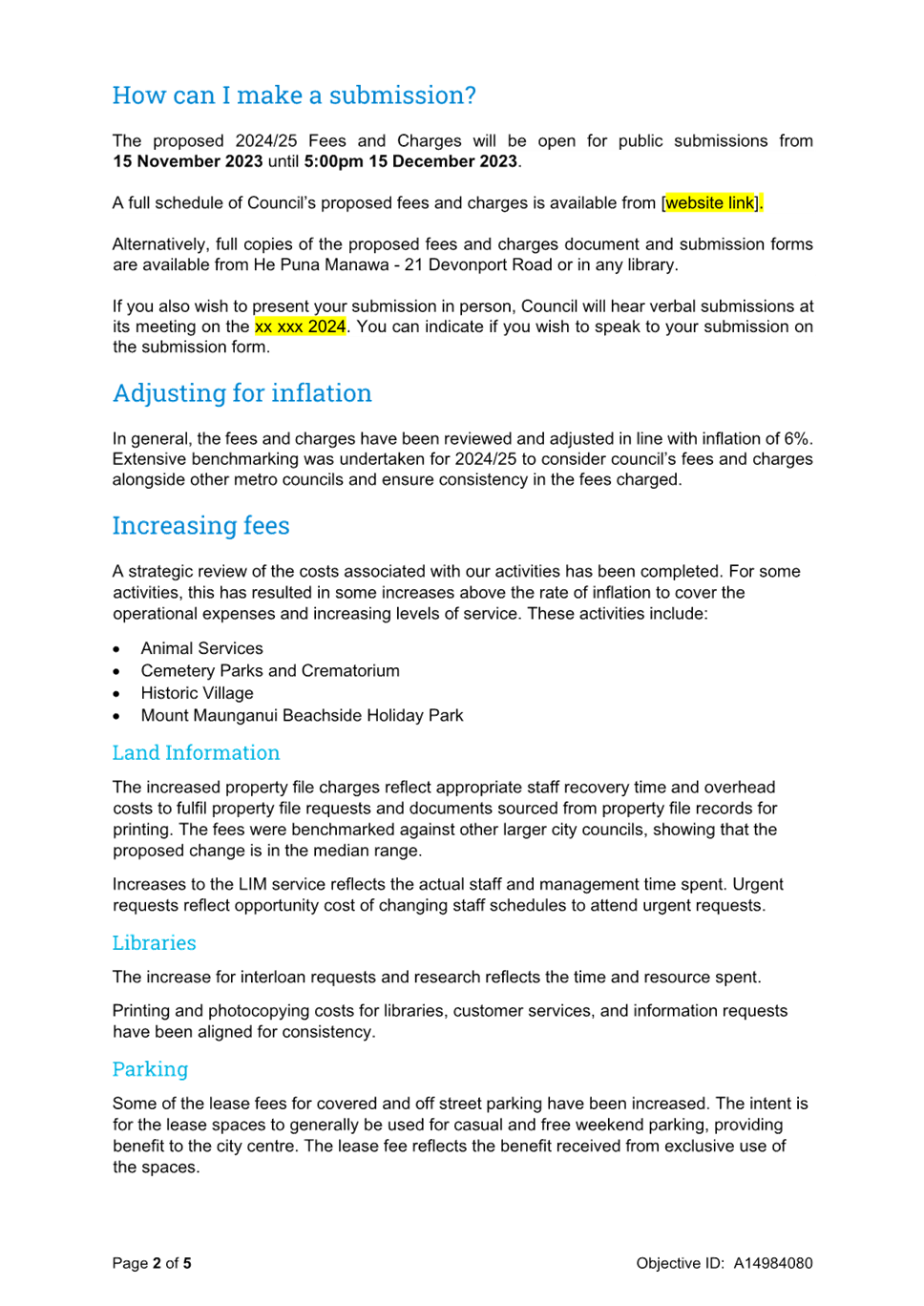

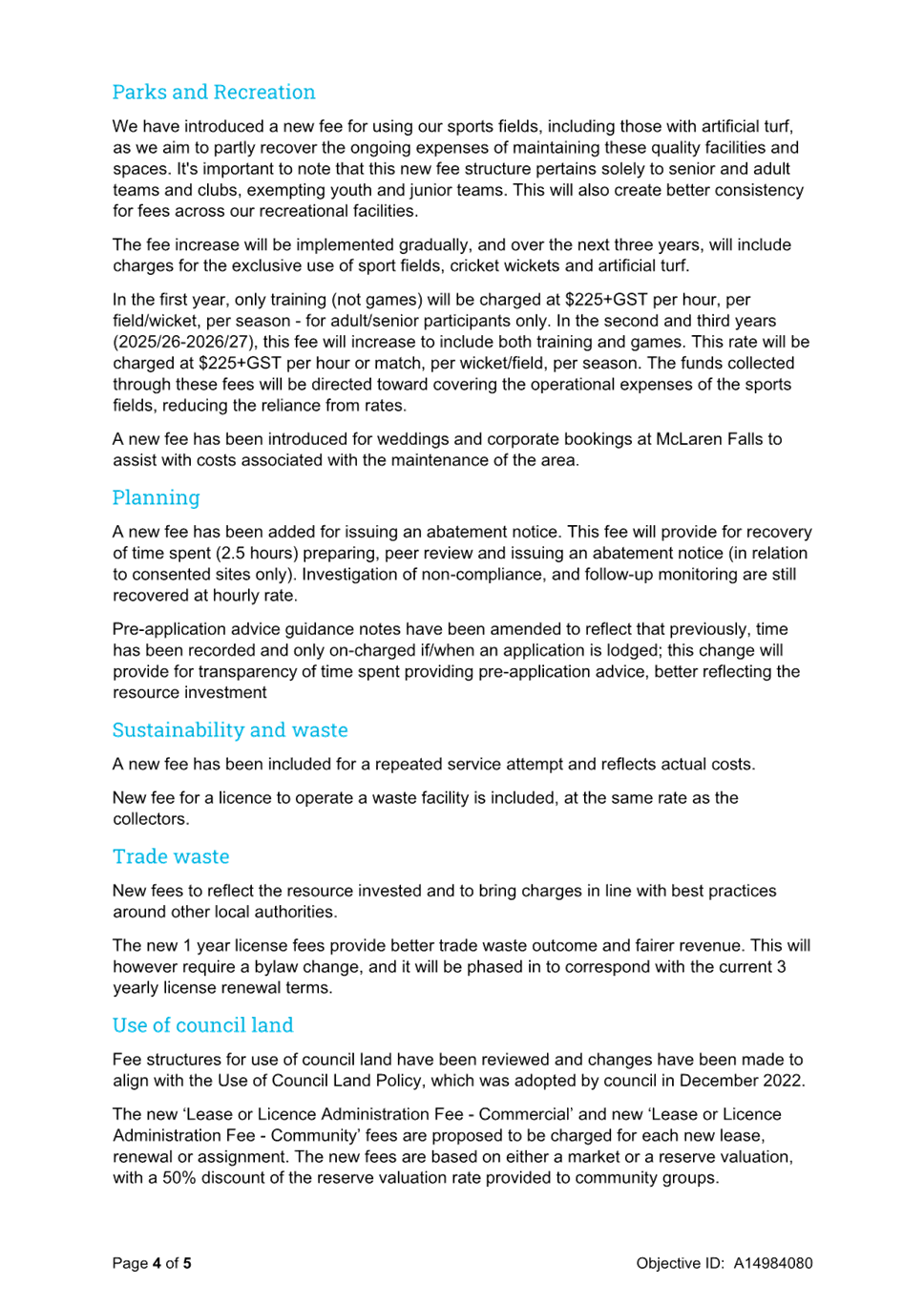
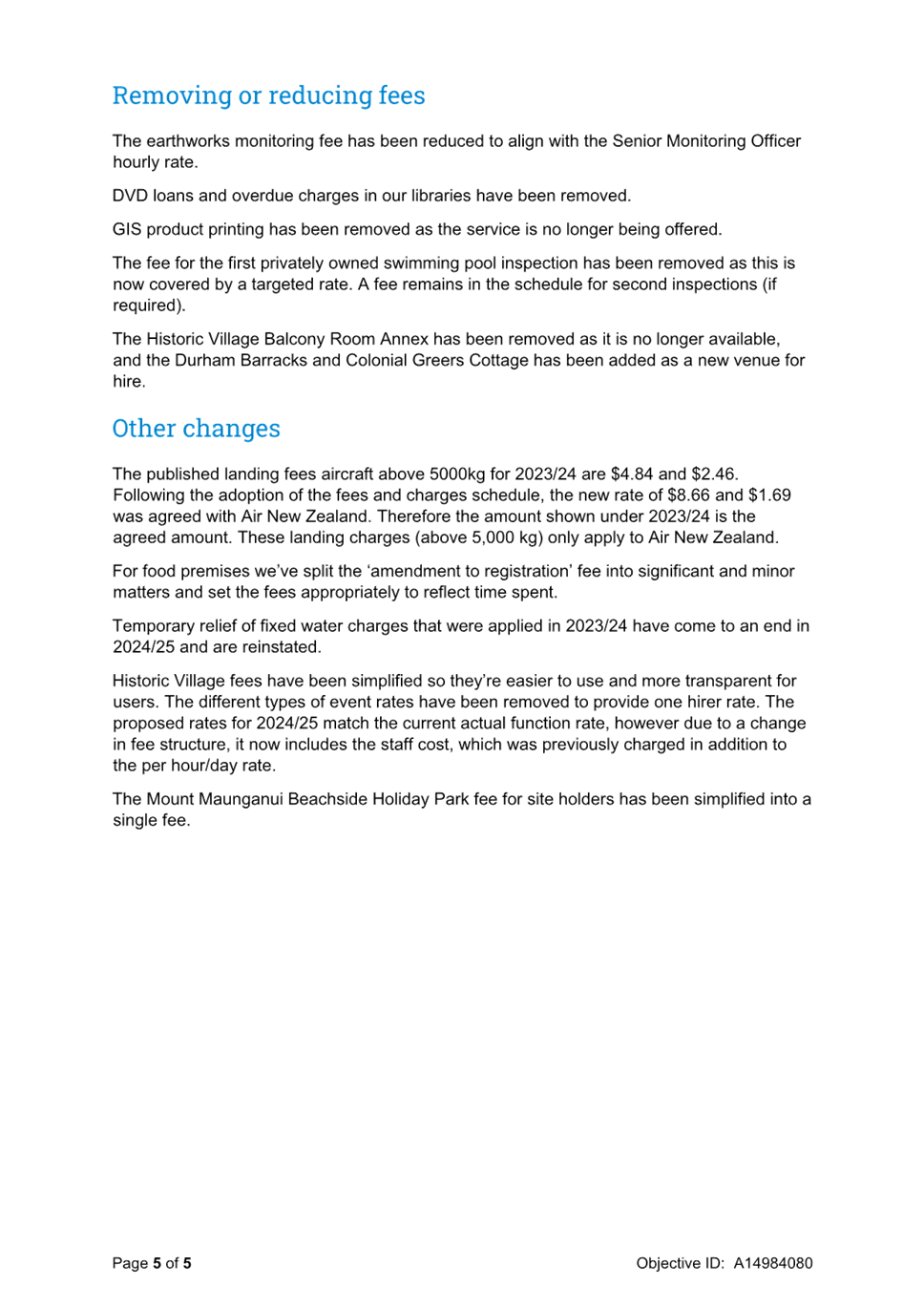
|
Ordinary
Council meeting Agenda
|
11
September 2023
|
11.5 2024-2034
Long-term Plan - Adoption for Audit of Draft Groups of Activities and
Performance Measures sections
File
Number: A14973012
Author: Josh
Logan, Team Leader: Corporate Planning
Authoriser: Christine
Jones, General Manager: Strategy, Growth & Governance
Purpose of the Report
1. The purpose of this report is to present the draft Groups
of Activities plans and performance measures for Council to consider for
approval to form part of the supporting information for the consultation
on the 2024-2034 Long-term Plan (LTP).
|
Recommendations
That the Council:
(a) Receives the report
"2024-2034 Long-term Plan - Adoption for Audit of Draft Groups of
Activities and Performance Measures sections".
(b) Adopts
the draft Groups of Activities Plans, as set out in Attachment 1,
for submission to Audit New Zealand, as they form part of the supporting
information for the Draft 2024-2034 Long-term Plan.
(c) Adopts
the draft Performance Measures, as set out in Attachment 2, for
submission to Audit New Zealand, as they form part of the supporting
information for the Draft 2024-2034 Long-term Plan.
(d) Delegates
authority to the Chief Executive to make editorial amendments to the draft
Groups of Activities Plans and draft Performance Measures, if required, prior
to it being submitted to Audit New Zealand.
(e) Notes
a revised version of the Groups of Activities Plans and Performance Measures,
following any amendments required by Audit New Zealand and for graphic design
purposes, will be provided to Council for its approval in early November
2023.
|
Executive Summary
2. This paper
recommends adoption of the draft supporting documentation for the 2024-34
Long-term Plan (LTP) to enable auditing of the documents along with the
consultation document and enable progress towards the Special Consultative
Procedure and eventual adoption of the 2024-34 Long-term Plan.
3. Key content
includes:
(a) Draft Groups of Activities (Attachment
1)
(b) Draft Performance Measures (Attachment
2)
4. These documents have
been prepared based on guidance received from Commissioners at the previous two
LTP workshops in June and July and through Council decisions throughout 2023.
They must be available to Audit New Zealand as part of their statutory audit.
5. The results of this
audit will be provided to Council in early November 2023, at which time Council
will be requested to approve revised documents for consultation. Council will receive public submissions between 15
November 2023 to 15 December 2023, and hold hearing
and deliberations in February and March 2024, before adopting the Groups of
Activities Plans and Performance Measures, as part of the LTP.
Background
6. As a requirement of the LTP process, Council has undertaken
a review of each activity area plan. Activity Managers have reviewed individual
activities and developed an up to date simple, practical plan. This plan is the
place for discussions of the linkages between the community outcomes, other
strategic priorities and activities, development of the rationale for service
delivery and assessment of significant negative effects.
7. Another key element of the activity plans are the levels of
service and performance measures. Set as part of the LTP, these form the basis
for monitoring and reporting through annual and quarterly reports.
8. Activity plans are a key part of the long-term planning
process. They help form the basis of information that will be incorporated
within the final Long-term Plan. Additionally, activity area plans help inform
the Infrastructure Strategy and Groups of Activities section that make up part
of the supporting information for the formal LTP consultation period.
9. The Groups of Activities section of the consultation
document for the LTP is how the activities will be presented in the final LTP
document.
10. As
per Section 93 (7) (b) of the Local Government Act 2002 (LGA), the information
required for an LTP is listed in Schedule 10 part 1 of the act. In relation to
the Groups of Activities section of an LTP, it must:
(a) identify the activities within the group of
activities
(b) identify the rationale for delivery of the group
of activities (including the community outcomes to which the group of
activities primarily contributes)
(c) outline any significant negative effects that
any activity within the group of activities may have on the social, economic,
environmental, or cultural well-being of the local community
(d) include the information specified in clauses 4
(Statement of Service provision) and 5 (Funding Impact Statement) —
i. in detail in relation to each of the
first 3 financial years covered by the plan; and
ii. in outline in relation to each of the
subsequent financial years covered by the plan.
New performance measures section for this LTP
11. Direction from the Commission
has informed the content of the draft LTP, and part of this process has led to
the development of a separate performance measures section. This section now
sits alongside the groups of activities section (rather than being integrated
within it).
12. To ensure this approach still
meets legislative requirements, it has been discussed with Audit New Zealand,
who have confirmed that what is presented to you today as Attachment 2
will meet the requirements of the LGA.
13. The performance measures for
the LTP have been incorporated into the proposed performance management
framework as contained in the report titled "2024-2034 Long-Term Plan -
Non-Financial Performance Measures”, presented to Strategy Finance and
Risk Committee on 7 August 2023.
14. The new section lists the
performance measures by our community outcomes. Under each community outcome,
measures are further separated into two categories, Our Direction Measures
(strategic measures) and Service Measures (measures audited by Audit New Zealand)
15. This approach allows readers,
including our communities, to easily understand the performance measures in
terms of how they connect with and contribute to high level outcomes and the
existing pillars of the Council’s Vision and Strategic Direction, and
with service delivery. It aligns with feedback from the Commission received at
the 7 August Strategy Finance and Risk Committee.
Strategic / Statutory Context
16. The
preparation of a LTP is a requirement of the LGA. All Groups of Activities
plans are aligned to Community Outcomes. These provide the community with
an understanding of what we do and how our activities benefit them, ensuring
Council’s activities are transparent and relevant.
Options Analysis
17. There
are two options for consideration:
Option 1: Council adopts the draft supporting
documentation for submission to Audit NZ for formal audit.
18. Council
approves the draft supporting documentation as proposed in Attachments 1 and
2.
|
Advantages
|
Disadvantages
|
|
· Keeps within the
current timeframes.
|
· Potential
opportunities for amendments to the supporting documentation may not have
been considered.
|
|
Recommended?
|
Yes
|
|
|
|
Option 2: Council does not adopt the draft
supporting documentation for submission to Audit NZ for formal audit.
19. Council
does not approve the draft supporting documentation as proposed in Attachments
1 and 2.
|
Advantages
|
Disadvantages
|
|
· Potential
opportunities for supporting documents to be amended and reconsidered.
|
· Delay in
adopting the supporting documentation (depending on the duration) may delay
preparation of the LTP.
|
|
Recommended?
|
No
|
|
|
|
Financial Considerations
20. There are no specific costs
associated with option one, however pursuing option two could lead to time
delays as processes and decision-making may need to be revisited.
Legal Implications / Risks
21. Legislative
issues are considered in the Background section to this report.
Consultation / Engagement
22. The
LTP Consultation Document and supporting documentation is scheduled to be
adopted in November 2023. After that adoption it will be consulted on with the
community using the special consultative procedure outlined in section 93A of
the LGA.
Significance
23. The Local Government Act 2002
requires an assessment of the significance of matters, issues, proposals and
decisions in this report against Council’s Significance and Engagement
Policy. Council acknowledges that in some instances a matter, issue,
proposal or decision may have a high degree of importance to individuals,
groups, or agencies affected by the report.
24. In making this assessment,
consideration has been given to the likely impact, and likely consequences for:
(a) the current
and future social, economic, environmental, or cultural well-being of the district
or region
(b) any persons who
are likely to be particularly affected by, or interested in, the issue,
proposal, decision, or matter
(c) the capacity of the local authority to
perform its role, and the financial and other costs of doing so.
25. In accordance
with the considerations above, criteria and thresholds in the policy, it is
considered that the LTP and its contents is of high significance.
However, this decision is considered to be of low significance.
ENGAGEMENT
26. No
engagement is required at this time (as the decision to adopt the draft Groups
of Activities plans and performance measures section for audit purposes is of
low significance). Once the draft Groups of Activities plans and performance
measures section is adopted as supporting material alongside the LTP
consultation document in November 2023, it will be consulted on with the
community using in accordance with section 93A of the LGA.
Next Steps
27. If Council approves the
recommendations of this report, the Groups of
Activities plans, and performance measures sections will be provided to
Audit New Zealand for their audit.
28. Once that audit is completed,
the Groups of Activities plans, and performance
measures sections will be revised as necessary and presented to Council
for adoption in in November 2023, along with the draft consultation
documentation and other supporting information for the LTP. If adopted at this
point, the Infrastructure Strategy will be consulted on via the Special
Consultative Procedure required by the LGA. Council
decision making may require further changes through this process.
Attachments
1. LTP
2024-34 - Draft - Groups of Activities_PDF - A15004144 (Separate Attachments 1)

2. LTP 2024-34 -
Draft - Performance Measures_PDF - A15004140 (Separate Attachments 1) 
|
Ordinary
Council meeting Agenda
|
11
September 2023
|
11.6 Papamoa
East / Wairakei / Te Tumu Investments: Strategic Considerations and Funding
Approaches
File
Number: A14856800
Author: Andy
Mead, Manager: City Planning & Growth
Frazer Smith,
Manager: Strategic Finance & Growth
Ana Blackwood,
Senior Advisor: Growth Funding
Authoriser: Christine
Jones, General Manager: Strategy, Growth & Governance
Please
note that this report contains confidential attachments.
|
Public Excluded
Attachment
|
Reason why Public Excluded
|
|
Item 11.6 - Papamoa
East / Wairakei / Te Tumu Investments: Strategic Considerations and Funding
Approaches - Attachment 1 - Excerpt of Council Resolutions relating to PEI
from Decemeber 2022
|
s7(2)(b)(ii) - The
withholding of the information is necessary to protect information where the
making available of the information would be likely unreasonably to prejudice
the commercial position of the person who supplied or who is the subject of
the information.
|
|
Item 11.6 - Papamoa
East / Wairakei / Te Tumu Investments: Strategic Considerations and Funding
Approaches - Attachment 2 - Excerpt of key terms relating to the Papamoa East
Interchange from Wairakei Development Agreement
|
s7(2)(b)(ii) - The
withholding of the information is necessary to protect information where the
making available of the information would be likely unreasonably to prejudice
the commercial position of the person who supplied or who is the subject of
the information.
|
|
Item 11.6 - Papamoa
East / Wairakei / Te Tumu Investments: Strategic Considerations and Funding
Approaches - Attachment 3 - Confidential Legal Advice
|
s7(2)(g) - The
withholding of the information is necessary to maintain legal professional
privilege.
|
|
Item 11.6 - Papamoa
East / Wairakei / Te Tumu Investments: Strategic Considerations and Funding
Approaches - Attachment 5 - Detailed list of Te Tumu Funded Capex Projects
|
s7(2)(i) - The
withholding of the information is necessary to enable Council to carry on,
without prejudice or disadvantage, negotiations (including commercial and
industrial negotiations).
|
Purpose of the Report
1. To set out the
broader strategic considerations to inform the Papamoa East Interchange and
Opal Drive Pump Station reports on the same Council agenda.
2. To determine the
funding approach to address the funding risks associated with the Te Tumu urban
growth area for inclusion in the draft 2024-34 Long Term Plan.
|
Recommendations
That the Council:
a) Receives the report "Papamoa East /
Wairakei / Te Tumu Investments: Strategic Considerations and Funding
Approaches".
b) Notes for consideration the range of
strategic issues relevant to progressing construction of infrastructure in
the Eastern Corridor and specifically the Papamoa East Interchange and Opal
Drive Wastewater Pump Station.
c) Agrees that Te Tumu transport funding
risks will be proposed to be managed by a targeted rate based on:
i) 50%
of the Te Tumu portion of the transport projects which have the majority of
their expenditure in the first 3 years of the Long-Term Plan (including the
Papamoa East Interchange).
ii) A
flat charge (i.e. not based on CV) per ratepayer across the city with a
higher charge (double) in the wider benefit area in Papamoa East and (triple)
for those in the full benefit area in Papamoa East.
iii) A 20-year
repayment period starting in Year 1 of the 2024-34 Long Term Plan
period.
d) Consults with the community on the
proposed Te Tumu transport related targeted rate through the draft 2024-2034
Long Term Plan.
e) Agrees not to propose a targeted rate for
waters projects due to the proposed three waters reform and exclusion of
waters activities after Year 2 of the 2024-34 Long Term Plan.
f) Retains attachments 1 and 2 in
public excluded under section 7(2)(ii) of the Local Government Official
Information and Meetings Act.
g) Retains attachment 3 in public excluded
under section 7(2)(g) of the Local Government Official Information and
Meetings Act
h) Retains attachment 5 in public excluded
under s7(2)(i) of the Local Government Official Information and Meetings Act
until the contractual negotiations associated with the Papamoa East
Interchange construction contract are complete.
|
Executive Summary
3. The Long-Term Plan
2024-2034 includes significant investments in the Eastern Corridor which
provide varying benefits to the urban growth areas of Papamoa, Wairakei and Te
Tumu.
4. The Papamoa East
Interchange is proposed to be constructed to support the existing community in
Papamoa East including 5,700 homes east of Parton Road, as well as to enable
development of the Wairakei town centre (including associated medium density
housing). Significantly greater benefits could be attributed to the
existing community and remaining growth in Papamoa and Wairakei compared to Te
Tumu as they will utilise this asset long before development in Te Tumu occurs.
The same is true for the Opal Drive Wastewater Pump Station.
5. The Interchange and
the pump station would also support the future Te Tumu urban growth area. A
significant amount of cost of both projects are allocated to Te Tumu
development contribution funding as well as other transport and three waters
projects.
6. These costs will
initially be debt funded by TCC or in the case of three waters projects the
assumption is that they will be the responsibility of the proposed new three
waters entity for the Bay of Plenty from Year 3 of the 2024-34 period
onward.
7. The timing of Te
Tumu development is anticipated to be significantly delayed and likely to start
in approximately 2040 based on the upcoming draft 2024-34 LTP. To manage
rates and debt sustainably, construction costs for the Kaituna Stormwater
Project will not be in the 2024-34 period. The Overflow is required
before development can commence in Te Tumu.
8. Te Tumu also faces a
range of other challenges to successfully rezone it for urban
development. These relate to securing infrastructure corridors through
Māori land, the wider views of Tangata Whenua on the scale and
appropriateness of urban development, and the impacts of government freshwater
and indigenous biodiversity policy on urban development and associated infrastructure
delivery.
9. Given these risks
there is substantial uncertainty around the Te Tumu funding share for the
interchange and Opal Dr projects as well as other projects with a Te Tumu
funding share. The report sets out these risks in further detail to enable
them to be considered as part of decision-making regarding the interchange and
Opal Drive reports on this Agenda.
10. Decisions are also required on
how to address funding risks associated with the Te Tumu share of transport and
waters projects as part of the draft 2024-34 Long Term Plan, including the
potential for general and targeted rate funding. These options are
assessed in the report, and it is recommended that 50% of the Te Tumu funding
risk related to the transport projects is transferred to a mix of general rates
and a Papamoa East targeted rate to keep Council debt at a sustainable level.
11. Due to three waters activities
being out of the 2024-34 Long Term Plan from Year 3 onward there is limited
ability to address waters funding risks at this point in time.
Background
12. This report should be
considered alongside the reports on the same Council meeting agenda that
addresses the Papamoa East Interchange and Opal Drive Wastewater Pump Station.
13. The report addresses issues
which arise from:
· Level
of uncertainty associated with Te Tumu proceeding and the timing of that
development proceeding
· Timing
of investment in infrastructure which benefits both existing zoned land and the
future Te Tumu land.
14. The Pāpāmoa East
Interchange (PEI) and the Opal Drive Wastewater Pump Station are key to
unlocking investment to deliver much needed housing in Wairakei (and Te Tumu in
the future). They will also bring many social, economic and environmental
benefits for current and future Pāpāmoa East residents and businesses
through the creation of a ‘Connected Centre’ in Papamoa
East.
15. Connected Centres is the
philosophy embedded throughout the Urban Form and Transport Initiative (UFTI)
and the Transport System Plan (TSP). Its focus is on improved urban form
and better transport choice to support people to travel less and travel
differently - enabling people to live, work, learn, play and move
locally. The Connected Centres concept applied in the Sands Town Centre
and Te Tumu, supported by the PEI and the pump station, will enable higher
density housing, trip containment and multi-modal transport opportunities which
deliver carbon emission benefits.
16. Key housing development and
associated outcomes are to:
· Accelerate
the build of 750 medium and high-density homes currently zoned for development
in and immediately around the Wairakei (Sands) town centre;
· Provide
for a total of 3,030 currently zoned new homes in Wairakei; 6,000 future homes
in Te Tumu; and 2,000 potential homes in Bell Road.
· Provide
for a range of housing typologies.
· Unlock
the creation of a new town centre, The Sands, with between 5,300 and 7,600 new
FTE’s. This will deliver well located amenity in the east, therefore
reducing the need to travel to the west.
· Support
the Rangiuru Business Park Provincial Growth Fund project providing housing for
4,000 employees.
· Deliver
positive carbon emissions outcomes through alleviating pressure on the
transport network and by improving urban form that supports trip containment
(residents can live, work, learn, play and move easily within their
neighbourhood) and by encouraging mode shift towards more sustainable travel
options.
· Support
an accessible town centre; in Wairakei with approximately 3,000 dwellings
accommodating 7,250 people within walkable catchment of town centre (800-1000m)
and increasing to 10,000 plus people within the walkable catchment when Te Tumu
is fully developed.
17. The PEI is not just about
supporting growth, it will benefit the existing community in Papamoa East and
transport modelling demonstrates that it will be well used by the existing
community, especially those living to the east of Parton Road. There are
currently 5,700 homes located east of Parton Road. Significantly greater
benefits could be attributed to the existing community and remaining growth in
Papamoa and Wairakei compared to Te Tumu as they will utilise this asset long
before development in Te Tumu occurs. The same is true for the Opal Drive Wastewater
Pump Station.
18. The PEI project is separated
into three ‘phases.
· Phase
1 was earthworks and culverts – this stage is largely completed.
· Phase
2 is the extension of Te Okuroa Drive and the intersection with the future
Sands Avenue – scheduled for completion by the end of this calendar year.
· Phase
3 is the budget for the rest of Sands Avenue and the core interchange
structure.
19. At a Council meeting 12
December 2022, a report titled “Approval to enter into Wairakei
Development Agreement” was considered in the public excluded
session. Subsequently the Wairakei Developer Agreement was executed on 23
June 2023.
20. The resolutions from the 12
December meeting and terms of the Wairakei Development Agreement are relevant
to decision-making around PEI construction. Given the commercially
sensitive nature of these matters a copy of the relevant excerpts of each are
included as Confidential Attachments 1 and
2.
TK14 TRUST
21. TCC and representatives of the
TK14 Trust are in negotiations to agree suitable mechanisms to provide
infrastructure through the TK14 Block which would support the urban development
of the entire Te Tumu urban growth area. A majority of TK14 beneficiaries
who voted, supported these negotiations proceeding.
22. The negotiations are proceeding
well but will take some time to conclude given complex legal and land valuation
issues (including the need to obtain Land Information New Zealand and
Māori Land Court approval of the legal instruments that will be employed
to secure TCC’s rights). Once suitable outcomes are agreed they
will be presented back to the TK14 beneficiaries for a further vote.
Until this process is complete and approved by Council, we will not have
certainty of access and infrastructure arrangements to support the development
of Te Tumu.
23. Development of Te Tumu cannot
commence until infrastructure is delivered through the TK14 Block. While
TCC is taking the lead on securing infrastructure corridors, the cost and
responsibility for construction of infrastructure sits with the Te Tumu
developers. This may require one of the developers to the east of the
TK14 land to forward funding infrastructure through TK14 to enable housing and
urban development to commence and development contributions to start flowing to
Council. These matters have yet to be agreed between the
landowners. Also is it possible that some Crown funding / financing
may be available to the TK14 Māori Land Trust to assist with
infrastructure investment.
24. TCC is currently progressing a
business case with the aim of securing Waka Kotahi funding to assist with the
cost of delivering the future Te Tumu transport network. Certainty of any
potential funding will not be known for some time and cannot be relied upon at
this time given future Waka Kotahi approval processes, funding constraints and
the funding needs of other priority transport projects.
TE TUMU PLAN CHANGE
25. The structure planning and
rezoning of Te Tumu has been underway since 2017, originally with the aim of
housing development commencing in 2021. The project has faced a number of
challenges and delays most notably in respect of:
· Differing
aspirations of Māori landowners and their Trustees including the ability
to deliver infrastructure through Māori land.
· The
views of iwi and hapu on the appropriateness of urban development within Te
Tumu.
26. Changes to national direction
pursuant to the RMA in respect of freshwater management, especially wetlands,
and the inability to progress the structure planning of the area with
confidence while these national level policy changes were occurring.
27. While some progress has been
made, the project continues to face on-going challenges in respect of these
matters, especially as we now look to give effect to these operative national
direction documents which impact existing technical work and key elements of
the project.
28. Iwi and hapu engagement recently
recommenced following an extensive pause, at their request while the TK14 Trust
moved through internal processes with their landowners. Many Tangata
Whenua continue to hold a strong view urban development within Te Tumu is not
appropriate. This view is held despite the TK14 Trust gaining a majority
mandate from its beneficial owners to negotiate the delivery of infrastructure
corridors with TCC.
29. Despite recent amendments to
the government’s freshwater policy adopting many of TCC’s
recommended changes, not all suggested changes were adopted. Staff have
been considering these outcomes further, particularly in regard to the delivery
of the Kaituna Stormwater Overflow. The Overflow is a requirement of the
existing comprehensive stormwater consent that Council holds and is essential
to managing stormwater runoff from future urban development in Te Tumu and
protecting existing development within the wider catchment of the Wairakei
Stream in Papamoa and Wairakei. Refer to confidential attachment 3 for
further information.
30. There are also judicial review
proceedings against the Minister for the Environment seeking a move back to
more stringent protection of freshwater environments as set out in the
NPS-FM. If successful, this would likely have impacts on the Te Tumu
urban growth area planning.
31. More recently the government
enacted the National Policy Statement for Indigenous Biodiversity. In addition
to the requirements now set out under the new freshwater policy directions,
staff have also been considering how the new indigenous biodiversity national
policy framework will impact on the delivery of key projects associated with
progressing urban development within Te Tumu. Although many areas across
Te Tumu are presently identified as having significant ecological value and are
managed through existing rules in the City Plan, these areas, including any new
areas that are identified using new assessment criteria set out in the policy
statement, will now be required to be managed in accordance with this national
policy. This requirement however includes ensuring that effects resulting from
subdivision, use or development on these areas be avoided. This is an onerous
requirement and one that will be likely be very difficult to achieve in
reality. Further, it is noted that majority of the existing ecological
areas in Te Tumu are also wetland areas and will be subject to both this new
policy statement and the requirements of the new freshwater policy. This adds
further complexities to successfully delivering key infrastructure and urban
development within this growth areas.
32. Given the above matters, the
planning process to assess and confirm acceptability of rezoning Te Tumu for
urban development remains long, complex and uncertain. Combined with funding
constrains for infrastructure we currently estimate that urban development of
Te Tumu may commence around 2040 if a successful rezoning process can be
completed. Staff are undertaking further work on these key issues to
inform Council decision-making on the way forward for the Te Tumu
project. This includes seeking independent legal and planning
advice. This advice will be provided to Council in public excluded when
available.
33. There is a risk that urban
development within Te Tumu does not proceed. In that scenario capex costs
attributed to Te Tumu development contribution funding would have to be funded
by ratepayers.
funding and PROJECT cost
34. The total projected cost of the
PEI as of August 2023 is $121M. Noting that this number is adjusted for
expected inflation in the later years of delivery and so is higher than the
amount noted in the report regarding the tender of the PEI but ultimately made
up from the same budgets. This is made up as:
· $11.7M
for land purchase and early works (spent)
· $14.7M
for the cost of Phase 1 works (spent)
· $13.2M
budgeted for Phase 2 works (committed)
· $81M
budgeted for Phase 3 (tender award decision with Council).
35. 51% of the costs of the PEI, up
to a maximum amount of $62M, will be funded from Waka Kotahi. The
following table summarises the funding proportions based on the current
budgets.
|
Funding Source
|
%
|
$
|
|
Waka Kotahi
|
50%[4].
|
$60.1M
|
|
Wairakei DCs
|
21%
|
$24.6M
|
|
Te Tumu DCs
|
27%
|
$33.1
|
|
General rates
|
3%
|
$3M
|
|
Total
|
100%
|
$120.9M
|
36. If the actual spend is lower
than the current budget, then we will not draw down the full $62M from Waka
Kotahi as they will only fund a maximum of 51%.
37. If Te Tumu development does not
proceed, then the Te Tumu cost share will need to be funded via alternative
means – most likely becoming a ratepayer cost. However, there are a
number of ways this risk could be mitigated for example:
· Divestment
of surplus land acquired for the PEI project[5]
· Development
of rural parts of Papamoa East is being investigated in the vicinity of Domain,
Tara and Bell Roads. This could provide additional growth to contribute
to infrastructure costs
· If
infrastructure projects such as the PEI were delivered lower than current
budgets this would reduce Te Tumu funding risks
· The
transfer of infrastructure and funding responsibilities to a proposed Three
Waters Entity (noting this would simply move the risk to another entity)
· Targeted
rates across the Papamoa and Wairakei areas could meet part of a funding gap
(as addressed in further detail later in this report).
38. The Wairakei funding share is
currently on track to be fully recovered by development contributions with
project cost increases being offset by external Waka Kotahi funding. This
means there shouldn’t be a development contribution under-collection.
39. TCC secured a $96M, 10-year
interest free loan via the Housing Infrastructure Fund (HIF) in relation to the
PEI. $62M of this loan has been utilised by Waka Kotahi which unlocked
their currently constrained funding capacity to ensure they could subsidise the
PEI. The remaining $34M of the HIF loan is being used by TCC. This HIF loan was
signed 30 June 2023 and TCC will begin drawing down on this loan facility this
financial year. The HIF is a financing source only and does not directly fund
the project – i.e., we still need to pay back the loan using development
contribution revenue.
40. Despite the HIF loan, the PEI
expenditure will still incur interest until the full cost has been repaid. This
is because the loan does not cover the full value of the expenditure and the
interest free benefit has been used in a way that it reduces TCC’s
overall debt borrowing rate – rather than only reducing the interest for
the PEI.
41. Funding of the Opal Drive pump
station is set out in the separate Opal Dr report.
TE TUMU COST ALLOCATION
42. TCC has already spent nearly
$12M on the PEI, wastewater infrastructure and other projects which are
expected to be funded via Te Tumu. Another $228M of infrastructure investment
is budgeted within the LTP period. By 2033/34 TCC will have incurred over $240
in capex to be funded via Te Tumu. Adding onto this investment outside the LTP
period - then it is expected that approximately $309M of infrastructure
investment will need to be funded via Te Tumu. Noting that the
expectation is that the proposed new Bay of Plenty three waters entity would be
responsible for a significant component of this investment.
43. Most of the infrastructure
shown is being delivered within the next ten years because it also services the
Wairakei and/or Papamoa catchments (i.e. it is shared infrastructure). Some of
the cost is to pay for Te Tumu infrastructure being built into Wairakei road
corridors[6]
and a small portion is to fund early design work for the future Te Tumu
infrastructure. Attachment 4 is a plan which shows the rough location of
projects which are part funded via Te Tumu. Attachment 5 provides the specific
details all the projects part funded by Te Tumu and their correlating capital
infrastructure budget.
44. Table 1 below is a summary of
those projects in Attachment 5 grouped by activity. It only shows the portion
of those projects within the LTP period so does not sum to $309M.
|
Table 1: Te Tumu Funded Cashflow by year
|
|
Actual
|
2023/24
|
2024/25
|
2025/26
|
2026/27
|
2027/28
|
2028/29
|
2029/30
|
2030/31
|
2031/32
|
2032/33
|
2033/34
|
|
|
|
$000
|
$000
|
$000
|
$000
|
$000
|
$000
|
$000
|
$000
|
$000
|
$000
|
$000
|
|
Water
|
|
65
|
|
|
|
|
|
|
|
|
|
|
|
Wastewater
|
2,099
|
5,460
|
8,692
|
13,674
|
15,838
|
13,609
|
18,003
|
13,012
|
14,698
|
14,180
|
16,405
|
17,927
|
|
Stormwater
|
1,068
|
17
|
|
92
|
180
|
4,897
|
470
|
1,453
|
7,817
|
3,663
|
3,754
|
3,859
|
|
3 Waters
sub total
|
3,166
|
5,541
|
8,692
|
13,766
|
16,019
|
18,506
|
18,472
|
14,465
|
22,515
|
17,843
|
20,159
|
21,786
|
|
3 Water
cumulative
|
3,166
|
8,708
|
17,400
|
31,166
|
47,184
|
65,690
|
84,163
|
98,628
|
121,143
|
138,986
|
159,145
|
180,931
|
|
Transport
|
8,787
|
8,171
|
17,194
|
12,193
|
2,971
|
9,083
|
|
|
934
|
|
|
|
|
Transport
cumulative
|
8,787
|
16,958
|
34,153
|
46,345
|
49,316
|
58,399
|
58,399
|
58,399
|
59,333
|
59,333
|
59,333
|
59,333
|
|
Total
annual
|
11,954
|
13,713
|
25,886
|
25,959
|
18,990
|
27,588
|
18,472
|
14,465
|
23,449
|
17,843
|
20,159
|
21,786
|
|
Total
Cumulative
|
11,954
|
25,666
|
51,552
|
77,511
|
96,501
|
124,089
|
142,562
|
157,027
|
180,476
|
198,319
|
218,478
|
240,264
|
45. Consideration is being given to
potential cost savings from rescoping three waters infrastructure projects such
that they no longer provide capacity for growth in Te Tumu, and the
consequential implications of this in respect of the further investment that
would be required if Te Tumu did proceed in future. This is addressed in
the Opal Drive report on this agenda and will be further reported back later in
the LTP process for other relevant three waters projects. This work may
provide options to reduce a portion of the financial risk Council is exposed
to.
46. As stated above, most of the
infrastructure being built now is not being driven by the need to provide for
Te Tumu but is needed now because it also provides for development in
Wairakei/Papamoa. This raises the issue of whether the current funding model
should be adjusted.
47. The
delay in the expected development of Te Tumu means that the debt relating to
this infrastructure will compound significantly in the meantime. Table 1
below shows the likely impact on Te Tumu related debt if no action is taken.
Table
2: Likely Impact on Te Tumu debt if it is left to compound until 2045

48. This level of debt would lock
up a significant portion of Councils restricted debt capacity. It would
also increase the risk that Te Tumu Development Contributions, when they were
eventually charged, would be so high that development would be severely restricted
and so this debt may never be recovered. It is estimated that development
contributions would exceed $100,000 per lot for transport and three waters
infrastructure based on the current funding model.
Options to address te tumu
related financial risks
49. Options exist to focus solely
on the transport activity or to consider the three waters activities as
well. As noted earlier the three waters activities are complicated by the
Three Waters Reform process and the statutorily required assumption for the
2024-34 Long Term Plan that three waters activities are excluded from year 3
onward. Nonetheless staff have prepared information in regard to all
activities.
50. In relation to the three waters
activities, we will also advise the National Transition Unit of the issue.
51. Regardless of which activities
are addressed the options are:
· Option
1: Status quo – based on assumption that Te Tumu will be developed
and that costs will be recovered through development contributions.
1. This
option is consistent with the philosophy of growth paying for growth, but may
result in significant adverse debt and rate funding implications if Te Tumu
risks materialise. Even if Te Tumu is developed, over $300M of
TCC’s limited debt capacity will be utilised by Te Tumu costs and
development contributions may be unsustainably high.
· Option
2: Amended status quo (Rate fund cost of capital) – As above
but rate fund cost of capital on debt associated with Te Tumu. This
option could involve full or partial rate funding of the cost of capital, most
probably until the next LTP in the first instance when there will be more
certainty on the future prospects for the Te Tumu urban growth area.
2. This
option would ensure Te Tumu related debt does not increase at an unsustainable
rate due to compounding interest costs, but would not address funding of the
core debt to address risks associated with Te Tumu, although this could be
addressed through future decision-making eg through the 2027-37 Long Term Plan
by which time the future prospects for Te Tumu will be better understood.
· Option
3: General rate fund some or all of the Te Tumu capital costs.
3. This
would address risks associated with the Te Tumu funding share by paying down
debt but would impose a greater burden on ratepayers to do so which is not
aligned with the growth pays for growth philosophy. The financial impact on
each rateable property would be approximately $71 p.a. for 20 years for both
transport and waters projects.
· Option
4: Targeted rate some or all of the Te Tumu capital costs.
4. A
targeted rate would apply to Wairakei and the eastern part of Papamoa, probably
from Domain Road eastward. The rate may be higher in Wairakei which is closer
to the PEI and likely to receive greater benefit from its construction.
5. This
would address risks associated with the Te Tumu project by paying down debt but
would impose a greater burden on ratepayers in Wairakei and Papamoa that
directly benefit from these projects. It is again not well aligned with
the growth pays for growth philosophy given the transfer of some funding away
from Te Tumu.
· Option
5: A mix of general and targeted rates to fund some or all of the Te Tumu
capital costs.
Comments
under options 3 and 4 apply to this option.
52. Further financial modelling and
assessment of Options 3, 4 and 5 is covered in the section titled General and
Targeted Rate Approach below. Option 2 is addressed further in the
following paragraphs.
53. Table 3 below shows an
estimate of the amount of interest that will accrue on the Te Tumu funded capex
over the LTP period based on current budgets and
a fixed interest rate of 6%.
|
Table 3: Te Tumu - interest cost of debt by year
|
|
Actual
|
2023/24
|
2024/25
|
2025/26
|
2026/27
|
2027/28
|
2028/29
|
2029/30
|
2030/31
|
2031/32
|
2032/33
|
2033/34
|
|
|
|
$000
|
$000
|
$000
|
$000
|
$000
|
$000
|
$000
|
$000
|
$000
|
$000
|
$000
|
|
3 Waters
|
95
|
362
|
811
|
1,533
|
2,519
|
3,705
|
5,037
|
6,327
|
7,816
|
9,496
|
11,206
|
13,137
|
|
Transport
|
264
|
788
|
1,596
|
2,574
|
3,183
|
3,736
|
4,232
|
4,486
|
4,784
|
5,099
|
5,405
|
5,729
|
|
Total
annual
|
359
|
1,150
|
2,407
|
4,107
|
5,702
|
7,441
|
9,269
|
10,814
|
12,600
|
14,595
|
16,611
|
18,866
|
|
Transport
– cumulative
|
264
|
1,052
|
2,648
|
5,222
|
8,405
|
12,141
|
16,373
|
20,860
|
25,643
|
30,742
|
36,146
|
41,875
|
|
Total
Cumulative
|
359
|
1,509
|
3,916
|
8,023
|
13,724
|
21,166
|
30,435
|
41,249
|
53,849
|
68,444
|
85,054
|
103,920
|
54. The approximate amount of Te
Tumu related interest expected to be incurred for the transport activity up to
the end of Year 3 of the 2024-34 period (i.e., 2026/27 financial period) period
is $8M.
55. If this amount was fully
transferred to rates funded debt, then this would most likely be managed
through the unfunded liability reserve. This means that the interest cost would
be retired through rates from Year 4 of the LTP and funded over a 20-year
period. Based on the current capex budgets and the above estimate of
$8.8M in interest costs – this would be roughly $720,000 per annum
addition to rates. Although technically given that there is already rates
budgeted into the liability reserve it will not add an additional rating impact
but utilise the budgeted amounts from the reserve.
General & targeted rate
Approach
56. In order to address Te Tumu
funding risks, we have assessed a range of rating options. To do this we
have examined the following key variables:
· Projects
to be included
· Benefit
areas
· Other
key assumptions
Projects
to be included
57. Staff established the following
criteria to determine which projects should be included in a rating
calculation.
· Projects
that have the majority of their expenditure in the first 3 years of the LTP
(i.e., a greater degree of certainty over design and costs).
· Excludes
projects that are 100% Te Tumu funded (there must be some wider benefit)
· Addresses
water projects separately from Transportation projects due to the uncertainty
around legislative reform.
58. Table 4 summarises the projects
that meet these criteria. The individual project values are not shown as
some of these projects are currently undergoing commercial negotiations (refer
confidential attachment 5). The list of projects that meets the
criteria and is reflected in Table 4 is set out below:
Waters
· Main
Wairakei Pump Station
· Opal
Drive Pump Station
· Te
Okuroa Dr and Papamoa East Interchange roading related stormwater
Transport
· Designations
in Papamoa
· Sands
Ave – Between Papamoa East Interchange and Te Okuroa Dr
· Te
Okuroa Drive – Sands Ave to Te Tumu
· Papamoa
East Interchange (land purchase, design, Phases 1-3)
· Sands
Ave – The Boulevard to Te Okuroa Dr
· Intersection
– Sands Av and The Boulevard
· The
Boulevard – Stevenson Dr to Sands Ave
· The
Boulevard – Sands Ave to Te Tumu
· Wairakei
Town Centre Bus Facility
Table
4: Summary of projects selected to be included in the calculation of a
targeted rate

Benefit areas
59. All of the projects are
physically located within the Wairakei growth area. Most of these already
have a benefit allocated to Wairakei and/ or Papamoa growth areas.
60. Reviewing the selected
projects, we identified common geographic areas of benefit. These were
based upon proximity to the physical projects and direct improvements to the
level of service through reduced congestion and/ or security of service levels.
These are shown in Figure 1 below as:
· Full
Benefit area (Pink)
Directly
benefit from projects
· Wider
benefit area (Yellow)
Do
receive some benefit, but this is less than those living closer to the
infrastructure.
· Wider
city (blank)
More
limited benefit
Figure
1: Benefit areas identified

Other Key Assumptions
61. While the Te Tumu development
has been considerably delayed, it is still expected to eventuate. It is
therefore not considered appropriate to recover all of the debt costs and allow
future Te Tumu developers and homeowners to have free access to this
infrastructure. We have currently recommended that 50% of the Te Tumu
funding is recovered from this targeted rate.
62. We have estimated the rates
charge based on a 20-year timeframe until Te Tumu development is expected to
commence. It is assumed that Te Tumu would not be subject to the targeted
rate but would instead pay their residual share through development
contributions.
63. The projects are all largely
local infrastructure (as opposed to Citywide) and we have traditionally charged
local infrastructure as a flat charge. This is because this
infrastructure is required, whatever might be built upon a site. For this
reason, we have calculated the rate as a flat charge per property, as opposed
to being based on property values (ie CV). For the same reasons we are
not recommending a commercial / industrial differential.
64. It is recommended that a
targeted rate option is consulted upon as part of the 2024-34 LTP, for
implementation in Year 1. The issue is known now, and it is recommended that
Council proceed to address it.
65. Based on the criteria and
assumptions outlined above we have calculated a targeted rate based upon:
· A
targeted rate across everyone in the city
· A
targeted rate across only the benefit area identified
· A
targeted rate that is a combination of both of these.
66. Charging the targeted rate
across the whole city.
Table 5: Charges
spread evenly across the city

67. Charging the targeted rate
only across areas that benefit from the projects (evenly charged between
full and wider benefits)
Table 6: Charges
spread evenly across benefit area

68. Charging the targeted rate
only based on varying levels of benefit across areas (with double the rate
charged to the full benefit area compared to the wider benefit area)
Table 7: Charges spread across benefit area, but double in full benefit
catchment
69. Charging the targeted rate
across the whole city based on varying levels of benefit (double in wider
benefit area, and triple in full benefit area)
Table 8: Charges
spread across city but double in wider benefit area, and triple in full benefit
catchment

70. These are all estimated charges
and would change based on changes to projects scope and costs, rates of growth
compared to expected and changes in other assumptions.
recommended option
71. It is recommended that Council
confirm the calculation of a targeted rate based upon:
· 50%
of the Te Tumu portion of the selected projects
· Transport
projects only given the uncertainty around the timing of proposed waters
reform, noting that if this is significantly delayed we would look at options
to include future water charges.
· A
flat charge (ie not based on CV) per ratepayer across the city with a higher
charge (double) for this in the wider benefit area and (triple) for those in
the full benefit area
72. This equates to the
transportation projects targeted rates outlined in Table 8 above.
Financial Considerations
73. As outlined above, the targeted
rate calculated is not expected to remove all Te Tumu debt but will
considerably reduce this. This financial impact is expected to have the
following impact (compared to Table 2 above) as shown in the transportation
projects row of Table 9. Waters project debt would transfer to a three
waters entity.
Table 9: Likely Impact
on Te Tumu debt through to 2045

74. All of the rating options set
out in tables 5 to 8 have the same impact on Council debt. The options
only change which ratepayers contribute to this repayment.
Strategic / Statutory Context
75. The Papamoa East Interchange,
Opal Drive Wastewater Pump Station and other related transport and three waters
projects are key infrastructure requirements to enable development of Wairakei
and Te Tumu in accordance with SmartGrowth’s strategic growth strategy as
agreed through the SmartGrowth Urban Form and Transport Initiative.
Legal Implications / Risks
76. There are a range of risks
associated with the development of Te Tumu, especially financial risks and
legal risks associated with planning processes. These are outlined
earlier in the report.
77. Confidential Attachment 2
outlines the relevant commitments between TCC and Bluehaven.
78. The requirements around the
establishing a new rate will need to be followed including consultation through
the draft 2024-34 Long Term Plan.
Consultation / Engagement
79. Engagement with the developers
of the Sands Town Centre in Wairakei is ongoing. As per the provisions of
the Developer Agreement set out earlier in the report, the developer has
strongly advocated for the Papamoa East Interchange as a catalyst for
development of the town centre. TCC has entered into certain obligations
to deliver the interchange which are subject to tender costs, broader financial
risks and progress with the TTK14 Trust.
80. Engagement with the Te Tumu
Landowner Group is also ongoing. This group is supportive of the delivery
of the Papamoa East Interchange. This group’s key concern is around
the financial implications of Te Tumu related interest costs on projects like
the Papamoa East Interchange being incorporated into a future Te Tumu
development contribution charge. A commitment was previously made to
bring this matter to Commissioners for decision-making as part of the 24-34
LTP, and it is now addressed within this report.
81. Engagement on the recommended
rating approach would occur through the draft 2024-34 LTP.
Significance
82. The Local Government Act 2002
requires an assessment of the significance of matters, issues, proposals and
decisions in this report against Council’s Significance and Engagement
Policy. Council acknowledges that in some instances a matter, issue,
proposal or decision may have a high degree of importance to individuals,
groups, or agencies affected by the report.
83. In making this assessment,
consideration has been given to the likely impact, and likely consequences for:
(a) the current
and future social, economic, environmental, or cultural well-being of the
district or region
(b) any
persons who are likely to be particularly affected by, or interested in, the
matter.
(c) the capacity of the local authority to
perform its role, and the financial and other costs of doing so.
84. In accordance with the
considerations above, criteria and thresholds in the policy, it is considered
that the issue is of high significance. The ramifications of cumulative
debt related to Te Tumu and funding approaches to address this matter are
substantial.
ENGAGEMENT
85. Taking into consideration the
above assessment, that the issue is of high significance, officers are of the
opinion that no further engagement is required prior to Council making a
decision due to the extensive amount of engagement that has already been
undertaken. The views of the relevant parties are well understood.
Any decision on how Te Tumu related financial risks will be addressed,
including through general or targeted rates, would be consulted on through the
draft 2024-2034 LTP.
Next Steps
86. Commissioners make decisions on
whether to proceed with construction of the interchange and the pump station.
87. Staff to incorporate decisions
on addressing Te Tumu related funding risks in the upcoming draft 2024-34 LTP
for consultation.
88. Staff discuss this matter with
the Waters Reform National Transitional Unit.
Attachments
1. Excerpt
of Council Resolutions relating to PEI from Decemeber 2022 - A14921158 - Public
Excluded
2. Excerpt
of key terms relating to the Papamoa East Interchange from Wairakei Development
Agreement - A14921152 - Public Excluded
3. Confidential
Legal Advice - A14983677 - Public Excluded
4. Plan
showing Te Tumu funded infrastructure in Wairakei - A14929803 ⇩ 
5. Detailed list of
Te Tumu Funded Capex Projects - A14983661 - Public Excluded
|
Ordinary
Council meeting Agenda
|
11
September 2023
|

|
Ordinary
Council meeting Agenda
|
11
September 2023
|
11.7 Draft
Financial Information for the 2024-34 Long term Plan
File
Number: A14980899
Author: Kathryn
Sharplin, Manager: Finance
Tracey Hughes,
Financial Insights & Reporting Manager
Authoriser: Paul
Davidson, Chief Financial Officer
Purpose of the Report
1. The purpose of this
report is to present the Draft Financial Information for the 2024-34 Long Term
Plan (LTP) including:
(a) Financial Strategy
(b) Revenue and Financing Policy
(c) Funding Needs Analysis
(d) Financial Statements and
supporting financial documentation
2. Council agreement is
sought to submit these documents for audit prior to consultation as part of the
LTP consultation process.
|
Recommendations
That the Council:
(a) Receives the report
"Draft Financial Information for the 2024-34 Long term Plan".
(b) Approves for submission to
Audit the following material:
(i) Funding Needs analysis
(ii) Revenue and Financing
Policy
(iii) Financial Strategy
(iv) Supporting Financial
Information
(c) Approves the inclusion of
changes approved by resolution arising following the preparation of the
documents in resolution (b) to be updated in the appropriate documents prior
to submission to Audit New Zealand.
|
Executive Summary
3. Legislative
requirements for preparation and consultation on council’s LTP are
prescribed by The Local Government Act 2002 (LGA). Council is required to
prepare financial material for consultation along with the consultation
document. This material is subject to Audit prior to finalisation of the
consultation document and other strategies and policies as required under the LGA
for consultation.
4. In addition to
required documents Council can prepare supporting documentation to the
consultation document. Where possible Council presents this supporting
documentation in the format required for the final LTP.
5. Further amendments
have been made to the Draft Revenue and Financing Policy and the Funding Needs
Analysis that were approved by Council subject to legal review. These
amendments now incorporate rationale and proposals to consult on introduction
of a new targeted rate for swimming pools and a proposal for a new industrial
rating category.
6. A draft Financial
Strategy has been prepared in accordance with section 101A of the LGA.
7. Draft financial
statements are also provided as supporting documentation.
8. All of the documents
referred to in this report have been prepared based on all decisions up until
the date of this meeting. Any subsequent changes adopted within the
meeting will be incorporated prior to information being supplied to Audit New
Zealand.
Background
9. At the council
meeting on 21 August 2023 Council approved the draft Revenue and Financing
Policy and Funding Needs Analysis subject to legal review with the documents to
be presented back to Council on 11 September as part of the supporting
information to the 2024-34 Long-term Plan Consultation Document.
10. Also at the 21 August council
meeting, Council approved for consultation a number of rating changes
including: the proposal of a new rating category for industrial properties in
the development of the LTP; adoption of a proportional contribution of each
category over time; and a new targeted rate for properties with swimming pools
to cover the costs of regular swimming pool inspections and replace the current
periodic inspection charges.
11. Amendments have been made to
the Funding Needs Analysis and Revenue and Financing Policy to reflect these
changes and a legal review has been undertaken. The final drafts of these
documents are included as Attachment 1 and 2 to this report.
12. Under section 101A of the LGA,
Council is required to prepare a Financial Strategy for the 10 years of the
LTP. The purpose of this strategy includes to provide a guide and context
for council’s proposals for funding and expenditure and to provide
transparency on the overall effects of its LTP proposals on Council’s
services, rates, debt and investments. The draft financial strategy is included
as Attachment 3 to this report.
13. In addition to the high-level
financial summaries provided in the consultation document and Financial
Strategy, more detailed financial statements are provided, in particular the
Statement of Comprehensive Revenue and Expense (SOCRE)
14. The basis of the financial
statements is that waters reform occurs from 1 July 2026. The financial
statements aim to substantially reflect this change from year 3 of the
LTP. However, the full divestment accounting requirements are not yet
reflected in the statements and are awaiting Government and Taituara advice on
accounting treatment. Most of the operating impact of three waters divestment
is represented in the SOCRE, but balance sheet changes (Statement of Financial
Position) have not been made. For this reason, the Statement of Financial
Position is only shown for the first two years of the LTP.
15. It is expected that the
accounting treatment will be known and applied to TCC accounts in time for the
consultation process. However, it is noted that financial statements are
not a compulsory requirement for consultation.
Strategic / Statutory Context
16. The LGA Subpart 3 Financial
Management contains requirements regarding financial management and strategies
and policies required to be prepared for the LTP.
Options Analysis
17. Council is required to approve
supporting documentation for the consultation document on the LTP.
Council must include the Funding Needs Analysis, Revenue and Financing Policy
and Financial Strategy in this documentation.
18. Further supporting financial
information is also presented summarising the high-level financials.
19. Council has an option to not
include this additional financial information. The advantages of
including the information is that it provides further detail behind the high
level financials provided in the consultation document and financial strategy
and information of budgeted expenditure by groups of activities.
Financial Considerations
20. The draft financials will be
presented to Audit New Zealand to be reviewed as part of the audit of the
consultation document for the LTP.
Legal Implications / Risks
21. The Funding Needs Analysis,
Revenue and Financing Policy, and LTP all underpin the process of rating the
community to fund the proposals of the LTP. To legally rate the
community, Council must have complied with these legislative processes and
considerations.
Consultation / Engagement
22. Consultation on the draft
Revenue and Financing policy must be undertaken in under section 102 of the
LGA. Consultation is proposed on the consultation document for the LTP with
reference all the financial attachments as supporting policies or documentation
to help inform public submissions on the consultation document for the
long-term plan.
Significance
23. The LGA requires an assessment
of the significance of matters, issues, proposals and decisions in this report
against Council’s Significance and Engagement Policy. Council
acknowledges that in some instances a matter, issue, proposal or decision may
have a high degree of importance to individuals, groups, or agencies affected
by the report.
24. In making this assessment, consideration
has been given to the likely impact, and likely consequences for:
(a) the current
and future social, economic, environmental, or cultural well-being of the
district or region
(b) any persons who are likely to be
particularly affected by, or interested in, the matter.
(c) the capacity of the local authority to
perform its role, and the financial and other costs of doing so.
25. In accordance with the
considerations above, criteria and thresholds in the policy, it is considered
that the matter is of high significance.
ENGAGEMENT
26. Taking into consideration the
above assessment, that the matter is of high significance, officers are of the
opinion that the following consultation/engagement is suggested/required under
the Local Government Act 2002.
The
material will be prepared as supporting documentation to the consultation
document on the Long-term plan. It will be made available on the TCC
website and referenced in the consultation document where feedback from the
community will be sought.
Next Steps
27. Audit will review the
supporting documentation approved in this report. Staff will also provide
updated financials to reflect other decisions made at this meeting prior to
finalising the audited information for consultation with the community in
October 2023.
Attachments
1. DRAFT
Revenue and Financing Policy 2024 PDF Tracked Changes - A14931958 ⇩ 
2. Financial
Strategy 2024-34 draft for consultation - A14974391 ⇩ 
3. DRAFT
Funding Needs Analysis 2024 - Revenue and Financing Policy - A14426953 ⇩ 
4. Supporting
Financial info at 28 Aug - A15004145 ⇩ 
|
Ordinary
Council meeting Agenda
|
11
September 2023
|
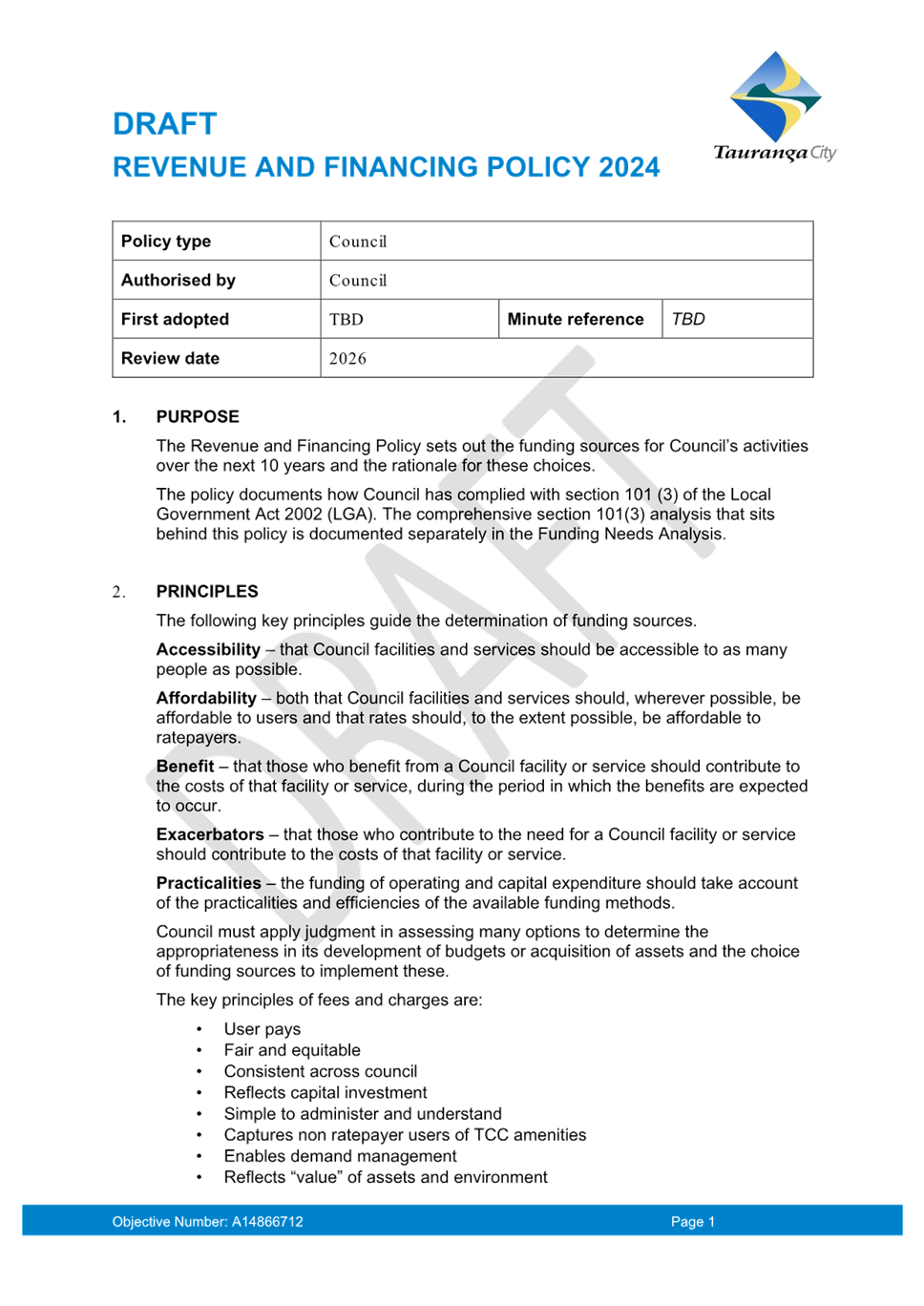





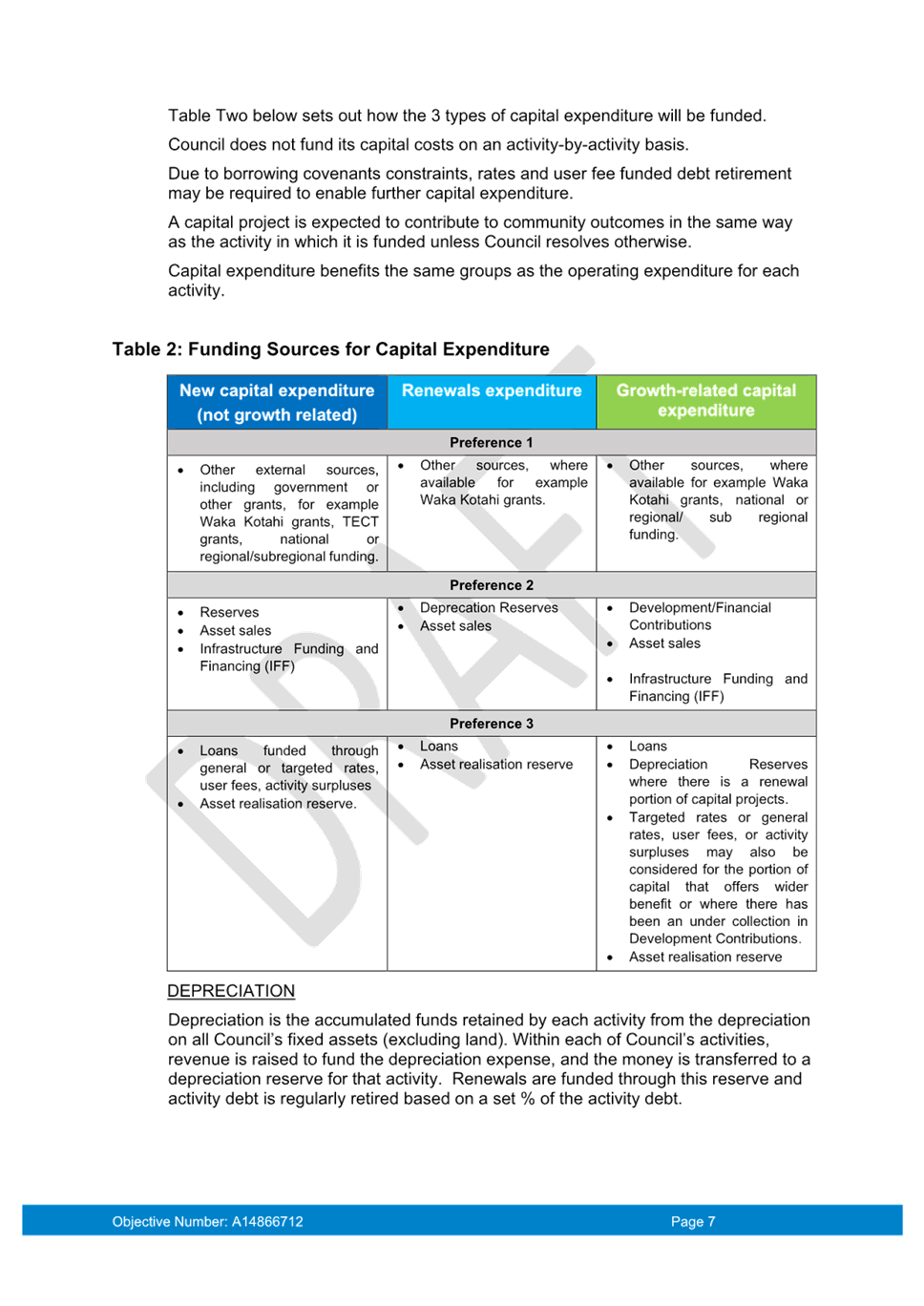

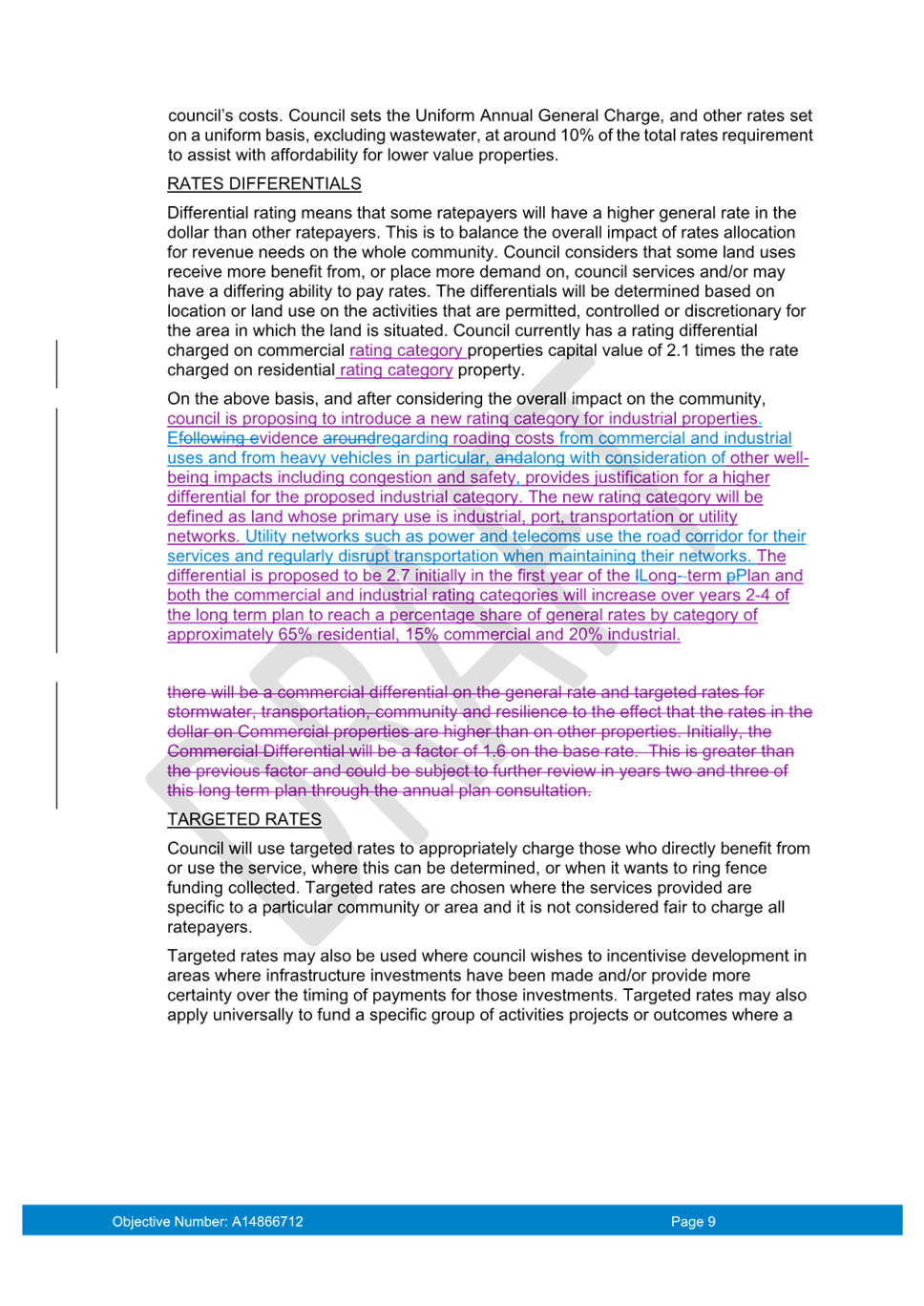

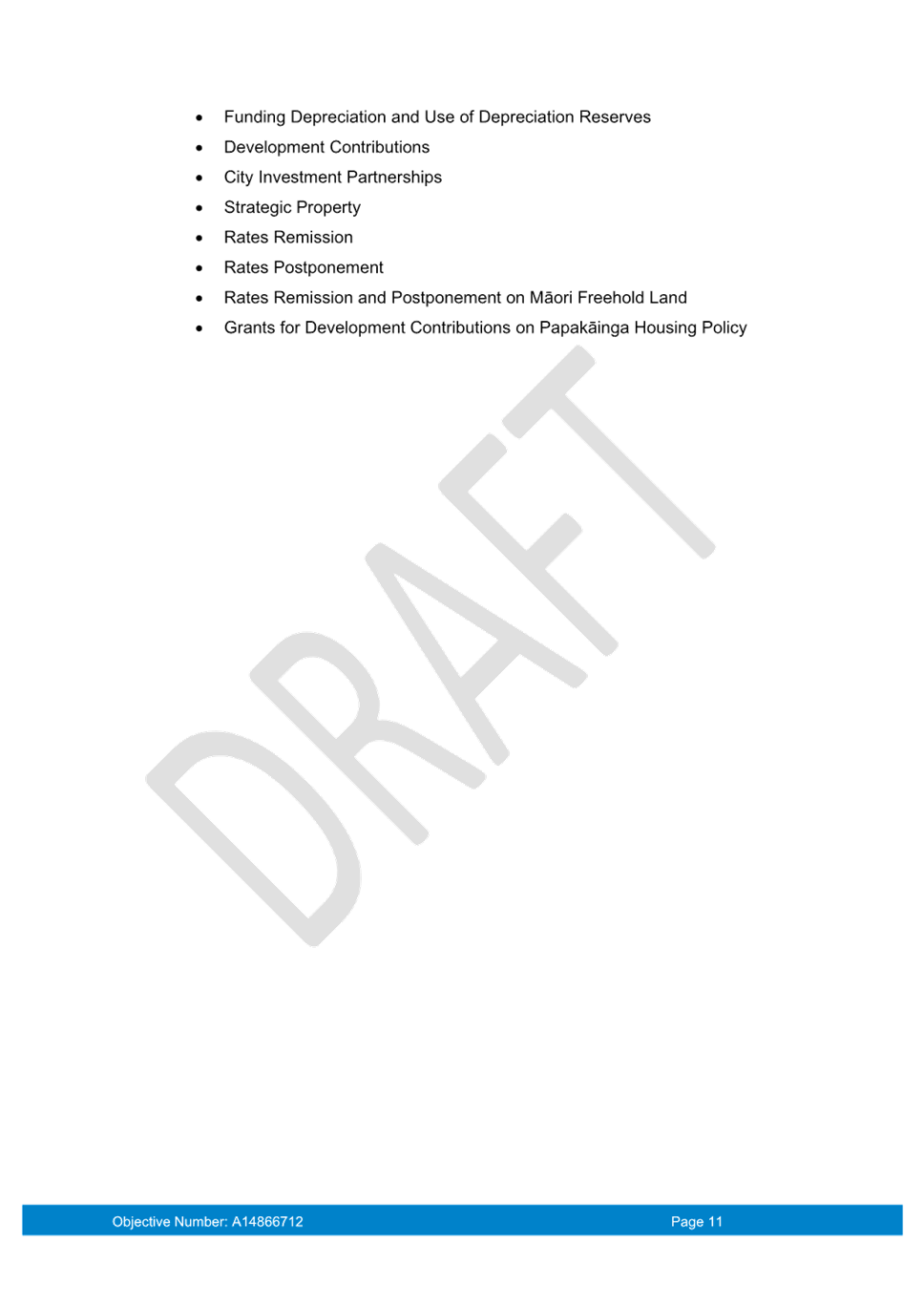
|
Ordinary
Council meeting Agenda
|
11
September 2023
|
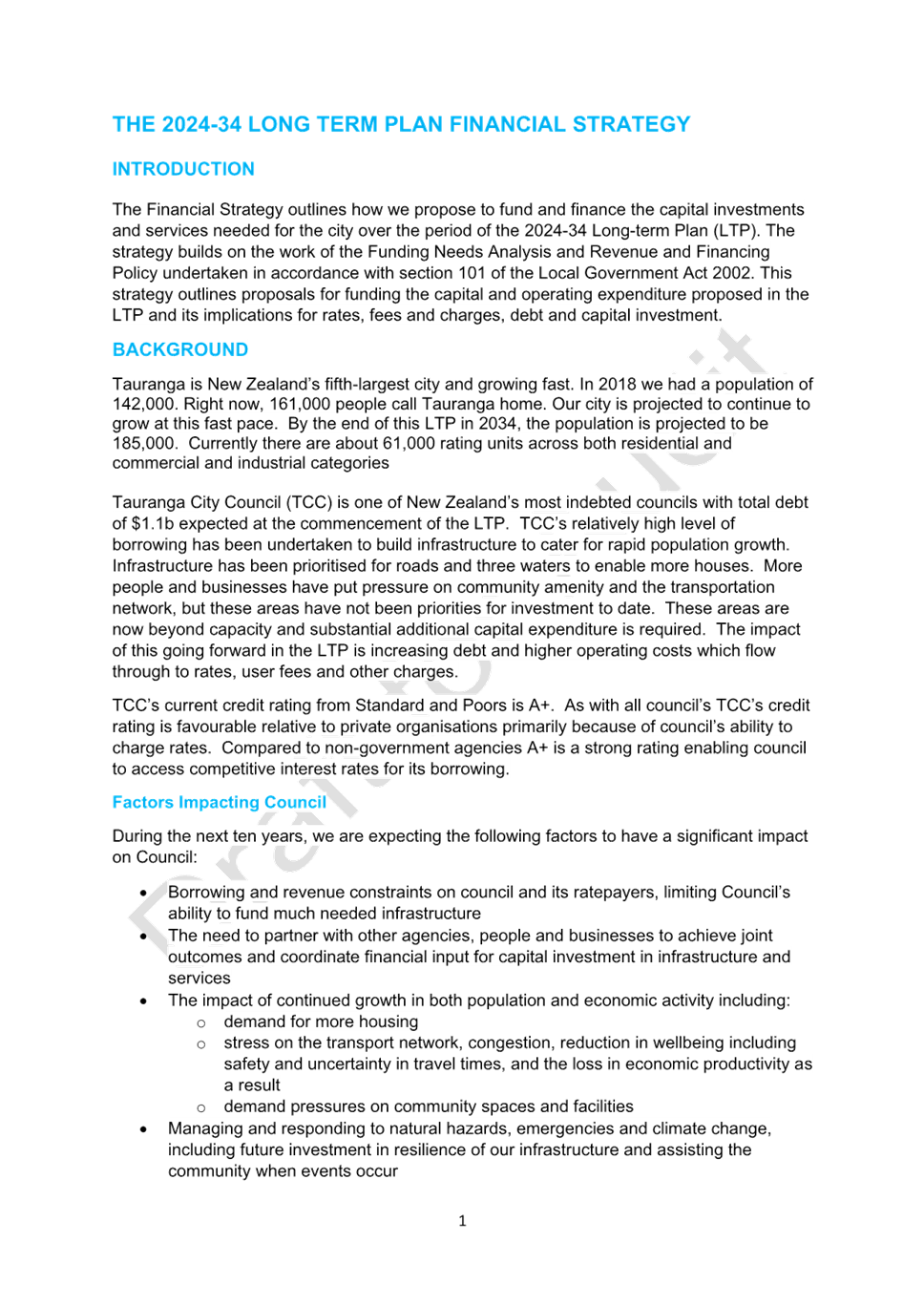
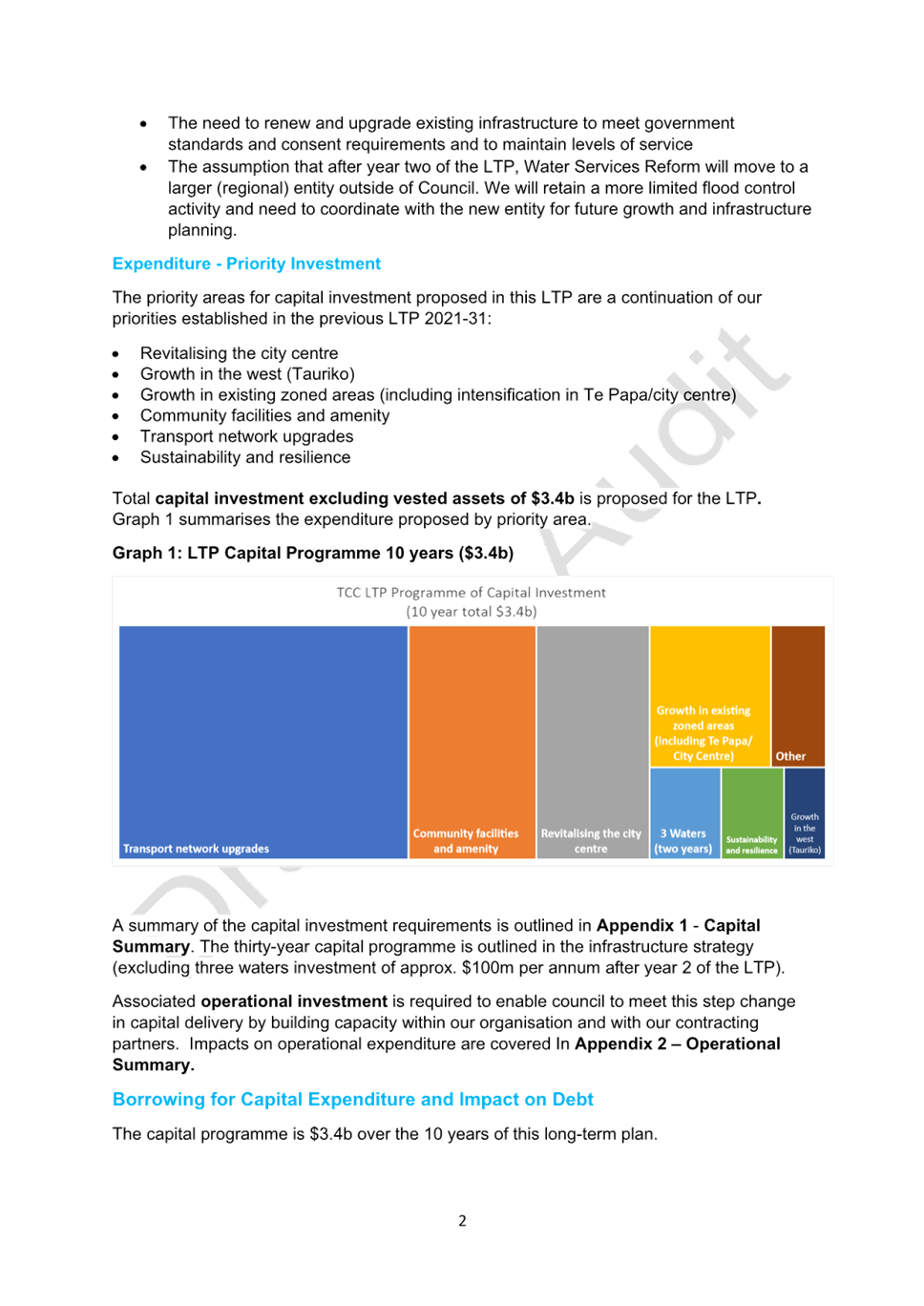
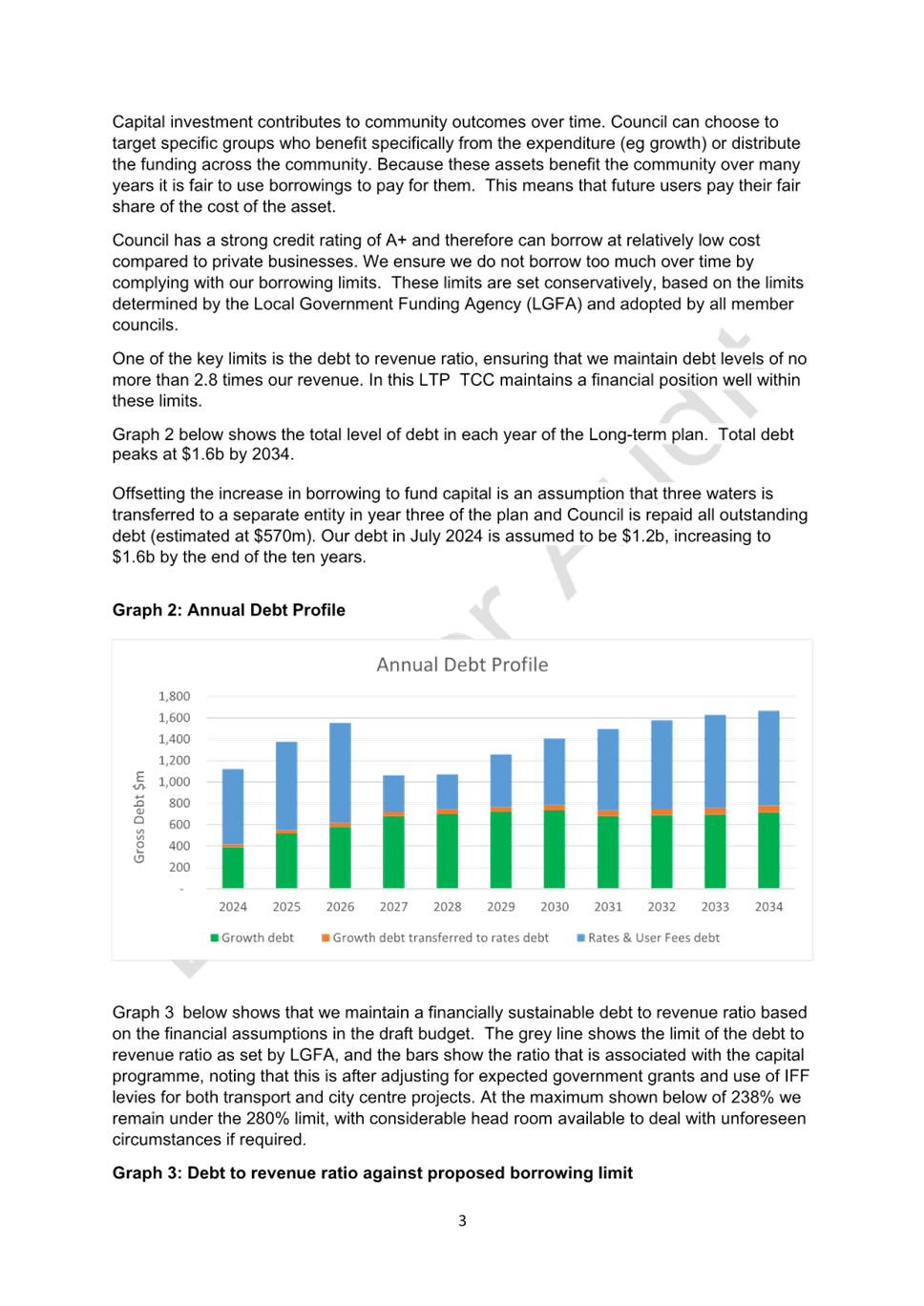

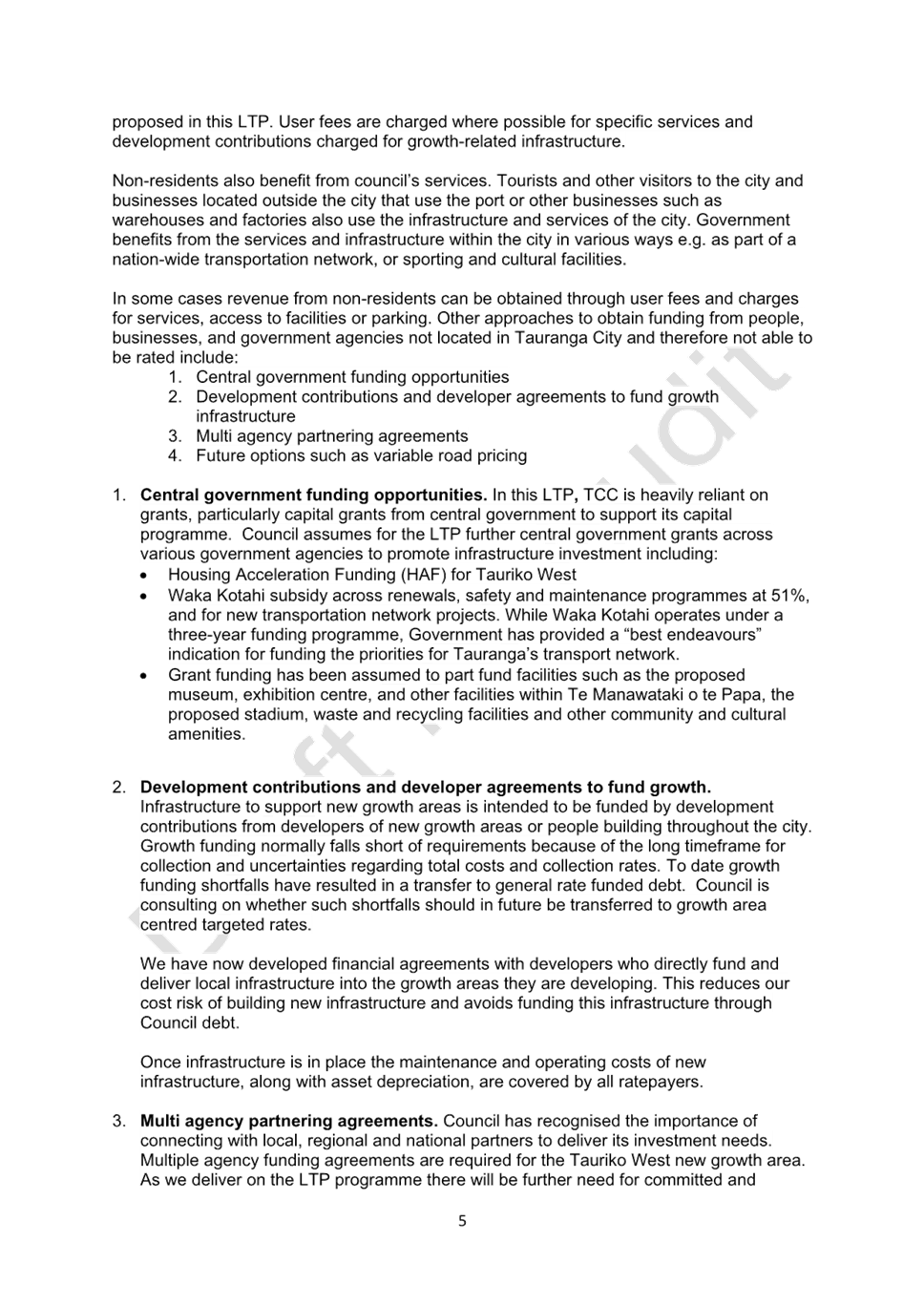
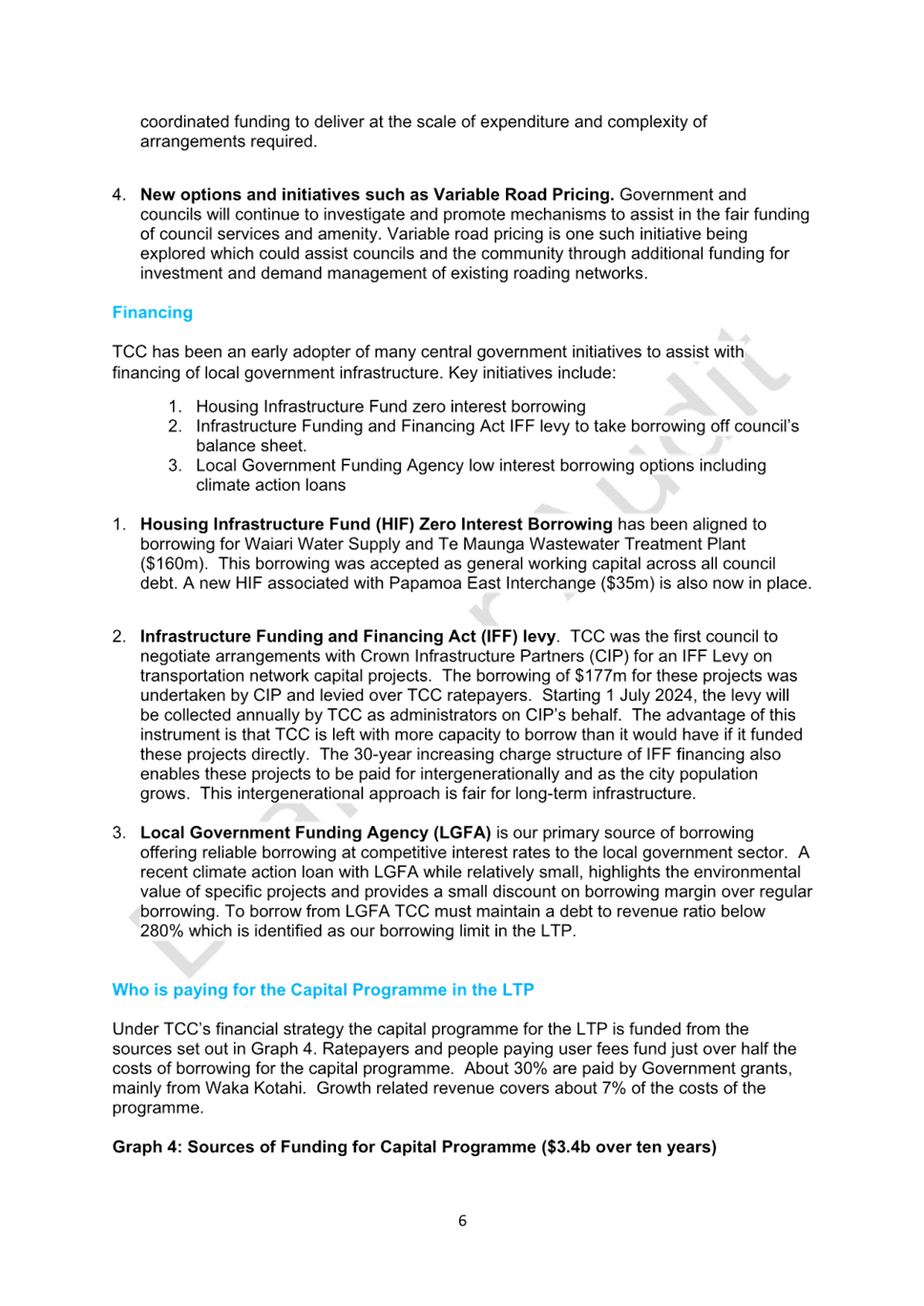
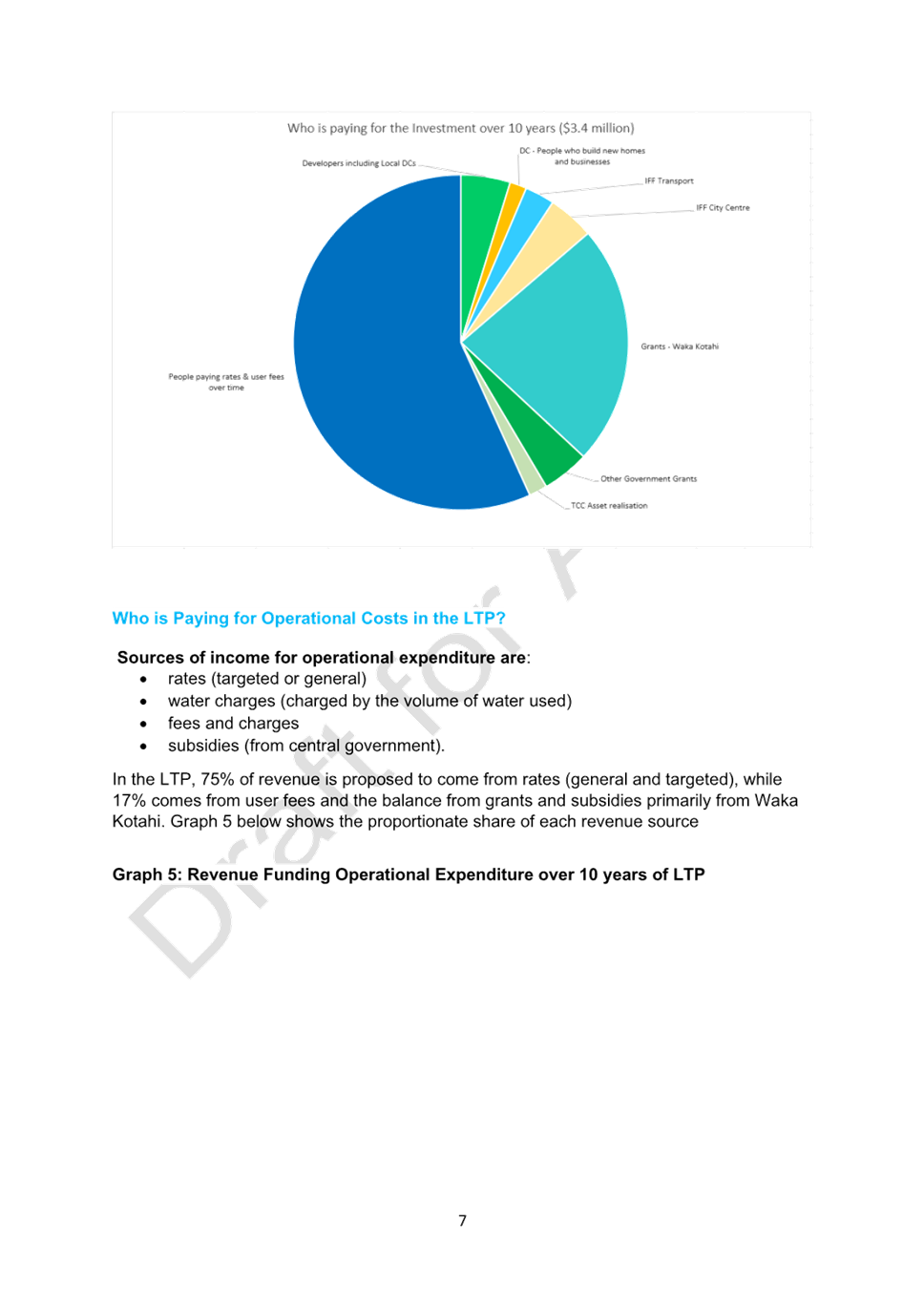
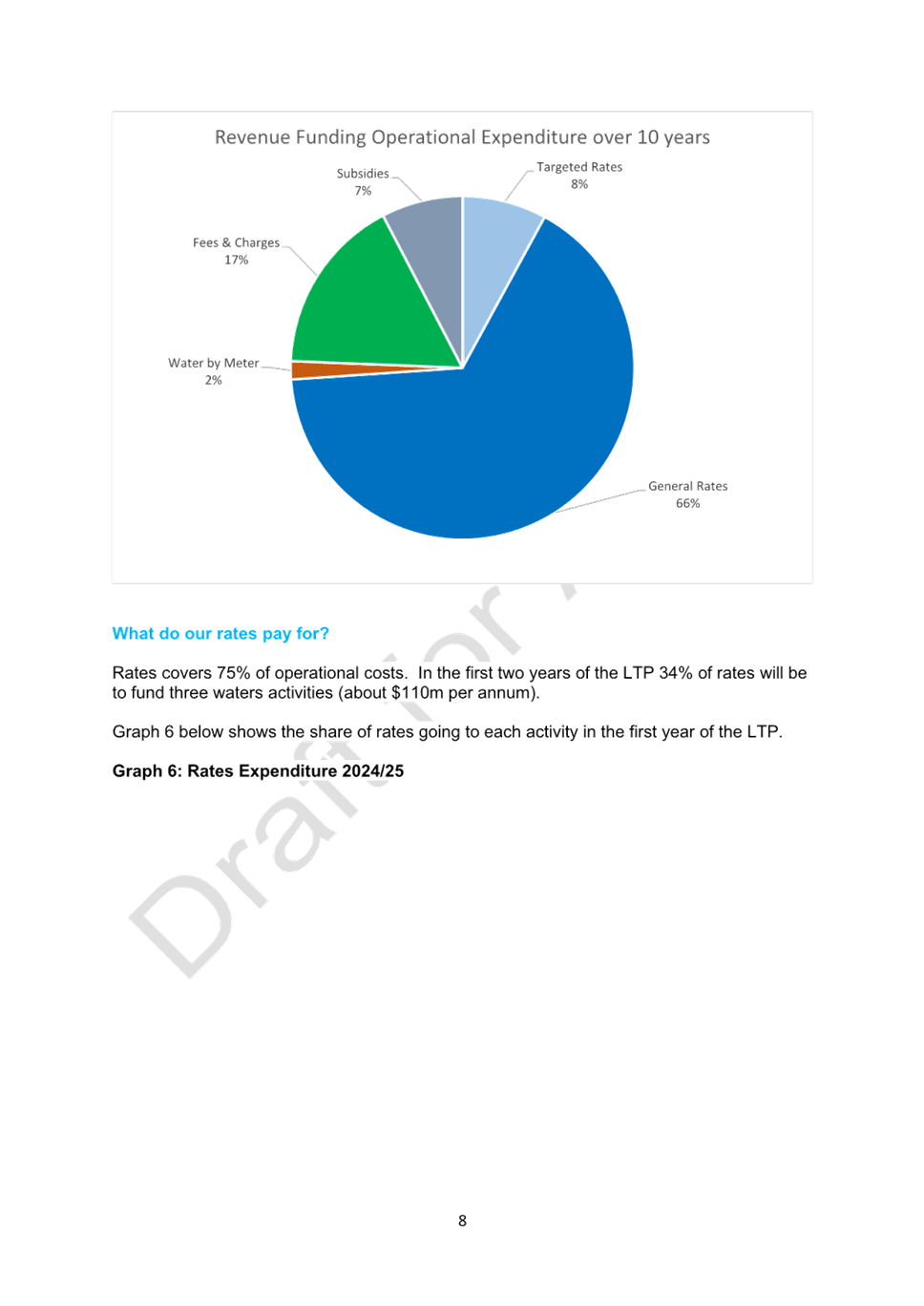
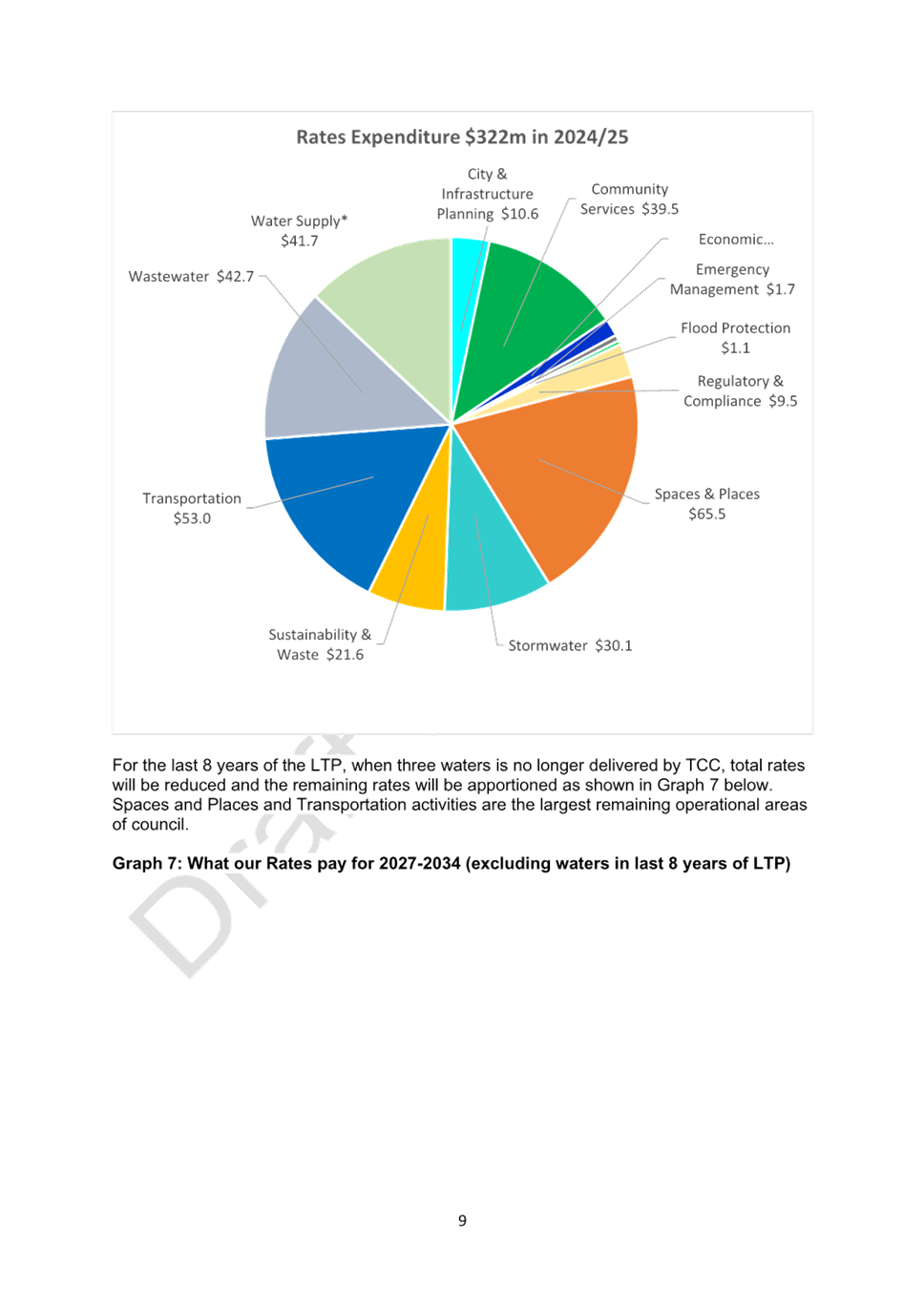
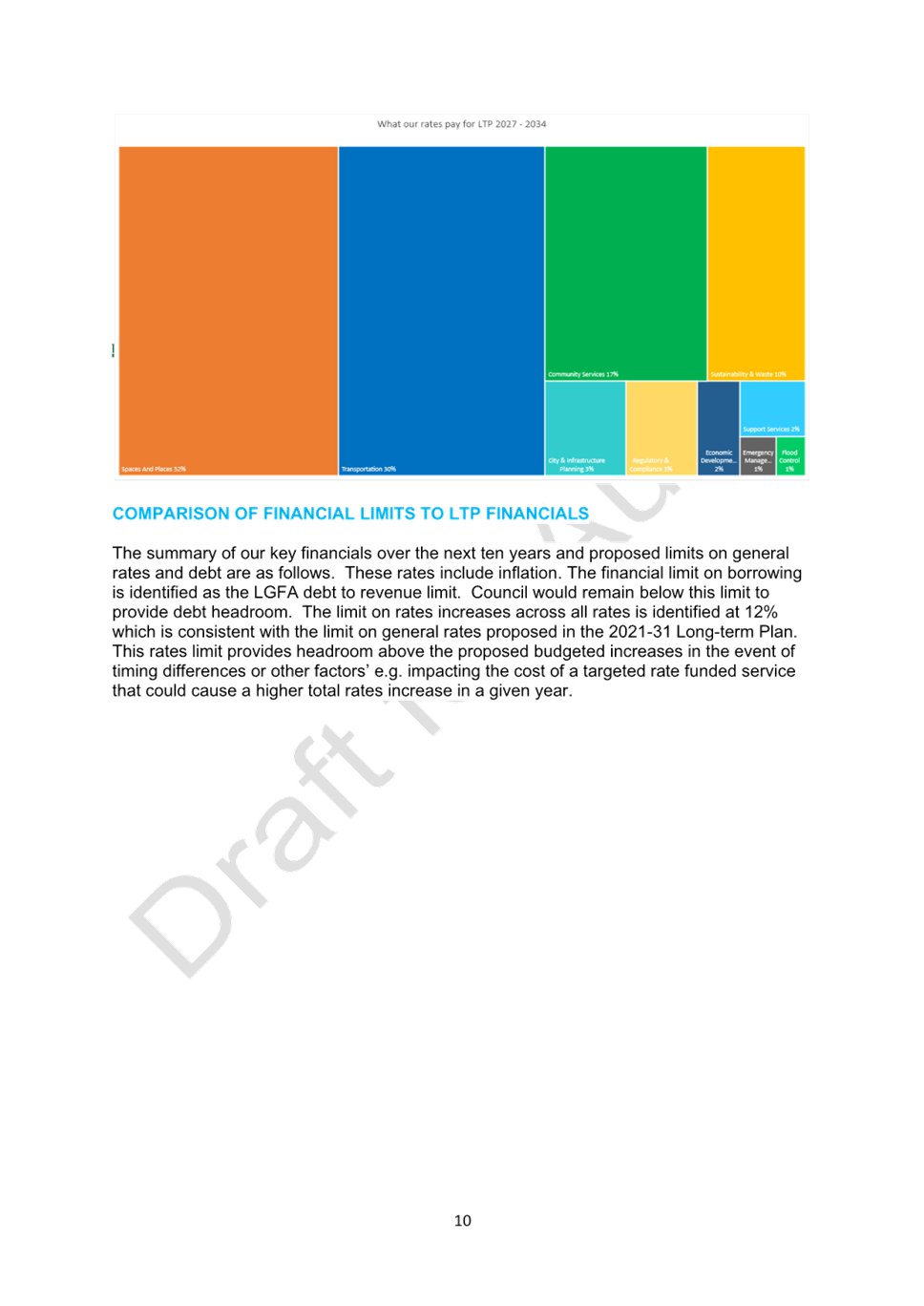
|
Ordinary
Council meeting Agenda
|
11
September 2023
|
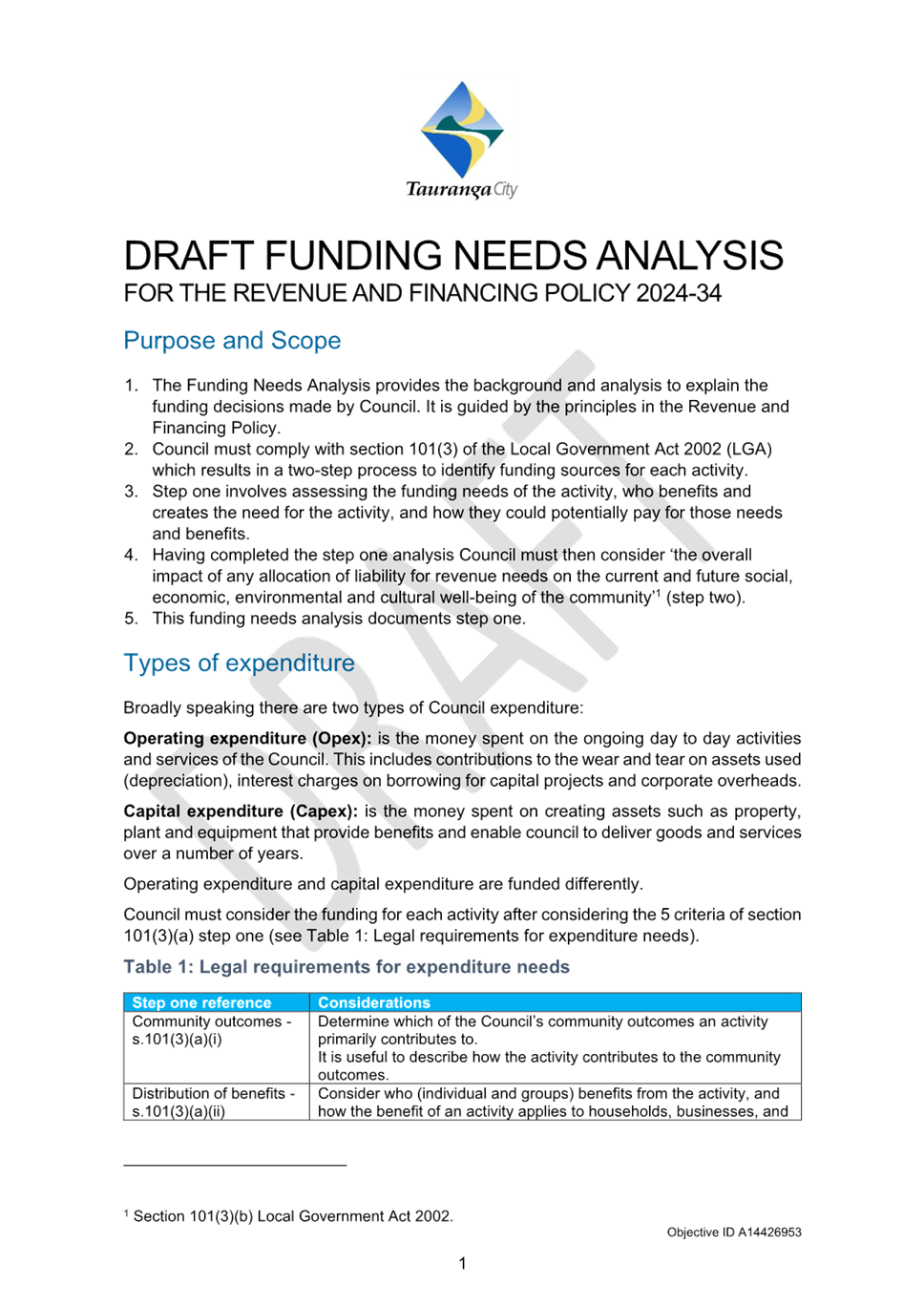


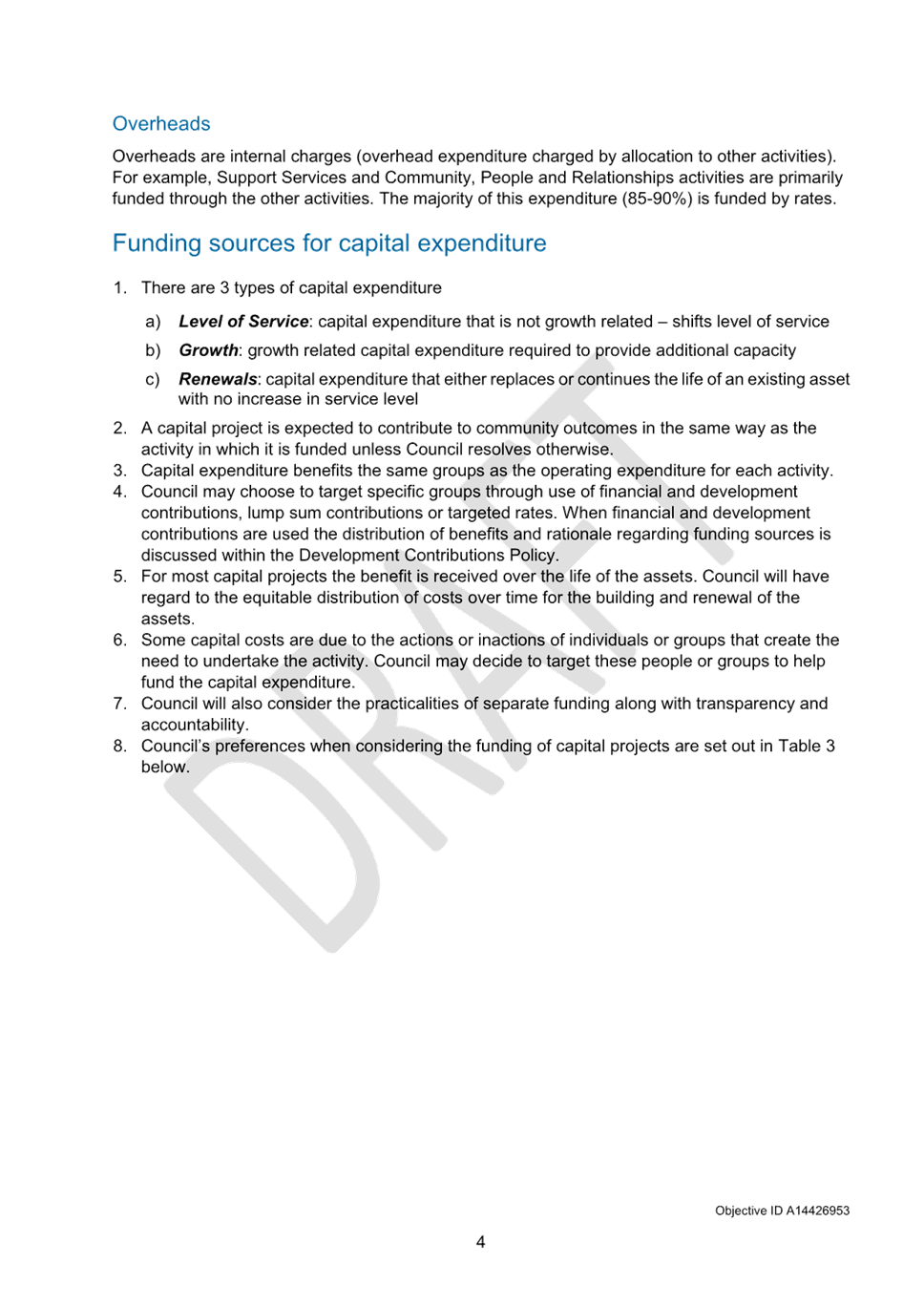
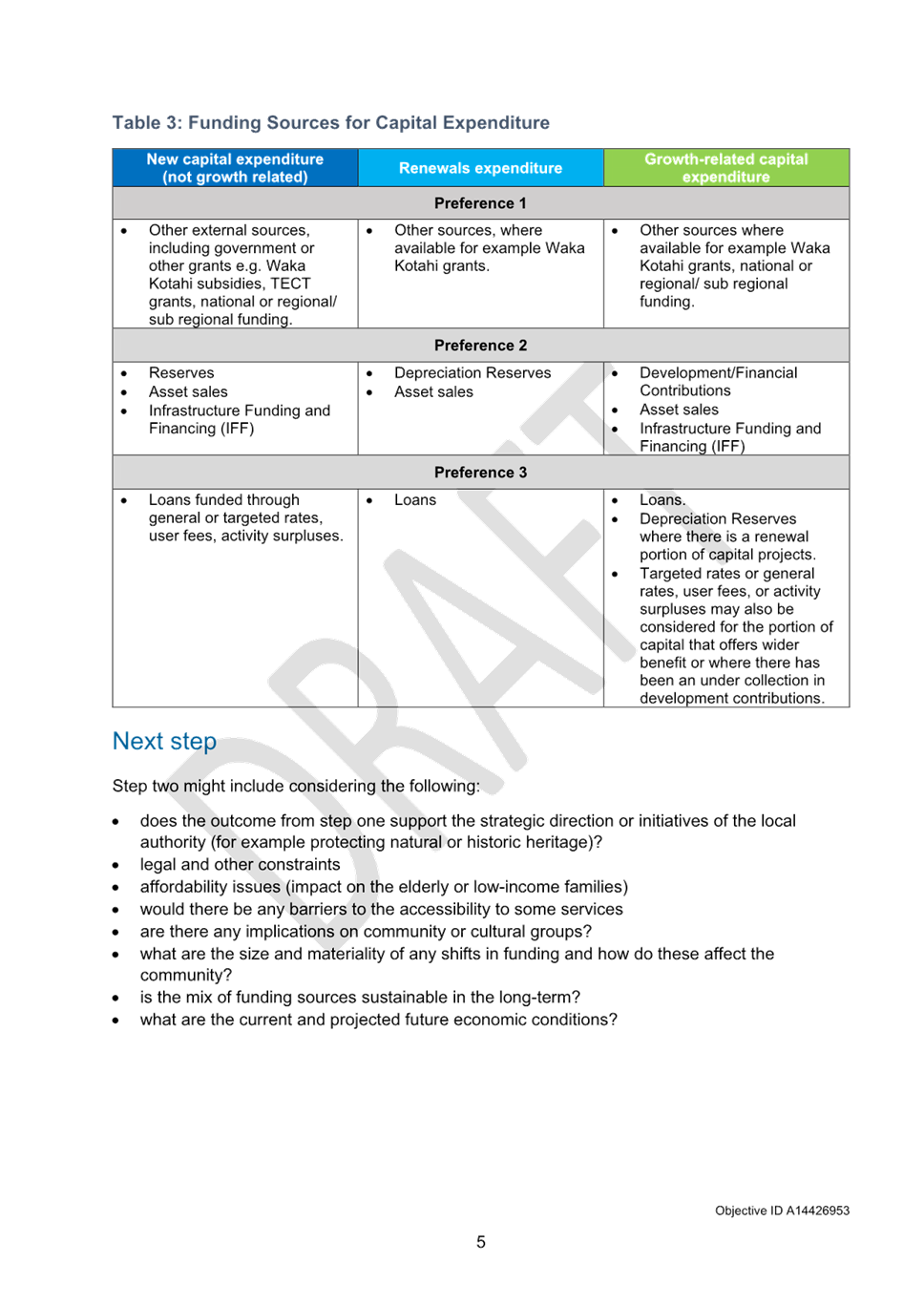
|
Ordinary
Council meeting Agenda
|
11
September 2023
|

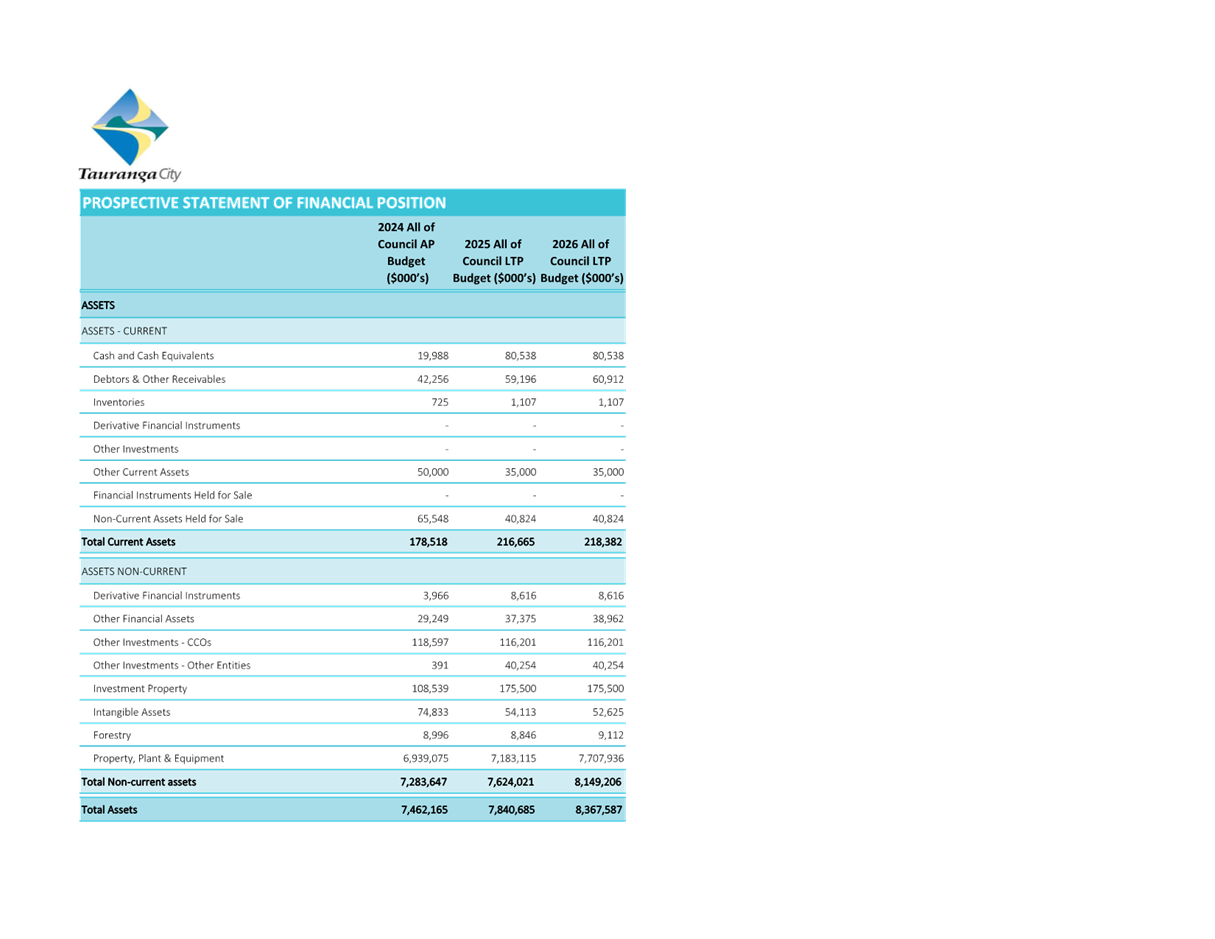
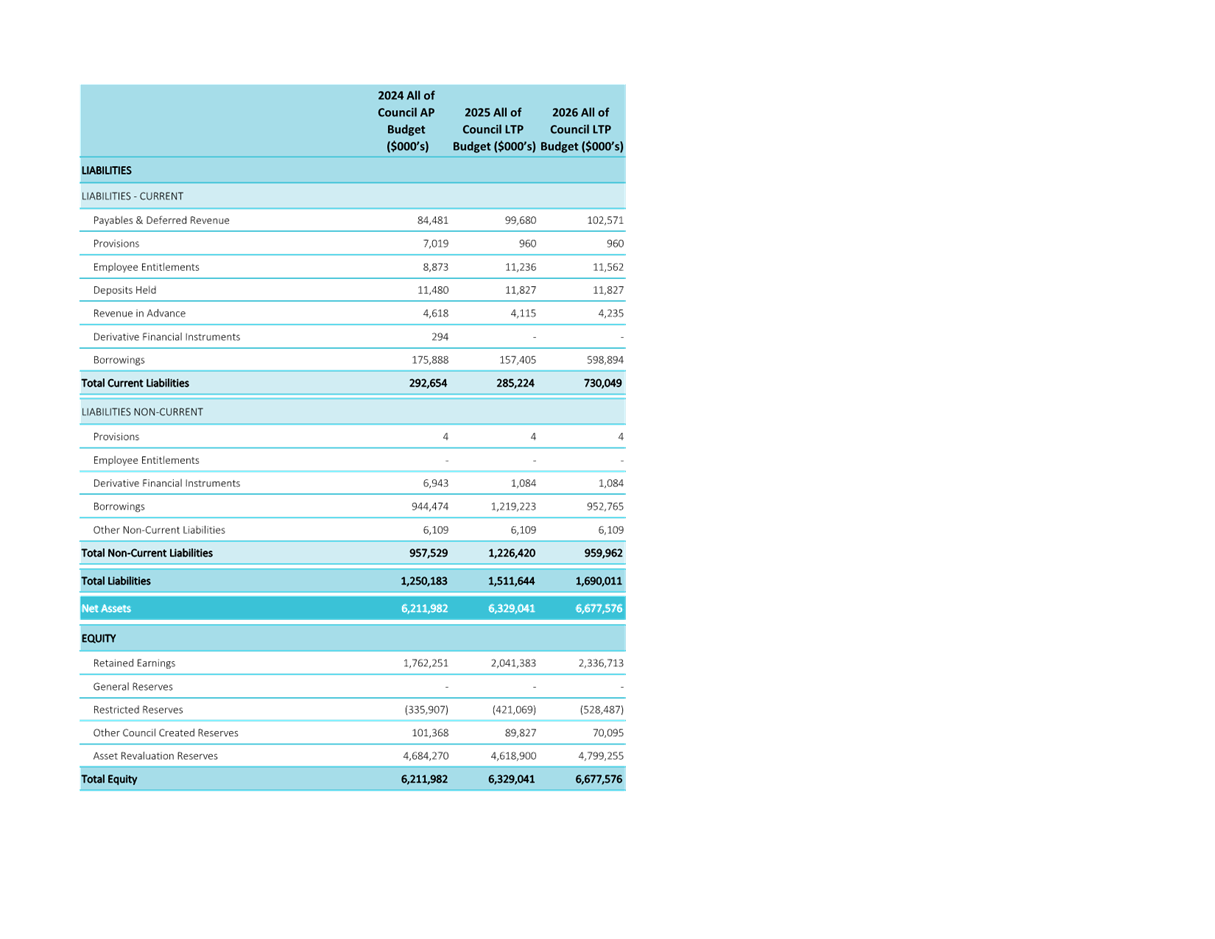

|
Ordinary
Council meeting Agenda
|
11
September 2023
|
11.8 2024-2034
- Long-term Plan - Adoption for Audit of draft Long-term Plan Consultation
Document
File
Number: A14990176
Author: Josh
Logan, Team Leader: Corporate Planning
Authoriser: Christine
Jones, General Manager: Strategy, Growth & Governance
Purpose of the Report
1. To gain approval to provide the draft 2024-34 Long-term
Plan Consultation Document to Audit NZ.
|
Recommendations
That the Council:
(a) Receives the report
"2024-2034 - Long-term Plan - Adoption for Audit of draft Long-term Plan
Consultation Document".
(b) Approves the draft 2024-34 Long-term Plan Consultation
Document (Attachment 1) for the purposes of submitting it to
Audit New Zealand for the audit process with amendments to reflect the
decisions made at this 11 September Council meeting with respect to the
following reports:
(i) Draft User Fees and
Charges Schedule for the Draft 2024-2034 Long Term Plan
(ii) Mount Maunganui
Parking Strategy
(iii) Papamoa East / Wairakei /
Te Tumu Investments Strategic Considerations and Funding Approaches.
(c) Delegates
authority to the Chief Executive to make editorial amendments to the draft
2024-34 Long-term Plan Consultation Document, if required, prior to it being
submitted to Audit New Zealand.
(d) Notes
the final version of the 2024-34 Long-term Plan Consultation Document,
following any amendments required by Audit New Zealand and for graphic design
purposes, will be provided to Council for its approval at the meeting in
early November 2023.
|
Executive Summary
2. This paper recommends
adoption of the draft consultation document for the 2024-34 Long-term Plan
(LTP), to enable it to be audited. This is a key step in progressing towards
the eventual adoption of the 2024-34 Long-term Plan.
3. The
consultation document has been prepared based on guidance received from
Commissioners at the previous two Long-term Plan workshops in June and July and
through Council decisions throughout 2023. It presents information from other
key supporting LTP documents, such as the Infrastructure Strategy. The purpose
of the consultation document is to provide key information to our communities,
and to encourage them to share their views on the most significant issues and
choices facing Council, allowing their views to be considered in the LTP decision
making process.
4. The results of the
audit of the consultation document will be provided to Council in early
November 2023, at which time Council will be requested to approve the document
for consultation. Council will receive public
submissions between 15 November 2023 to 15 December 2023, and hold hearing and deliberations in February and March
2024, before adopting the final LTP.
Background
5. The purpose of a LTP is to:
(a) describe the activities of the local
authority; and
(b) describe the community outcomes of the
local authority’s district; and
(c) provide integrated decision-making and
co-ordination of the resources of the local authority; and
(d) provide a long-term focus for the
decisions and activities of the local authority; and
(e) provide a basis for accountability of
the local authority to the community[7].
6. An LTP is prepared every
three years, covers ten years (and includes an infrastructure strategy that
covers 30 years), must include specific information described in the Local
Government Act 2002, must be audited, and can only be adopted after a period of
public consultation on a consultation document which itself also needs to be
audited[8].
7. The consultation
document is an important milestone in the development of the 2024-34 Long-term
Plan. It sets out our broad direction over the next ten years, with a focus on
the next three, how much that will cost, and the effects we will achieve. It
asks the public to provide their views on key issues facing Council. It is the legal
basis for consultation on the Long-term Plan and must be audited by Audit New
Zealand.
Strategic / Statutory Context
8. Council is required
to have a LTP under section 93 of the Local Government Act (LGA). As part of
this, it is required to utilise the Special Consultative Procedure, which at
s93(c)(4) requires audit of the draft Consultation Document.
Draft
Consultation Document
9. The
consultation document for an LTP must be presented in as concise and simple a
manner as possible, while still achieving its purpose. It must not be a draft
LTP and must not include a full version of any of the draft supporting
documents. It must clearly show to affected communities, using graphs and
charts where appropriate, what is changing, with a particular focus on rates
and debt levels.
10. Council
must include a preferred option for any topic on which it is seeking community
views and cost its budget to that option. Commissioners will be asked to adopt
the consultation document only after having adopted all the supporting
information.
Options Analysis
11. There
are two options for consideration:
Option 1: Council adopts the draft consultation
document for submission to Audit NZ for formal audit.
12. Council
approves the draft consultation document as proposed in Attachment 1.
|
Advantages
|
Disadvantages
|
|
· Keeps within the
current timeframes.
|
· Potential
opportunities for amendments to the consultation document may not have been
considered.
|
|
Recommended?
|
Yes
|
|
|
|
Option 2: Council does not
adopt the draft consultation document for submission to Audit NZ for
formal audit.
13. Council
does not approve the draft consultation document as proposed in Attachment 1.
|
Advantages
|
Disadvantages
|
|
· Potential
opportunities for consultation document to be amended and reconsidered.
|
· Delay in
adopting the consultation document (depending on the duration) may delay
preparation of the LTP.
|
|
Recommended?
|
No
|
|
|
|
Financial Considerations
14. There are no specific costs
associated with option one, however pursuing option two could lead to time
delays as processes and decision-making may need to be revisited.
Legal Implications / Risks
15. Legislative issues are
considered in the Background and Strategic/Statutory Context sections to this
report.
Consultation / Engagement
16. The
draft 2024-34 LTP Consultation Document is scheduled to be adopted in early
November 2023. After that adoption it will be consulted on with the community
between 15 November and 15 December 2023, using the special consultative
procedure outlined in section 93A of the LGA.
Significance
17. The LGA requires an assessment
of the significance of matters, issues, proposals and decisions in this report
against Council’s Significance and Engagement Policy. Council
acknowledges that in some instances a matter, issue, proposal or decision may
have a high degree of importance to individuals, groups, or agencies affected
by the report.
18. In making this assessment,
consideration has been given to the likely impact, and likely consequences for:
(a) the current
and future social, economic, environmental, or cultural well-being of the
district or region
(b) any persons who are likely to be
particularly affected by, or interested in, the issue, proposal, decision, or
matter
(c) the capacity of the local authority to
perform its role, and the financial and other costs of doing so.
19. In accordance with the
considerations above, criteria and thresholds in the policy, it is considered
that the LTP and its contents is of high significance. However, this
decision is considered to be of low significance.
ENGAGEMENT
20. Taking into consideration the
above assessment, that the decision is of low significance, and the draft
consultation document is scheduled to be adopted along with supporting
documentation in early November 2023, no further engagement is necessary at
this preliminary stage. After that adoption in early November, consultation
will occur with the community in accordance with section 93A of the LGA.
Next Steps
21. If
Council approves the recommendations of this report, the draft consultation
document will be provided to Audit New Zealand for their audit.
22. Once that audit is completed,
the draft consultation document will be revised as necessary and presented to
Council for adoption in November 2023, along with the supporting documentation
and Statement of Proposal for Fees and Charges. If adopted, the Consultation
Document, supporting documentation and the Fees and Charges Statement of
Proposal will be used for the Special Consultative Procedure required by the
LGA. Council decision making may require further
changes through this process.
Attachments
1. 2024-34
LTP Consultation Document - Draft for Audit_PDF - A15005039 (Separate
Attachments 2) 
|
Ordinary
Council meeting Agenda
|
11
September 2023
|
13 Public
excluded session
Resolution to exclude
the public
|
Recommendations
That the public be
excluded from the following parts of the proceedings of this meeting.
The general subject
matter of each matter to be considered while the public is excluded, the
reason for passing this resolution in relation to each matter, and the
specific grounds under section 48 of the Local Government Official
Information and Meetings Act 1987 for the passing of this resolution are as
follows:
|
General subject of each matter to be
considered
|
Reason for passing this resolution in
relation to each matter
|
Ground(s) under section 48 for the
passing of this resolution
|
|
13.1 - Papamoa East Interchange
– Contract Award
|
s7(2)(h) - The withholding of the information is
necessary to enable Council to carry out, without prejudice or
disadvantage, commercial activities
s7(2)(i) - The withholding of the information is
necessary to enable Council to carry on, without prejudice or disadvantage,
negotiations (including commercial and industrial negotiations)
|
s48(1)(a) - the public conduct of the relevant
part of the proceedings of the meeting would be likely to result in the
disclosure of information for which good reason for withholding would exist
under section 6 or section 7
|
|
13.2 - Opal Dr Wastewater Pump Station
Budget Approval
|
s7(2)(b)(ii) - The withholding of the information
is necessary to protect information where the making available of the
information would be likely unreasonably to prejudice the commercial
position of the person who supplied or who is the subject of the
information
s7(2)(h) - The withholding of the information is
necessary to enable Council to carry out, without prejudice or
disadvantage, commercial activities
s7(2)(i) - The withholding of the information is
necessary to enable Council to carry on, without prejudice or disadvantage,
negotiations (including commercial and industrial negotiations)
|
s48(1)(a) - the public conduct of the relevant
part of the proceedings of the meeting would be likely to result in the
disclosure of information for which good reason for withholding would exist
under section 6 or section 7
|
|
13.3 - Infrastructure Funding and
Financing Act (IFFA) for funding Te Manawataki o Te Papa - Adoption of
Consultation Document
|
s7(2)(i) - The withholding of the information is
necessary to enable Council to carry on, without prejudice or disadvantage,
negotiations (including commercial and industrial negotiations)
|
s48(1)(a) - the public conduct of the relevant
part of the proceedings of the meeting would be likely to result in the
disclosure of information for which good reason for withholding would exist
under section 6 or section 7
|
|
Confidential Attachment 1 - 11.6 -
Papamoa East / Wairakei / Te Tumu Investments: Strategic Considerations and
Funding Approaches
|
s7(2)(b)(ii) - The withholding of the information
is necessary to protect information where the making available of the
information would be likely unreasonably to prejudice the commercial
position of the person who supplied or who is the subject of the
information
|
s48(1)(a) the public conduct of the relevant part
of the proceedings of the meeting would be likely to result in the
disclosure of information for which good reason for withholding would exist
under section 6 or section 7
|
|
Confidential Attachment 2 - 11.6 -
Papamoa East / Wairakei / Te Tumu Investments: Strategic Considerations and
Funding Approaches
|
s7(2)(b)(ii) - The withholding of the information
is necessary to protect information where the making available of the
information would be likely unreasonably to prejudice the commercial
position of the person who supplied or who is the subject of the
information
|
s48(1)(a) the public conduct of the relevant part
of the proceedings of the meeting would be likely to result in the
disclosure of information for which good reason for withholding would exist
under section 6 or section 7
|
|
Confidential Attachment 3 - 11.6 -
Papamoa East / Wairakei / Te Tumu Investments: Strategic Considerations and
Funding Approaches
|
s7(2)(g) - The withholding of the information is
necessary to maintain legal professional privilege
|
s48(1)(a) the public conduct of the relevant part
of the proceedings of the meeting would be likely to result in the
disclosure of information for which good reason for withholding would exist
under section 6 or section 7
|
|
Confidential Attachment 5 - 11.6 - Papamoa
East / Wairakei / Te Tumu Investments: Strategic Considerations and Funding
Approaches
|
s7(2)(i) - The withholding of the information is
necessary to enable Council to carry on, without prejudice or disadvantage,
negotiations (including commercial and industrial negotiations)
|
s48(1)(a) the public conduct of the relevant part
of the proceedings of the meeting would be likely to result in the
disclosure of information for which good reason for withholding would exist
under section 6 or section 7
|
|
|
Ordinary
Council meeting Agenda
|
11
September 2023
|
14 Closing
karakia

































